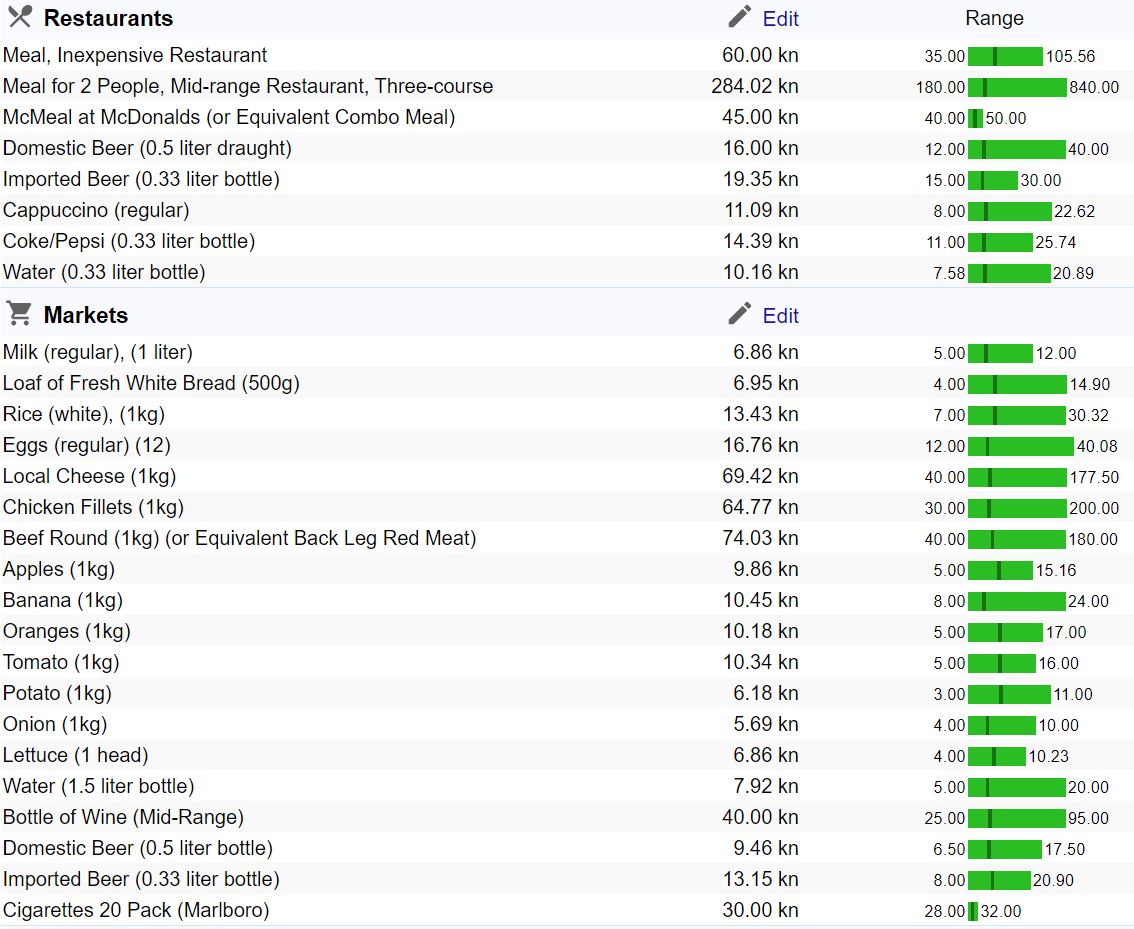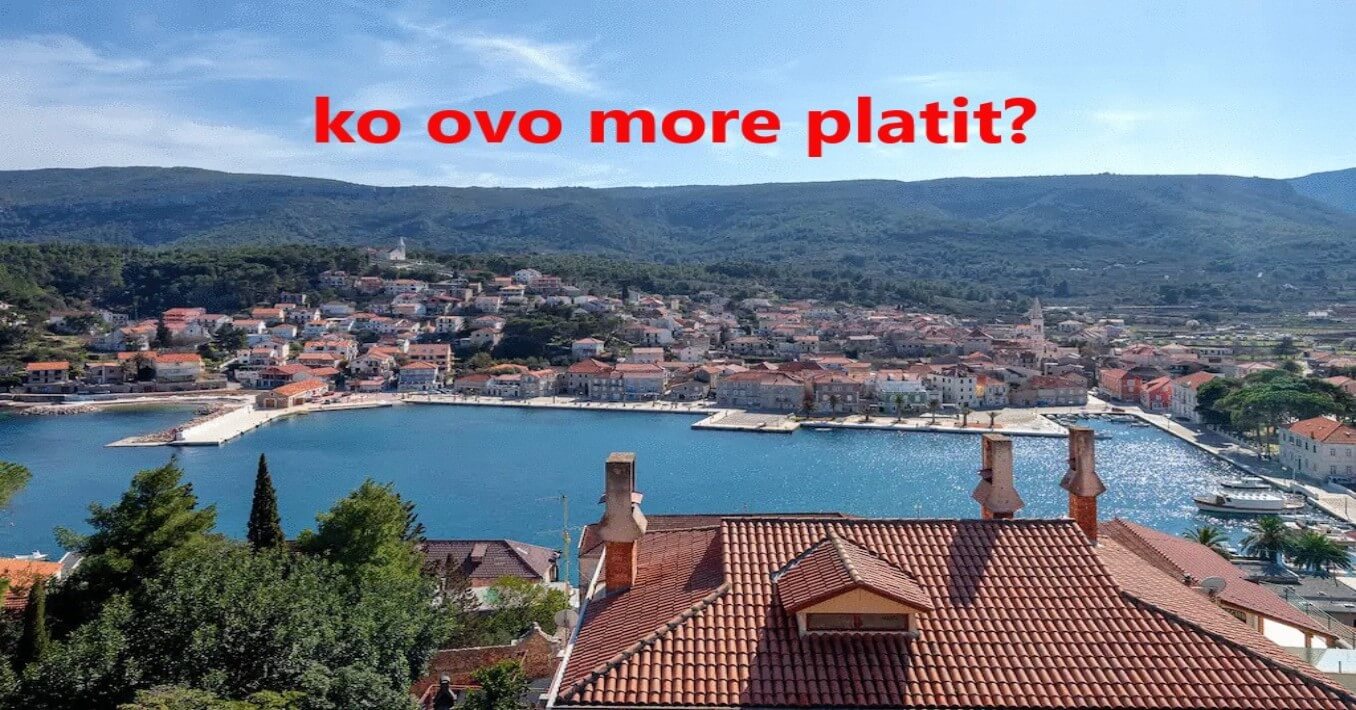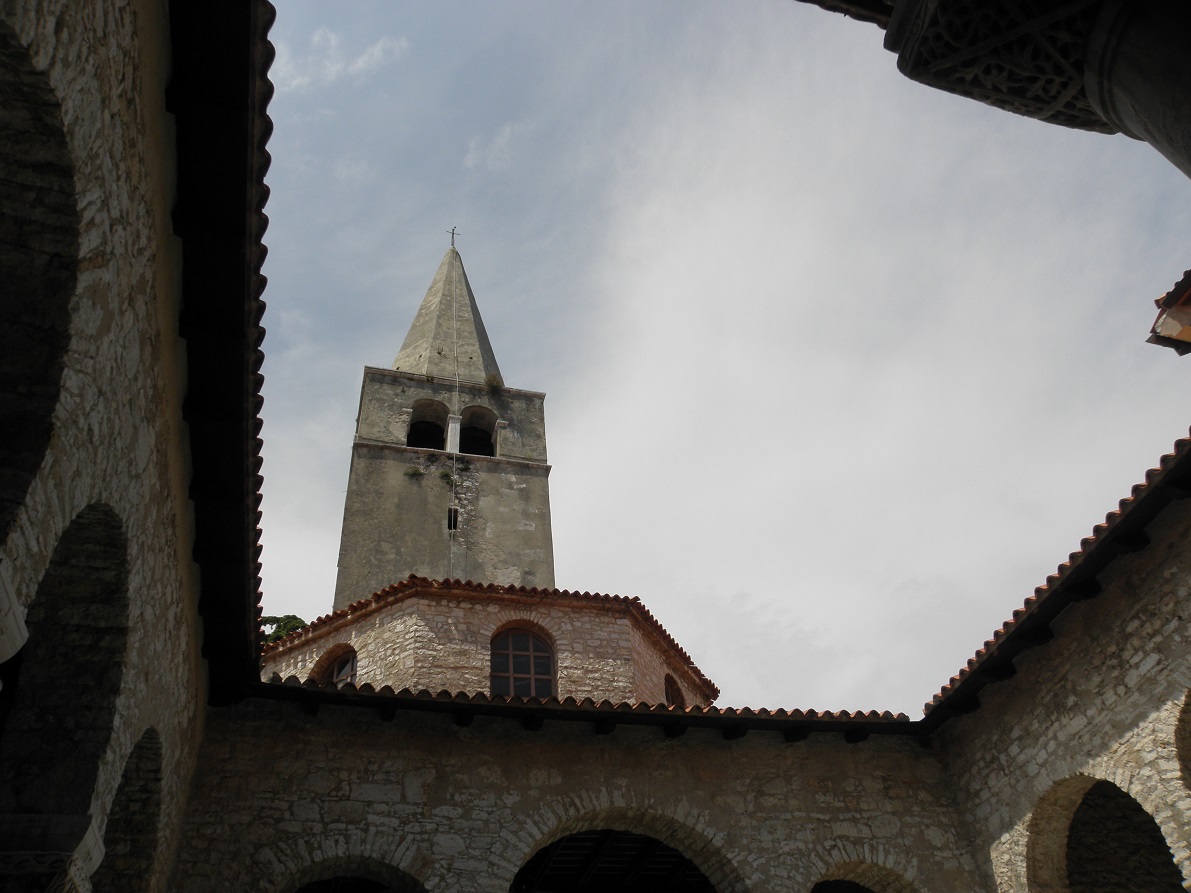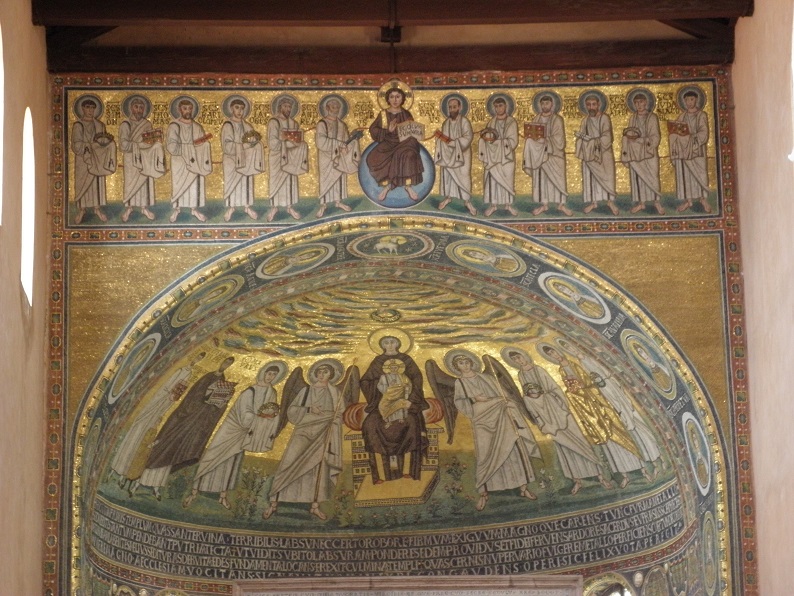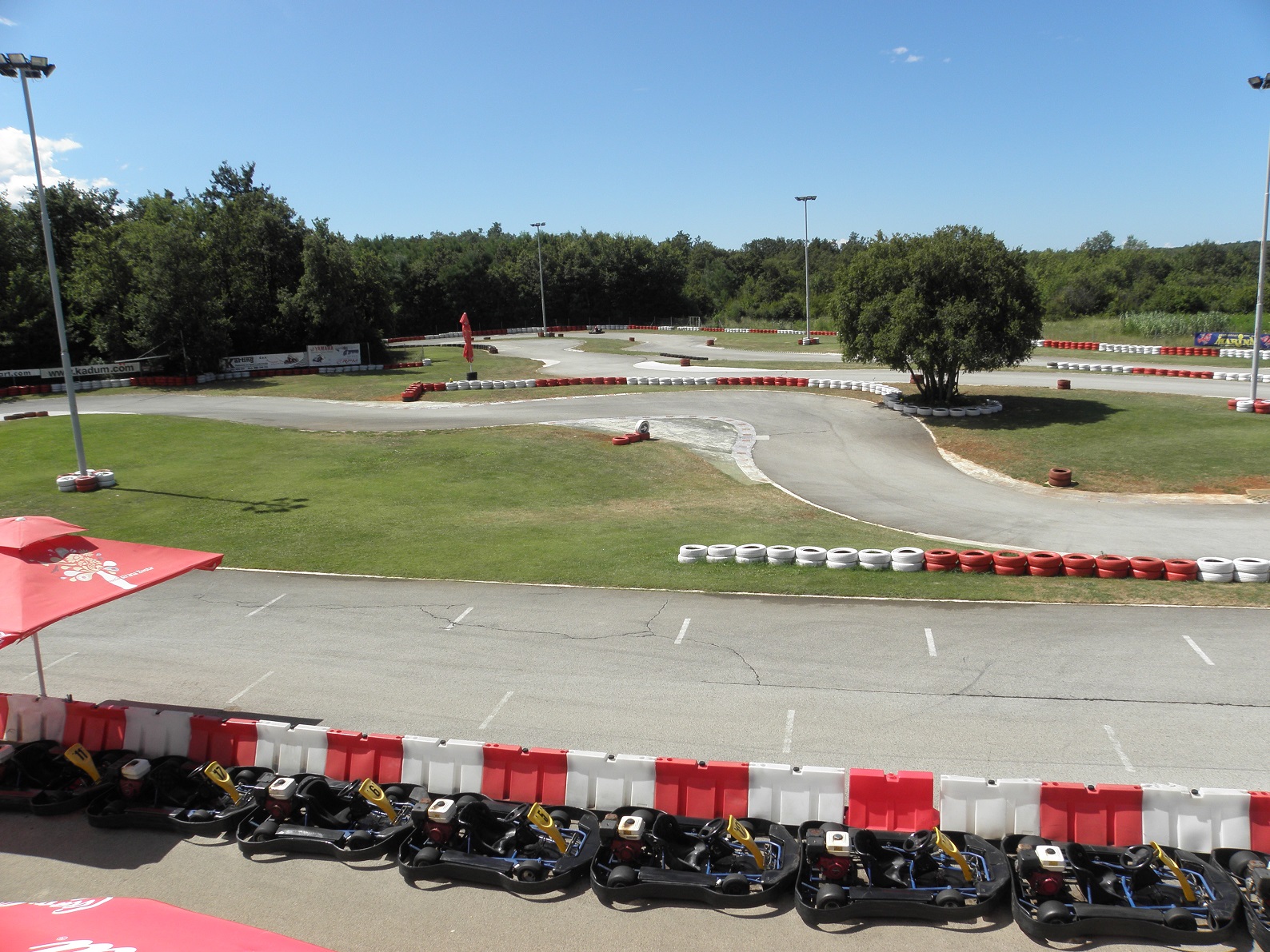People Also Ask Google: How Far is Porec from Other Parts of Croatia?
March 2, 2021 – You've found yourself in Croatia, you've heard about Porec being an exciting town in Istria, and now you want to seize the opportunity to visit it? In our People Also Ask Google series, we explain how far is Porec from other parts of Croatia.
Although beautiful in all areas, Croatia is a country with an extremely unusual shape, making it difficult to travel from one part to another (for example, from Osijek to Dubrovnik). The long and very indented coast on the Adriatic Sea hides some of the most beautiful seascapes. Due to its specific position and numerous bays and islands, it is impossible to explore it in one fell swoop.
The largest peninsula in Croatia – Istria – is located in the north of the Croatian Adriatic coast and hides many natural and cultural sights in the west part of Croatia, where also lays Croatia's westernmost point – Savudrija. If in Croatia, it would be a shame if one does not take the opportunity and visit Istria. Cities on the west coast of Istria, such as Rovinj, Poreč, and Pula, have been attracting tourists' attention for years because of their proximity and excellent connections with Central Europe and its irresistible cultural heritage that makes them interesting destinations worth exploring.
We recently described whether Porec is worth visiting, and in this article, we will try to explain how far Porec is from other parts of Croatia and how to reach this one of the many Istrian gems easily.
However, if you are interested in how to get to Istria from Italy or Slovenia by car, bus, train, plane, or ferry, you can find all the information in the TCN's special guide.
How far is Porec from the airport?
Pula Airport – If coming by plane to Croatia, Pula Airport is the closest to Poreč. The distance between Pula Airport and Poreč is about 58 kilometers, of which 42 kilometers is the Istrian highway (i.e., the Istrian Y). The bus drive from Pula Airport to Poreč takes an hour, while the car ride takes 45 minutes. However, you can also take the local road through Istria. Still, even though it is a slightly shorter distance (52 kilometers), your journey will take at least 15 minutes longer in ideal conditions. Before you choose a route, consider that local roads in Istria can be very crowded during the summer season.
There are shuttle bus lines from Pula Airport to the main Pula bus station, 30 minutes after the landing of the aircraft, from where you can take a bus to Poreč (as well as to other parts of Istria). The shuttlebus drive to Pula takes 10-15 minutes, and the ticket costs 30 kunas. You can check the Pula Airport shuttlebus schedule for 2021, as well as other shuttle bus services from Pula Airport.
From the main Pula bus station, you can easily take the bus to Poreč with services provided by Arriva, Flixbus, and others. The bus connection between Pula and Poreč is excellent, with many bus lines throughout the year and day, especially during the summer season.
If you decide to take a car ride from Pula Airport to Poreč, several rent-a-car businesses offer services at Pula Airport.
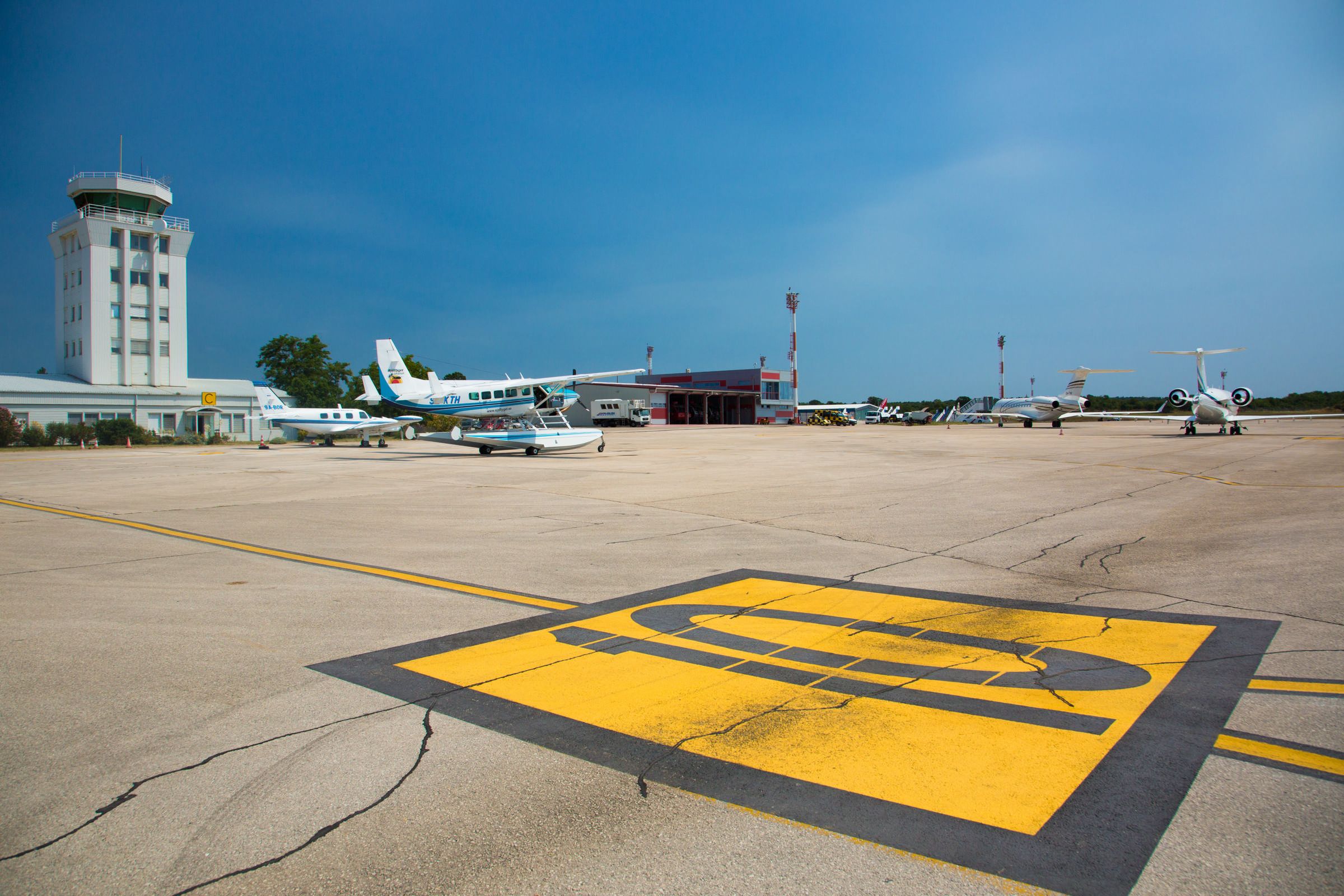
Pula Airport / Romulić and Stojčić
If you choose to take the local road to Poreč, you should follow the local D21 road, as seen on the photo below, and the journey will take about an hour.
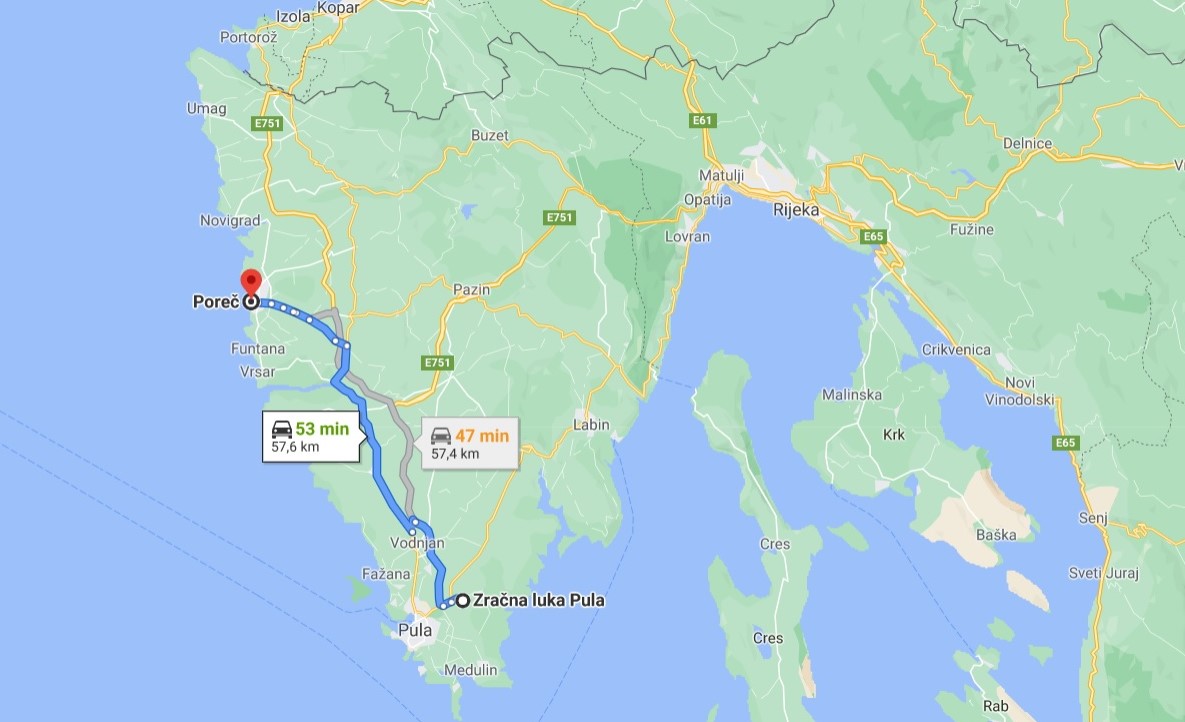
However, if you're taking the highway, you enter the E751 highway (A9 in Croatian) Istrian Y highway, at the Pula junction, and then get off at the Baderna junction. Note: A toll is charged on this route and costs 27 kunas for the first vehicle category. (Check all prices on Istrian Y here.) From Baderna, Poreč is only 17 minutes away by the local road. This route is showed on the photo below.
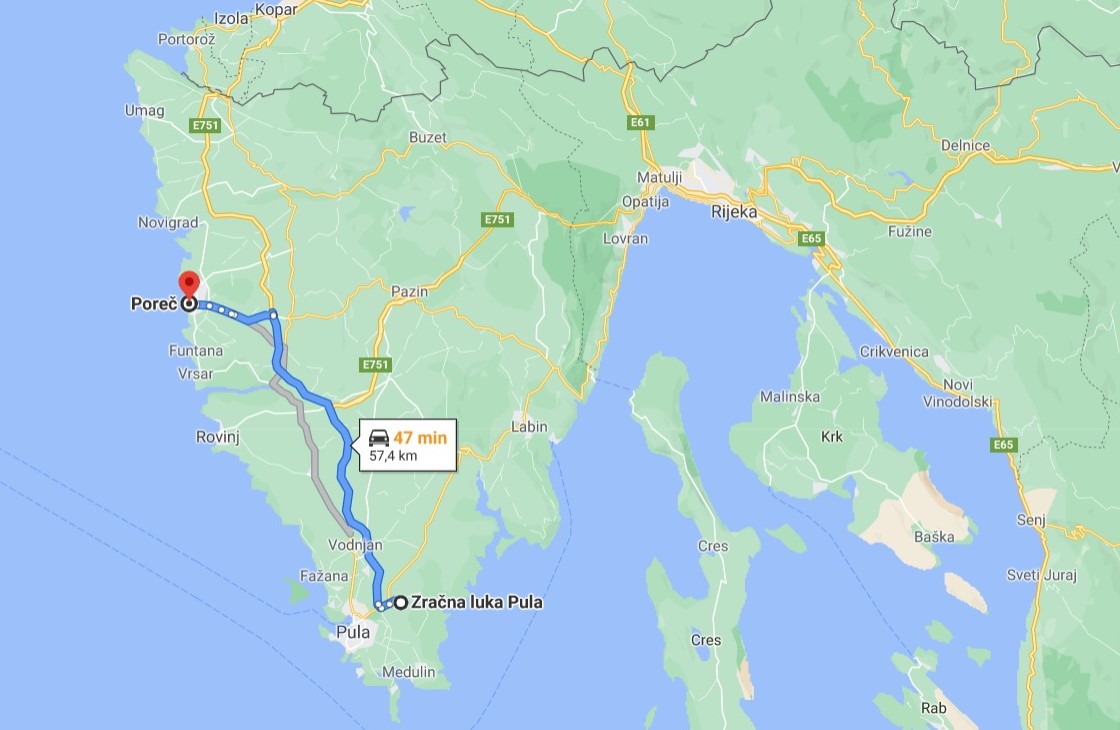
Check more cheap and quick ways to get from Pula Airport to Poreč here.
Rijeka Airport – The second closest Croatian airport to Poreč is Rijeka Airport, situated on the island of Krk, which is connected with the Croatian land by bridge. It is located about 30 kilometers from the center of Rijeka. Just like at the Pula Airport, the Rijeka Airport also offers shuttle bus services to the Rijeka city center, shortly after arrival of airplanes. However, during winter months, there's no regular shuttle service, but only service on demand from/to Rijeka and Omišalj on Krk. From Rijeka, you can take a bus to Poreč, and you can find more details about that route later in the article.
If you are traveling from Rijeka Airport to Poreč by car, you can rent a car at the Rijeka Airport, from where you'll get to Poreč in an hour and 45 minutes. The car route from Rijeka Airport to Poreč is about 115 kilometers, of which 75 kilometers is the highway (Istrian Y), and this is shown on the photo below. Find more info about Poreč to Rijeka by car later in the article.
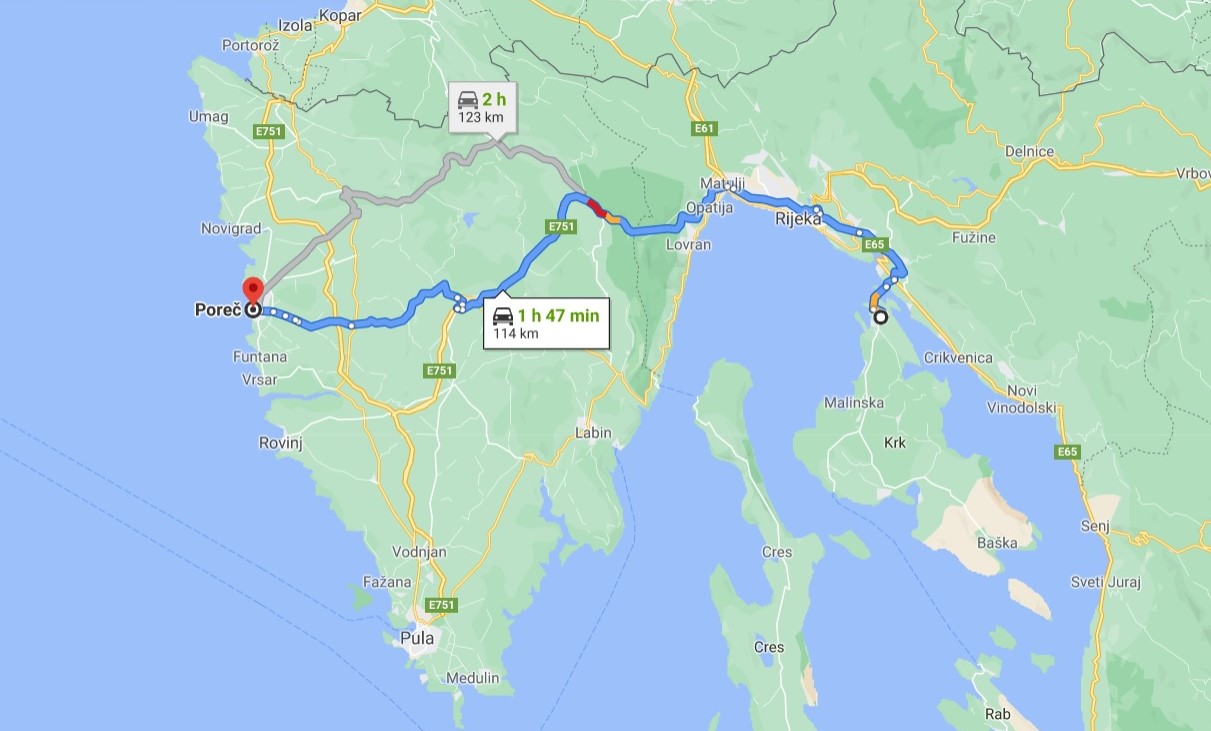
Check more cheap and quick ways to get from Rijeka Airport to Poreč here.
Other nearer airports to Poreč are Zagreb Airport, Ljubljana Airport, Trieste Airport, Treviso Airport and Venice Airport.
How far is Porec from Rijeka?
Poreč is 102 kilometers from Rijeka, and it takes an hour and 25 minutes of driving along the Istrian Y highway and local road by car. Of course, the traffic conditions should be taken into account, because during the season, the traffic can be increased which prolongs the time of traveling.
To go from Rijeka to Poreč by car, you can take the Istrian Y highway from Matulji near Rijeka and exit it in Rogovići near Pazin, from where you must continue to Poreč along the local road. Note: A toll is charged on the route from Rijeka to Pazin and costs 37 kunas for the first vehicle category. However, if you do not fancy paying a highway toll, and you'd like to stop at the Učka National Park along the way, you can take a local road D48 or D44 local road bypassing the Istrian towns of Buzet and Motovun. If you want to go along the eastern Istrian coast, you can take the local road number D66 to get from Rijeka to Poreč.
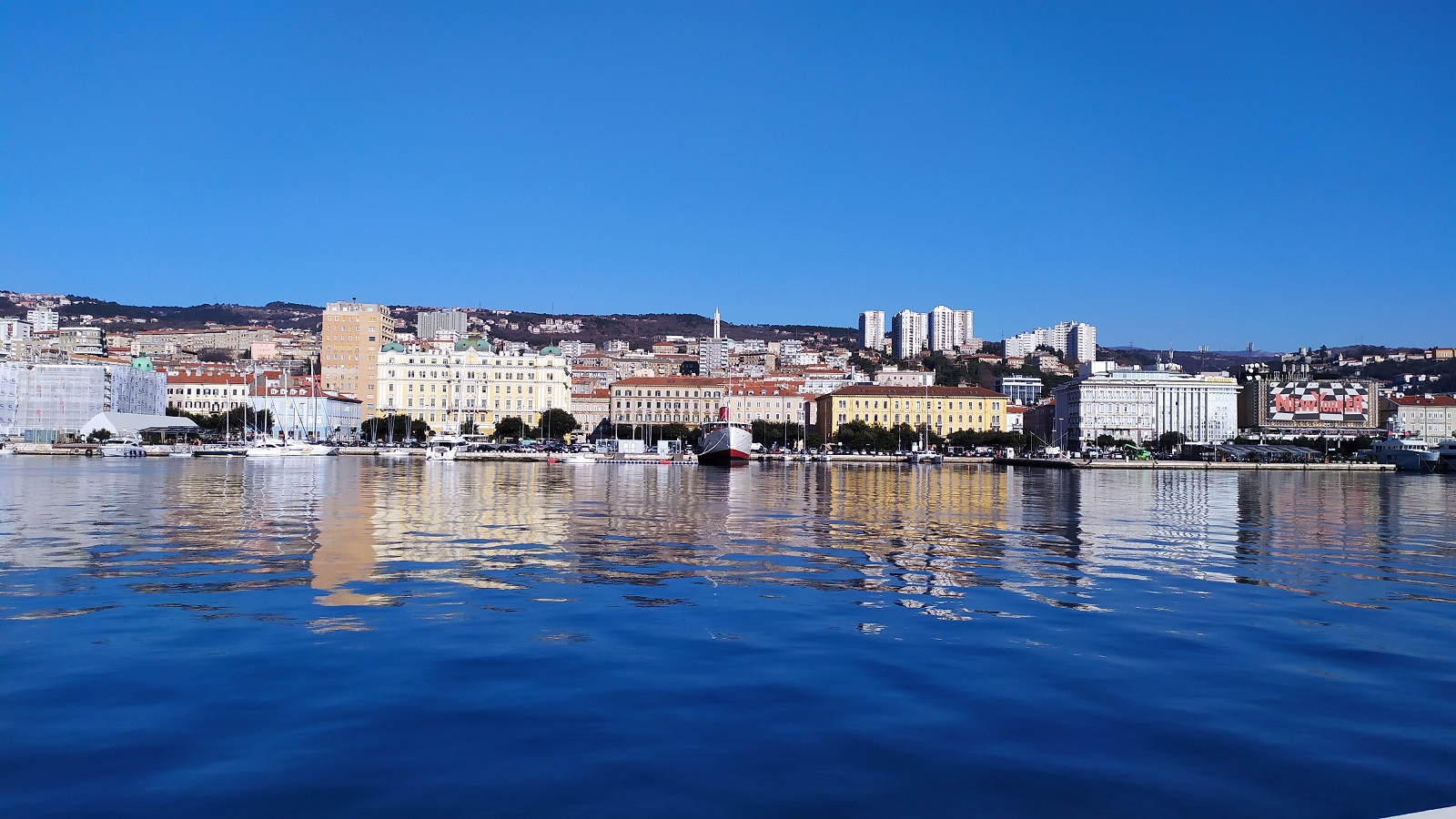
Rijeka / Donatella Pauković
Suppose you decide to take a bus from Rijeka to Poreč. In that case, there are several daily bus lines provided by Arriva, Flixbus, and other Croatian bus operators throughout the year and day. During the summer tourist season, the bus lines from Rijeka to Poreč are more frequent. It takes about an hour and a half from Rijeka to Poreč by bus, depending on the traffic conditions.
How far is Porec from Rovinj?
Poreč is 42 kilometers away from Rovinj, and you can quickly get there by bus in 45 minutes, and even faster by car. During the high summer season, there can be more traffic, so traveling time can vary. Since these two Istrian towns are so close, there are also boat lines connecting them.
Ferry from Rovinj to Poreč served by TriesteLines runs twice per week in the high summer season but does not operate outside the season. The journey takes 30 minutes and is only a foot-passenger ferry. Neither pets nor bikes are permitted onboard. Due to the coronavirus pandemic, there are likely to be many alternations and cancellations of the ferry schedules, so you will have to double-check all information. The TriesteLines operates daytime connections exclusively during summer, from Trieste to and between the port of Piran in Slovenia and the ports of Poreč, Rovinj, and Pula in Croatia.
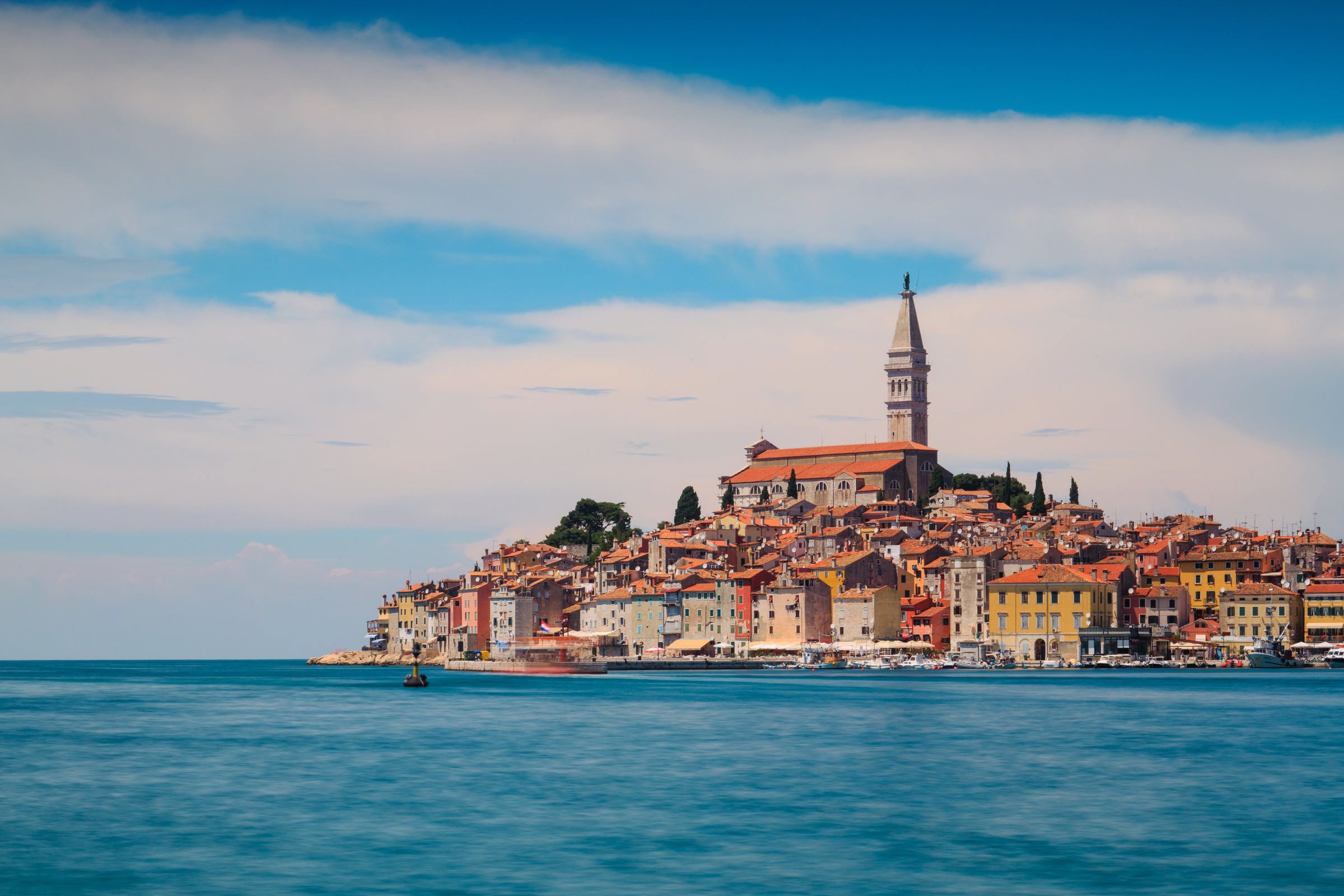
Rovinj / Romulić and Stojčić
If visiting only one town, you can easily book a one-day trip to another city. Poreč and Rovinj are separated by the Lim Bay (Lim Fjord), created as a rias of the river Pazinčica which in the past flowed into the Adriatic Sea, which today sinks in the Pazin Cave near Pazin. Hence, the road is enjoyable whether you ride a boat or car.
Several bus lines are running between Rovinj and Poreč every day, and during the summer season, there are even more of them. Bus lines from Rovinj to Poreč and in the opposite direction can be found here. You can also take the taxi from Rovinj to Poreč or find other transfer options.
How far is Porec from Dubrovnik?
Considering the fact that Dubrovnik, due to its separation and distance in the southernmost part of Croatia, is one of the hardest cities to reach in Croatia, it is quite far away from other parts of Croatia outside Dalmatia, including from Poreč. Since Poreč is 691 kilometers away from Dubrovnik, there are no direct bus lines between the two cities, but the alternative travel option would be through Rijeka. There are several bus lines operating from Dubrovnik to Rijeka, and Rijeka and Poreč are very well connected with bus lines, as explained earlier in the article.
A few bus lines from Dubrovnik to Rijeka operate throughout the year, while during the summer season, there are even more of them. The journey takes about 12 hours.
If you decide to take a car ride from Dubrovnik to Poreč, it will take about 7 hours and 50 minutes of traveling. For more details about crossing the Croatian-Bosnian border near the Bosnian town of Neum, check our dedicated article. From Dubrovnik, you can drive along the Croatian coast, i.e., the Jadranska Magistrala (D8 state road), and connect to the E71/E65 highway (A1 in Croatian) all the way to the junction Žuta Lokva in Lika (and pay a toll). From there, you can again take a local road and Jadranska Magistrala to Rijeka, where you can connect to the Istrian Y highway (as explained earlier in the article).
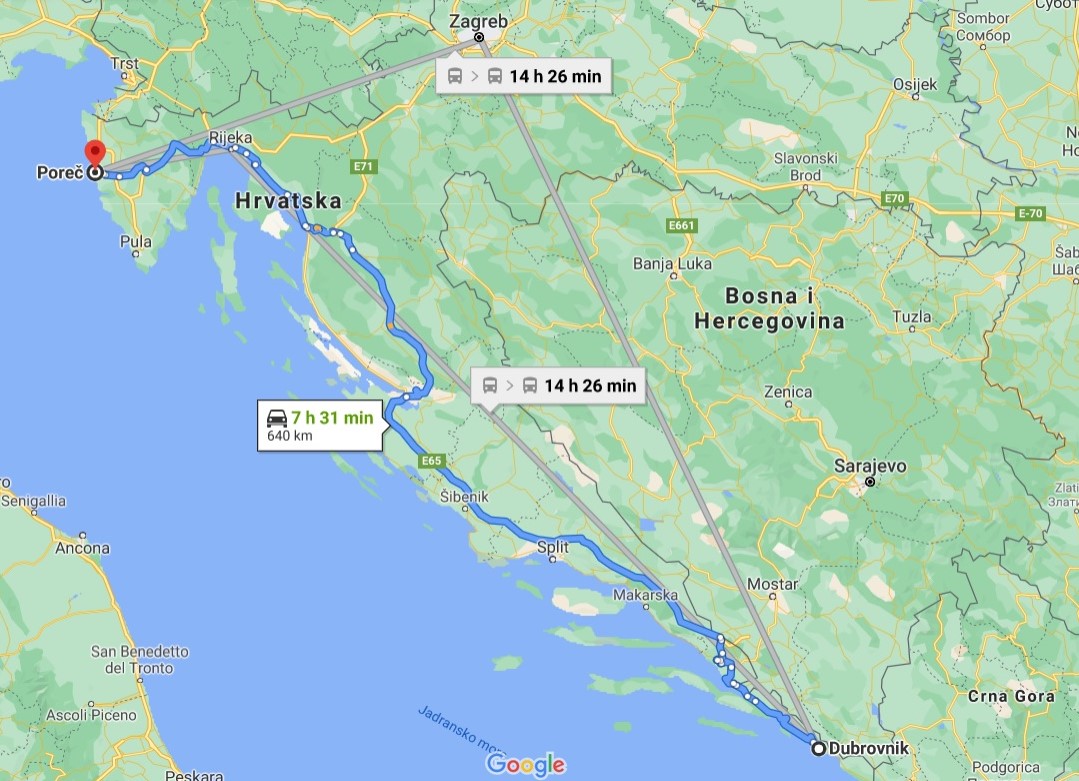
There are no ferry lines between Dubrovnik and Poreč either, nor between Dubrovnik and Rijeka.
How far is Porec from Split?
The distance between Split and Poreč is 451 kilometers, and just like with Dubrovnik, there are no bus lines connecting these two Croatian cities. Also, Poreč can be reached from Split by bus lines through Rijeka, as well as by car and highway.
How far is Porec from Zagreb?
Poreč is 250 kilometers away from Zagreb, and you can quickly get there by numerous bus lines throughout the year, as well as by a personal vehicle. If coming from the continental Croatia, Istria and Kvarner are the closest seaside destinations and easiest to reach.
How far is Porec from Osijek?
As with Zagreb, Poreč is also well connected with Osijek by bus lines operating throughout the year. Poreč is 530 kilometers away from Osijek, and it takes five and a half hours to get there by car. Some bus lines going from continental Croatia to Poreč stop in other smaller Croatian towns, such as Novska, for example, providing connected lines to Poreč. Check all bus lines to Poreč with Flixbus, Arriva, and other Croatian bus lines.
If you'd like to know the exact distances between cities in Croatia, you can check them all at one place (in Croatian).
To follow the People Also Ask Google about Croatia series, click here.
People Also Ask Google: Is Croatia Expensive or Cheap?
February 28, 2021 - Continuing our series answering the questions people also ask Google, a very common one: Is Croatia expensive? A look at cost of living, flights, travel, restaurants, rental price... and of course the price of beer.
If I had a dollar for every time I have been asked how expensive Croatia is, I would have been able to buy my own superyacht with permanent mooring on the Hvar waterfront. Is it a simple question, with many layers of answers. Let's dive in.
Is Croatia cheap or expensive? Where are you looking from?
As with most things, it depends on who is asking. Croatia appears much more expensive if you are living here and working on a Croatian salary. The money I earn here compared to what I was earning back in the UK means that my spending power is a lot less here. But then so are the stress levels, and one can't knock the lifestyle. But if you are a tourist from Scandinavia, for example, Croatia is incredibly cheap by comparison - the same continent, just three hours by plane with sunshine more or less guaranteed most of the year.
Is Croatia expensive for tourists?
Again it depends to a large extent where you go. My local bar in Varazdin in the north charges me 12 kuna for a half-litre of beer, and I fondly remember paying 55 kuna on Stradun, the poshest address in the old town of Dubrovnik. Croatia is as expensive as you want to be. I know of Russians who think nothing of blowing 30,000 euro on a good lunch at Gariful on Hvar, while round the corner you can eat well for 15 euro.
The tourist hotspots are obviously more expensive and (in some parts at least) getting more expensive. It is also the case, however, that choice is expanding rapidly, and real quality added to the tourism offer.
Visiting Croatia and on a budget? Don't head for the top spots in peak season. There is an incredible amount to be discovered both in continental Croatia and on the coast and islands away from the popular spots where prices are much more affordable.
How to get the 'local' price even if you don't speak Croatian?
It is illegal under EU law to have dual pricing (as I understand things), but it is common practice, not only in Croatia but in many places. The 'local' price is reserved for friends, regulars and anyone the owner feels like indulging. If you point out the discrimination, the results are hilarious to watch.
One of my favourite instances was in Split several years ago, when the waitress quickly withdrew my ripoff invoices, after my Croatian colleague arrived and asked why I had been charged so much. The justification was that her (much cheaper coffee) - served on a Sunday as the cathedral bells rang close by - was due to a discount given by the cafe to churchgoers. The fact that she had not been inside a church in 25 years had us laughing all the more. You can read the full tale in Cheap Catholic Coffee and Local versus Tourist Prices in Croatia.
Another favourite was on Korcula where I drank with local friends at lunchtime. They kindly paid the bill, which was 20 kuna a beer. I returned alone an hour later to be given a bill of 32 kuna. When I enquired (in Croatian) as to why the price had increased by 60% in an hour, my bill was hastily withdrawn, to be replaced with one at the original price.
Now, as a semi-local, I am used to these ways, so how do you as a tourist ensure that you get the cheaper price? If you learn one Croatian sentence on your holiday, learn this:
Molim Vas, to je domaca cijena?
Excuse me, is that the local price? Even if you can't understand the reply, the message will have come across that you are aware of the dual pricing, something that is not supposed to be known by higher-paying guests. You will often be rewarded for your efforts with a smaller bill.
Why is flying to Croatia so expensive?
Why indeed? Croatia is a very seasonal flight destination, and things used to be a lot worse. The season is much longer than it was when I first moved here in 2003. Back then, there were no budget airlines. The 'cheap' flight option out of season was Ryanair to Graz or Trieste, then bus or train/bus to the ferry in Split and then on to Hvar. Exhausting.
Ryanair entered the market in 2007, and the floodgates opened. Obviously, we will have to see how COVID-19 affects things, but for those of you who can plan ahead, there are some VERY cheap flights usually with the like of Ryanair, easyJet, Eurowings and Vueling if you book early enough. These understandably get much more expensive closer to departure.
A key reason why the Croatian market is not more competitive is the protection given to the dinosaur that is Croatia Airlines, a loss-making State company which the powers that be refuse to let die a graceful death. As a result, there are no low-cost flights into Zagreb, for example, which would transform the capital's tourism if it were introduced.
How expensive is Croatian food in restaurants and supermarkets?
The price of restaurant food in Croatia obviously depends on the level of dining quality you are looking for. There are a growing number of Michelin Star restaurants, for example. For people on a budget like mine, restaurant prices do vary according to how hot the tourist destination is, as well as the time of year. And things are definitely much cheaper in continental Croatia than on the coast.
As a very rough guide, expect to pay in the region of $5- $15, main courses from $10 - $30, and desserts from $5 - $15 for a reasonable restaurant.
Supermarket prices are reasonable, although they perhaps seem less so to people living on a local wage.
Is Croatia cheaper in Winter and more expensive in Summer?
Yes, on very many levels. Ferry prices and motorway tolls, for example, are less expensive out of the summer months. Supermarket food is too, and I always smile when I see the summer premium on the case of beer at a large supermarket chain I could mention, but won't.
There are big price changes outside the peak season in accommodation as well, and you can often get the same accommodation for half the price in the shoulder months. And if you want to do a longer stay out of season when it would otherwise be empty, you can almost name your price in some places.
Is Croatia more expensive than Greece, Italy or Spain for a holiday?
Again, that depends. If you are looking for package holidays, then I really think that Croatia cannot (or rather chooses not to) compete with Greece or parts of Spain. But if you look around, you will find extremely good value in Croatia (as well as a lot of overhyped, overpriced stuff).
Is it expensive to travel around Croatia?
What's that phrase again? It depends. Driving around Croatia IS expensive IF you stick to the motorways. I think I am correct in saying Croatia has the highest tolls in Europe. A 3.5-hour drive from Zagreb to Split, for example, will set you back $30 in tolls alone. For a one-way trip.
You don't have to use the motorways, however, and the old road from Zagreb to Split in season is a true joy. Here is my experience a few years ago.
You also have the option of services such as BlaBla car, which are growing in popularity.
The bus service is generally excellent and very affordable, while the train network is limited and slow, but also inexpensive. More on both in the TC Bus in Croatia and Croatian Train Travel pages.
Taking a car ferry with car can be pricey, and it is worth considering renting a car locally on the island for the time you are there.
How expensive is tourist rental accommodation in Croatia?
Again it depends, but I would also add that there is a LOT of overpriced stuff out there. There is a lack of quality hotels for the demand, and tourists are often shocked by the prices they are faced with, especially in peak season.
The situation with private accommodation is even worse in many respects. With no clear strategy and an insane tax policy, Croatia has tripled its private beds since 1990 from 267,000 to over 800,000 in 2018 (excellent article by Kresimir Macan in How Croatia's Tourism 'Strategy' Created Tax-Free Paradise for Private Renters).
The pandemic has really shaken up the market, however, with more renters now open to longer-term rentals. There are far more bargains to be had.
How expensive is Croatia compared to the UK?
The cost of everything is pretty much cheaper in Croatia than the UK IF you are talking actual amounts. However, if you factor in the disparity in salaries between the two countries, then I would say that Croatia is more expensive.
But for UK tourists used to UK prices, your pound sterling will go a lot further in the bars on the Adriatic than in your local back home. There are other great savings to be had as well, and a growing number of Brits are coming to get their teeth fixed and other medical procedures done while on holiday. Croatian medical tourism is on the rise, and you can often get the work done, enjoy a flight and a holiday and still go home with some change compared to what you would pay back in the UK. Learn more about Croatian medical tourism in the Total Croatia health tourism guide.
Is Croatia an expensive place to live?
With a Western salary, not at all. There is a saying in Croatia that the idea of perfect living is to live in Croatia for the lifestyle with a Western salary earned with a foreign company.
I have the Croatian lifestyle and the joys of running a media business with a Croatian company. I certainly would enjoy a more comfortable life in terms of buying things in the UK, but I wouldn't swap it for what I have in a million years.
Getting by on a Croatian salary is not easy, and there is a reason why the average age of people moving out of their parents' homes is much higher here than most of the EU.
How much are basic consumer goods in Croatia?
Here is what Numbeo came up with in February, 2021.
You can see what the latest prices are when you read this article (assuming you get this far) on the Numbeo website.
Is property expensive in Croatia?
Yes, although there are also good deals to be had. The Great Croatian Property Boom inflated places a lot in my opinion, with some foreigners paying crazy prices for derelict goat sheds and other ruins. Much more on real estate in Croatia in the Total Croatia property guide.
Is Croatian wine any good? How expensive is it?
Did you know that Croatia is the home of the original Zinfandel, grown on vineyards just outside Split in Kastela? Or that it has over 130 indigenous varieties? Or that it was served at the inauguration of President Biden in January 2021? Or that it was served at the Coronation of Queen Elizabeth II in 1953, and you can still buy a bottle to the same 1947 vintage served on that royal occasion. Learn more in Croatia's Most Expensive Wine: Selling Well at 7,400 Euro a Bottle.
Learn all you need to know about Croatian wine in the TC guide.
Are drinks expensive in Croatia? How much is a beer?
A few years ago, Joe Orovic wrote a great article called Beer Prices in Croatia 2018: A Cost-Conscious, Inebriated Guide To Getting Hammered. It included a hilarious (and very accurate) coefficient for calculating beer prices, depending on proximity to the sea, top destination, time of year etc. I heartily recommend it if you want to understand the nuances of this important topic.
Beer prices in Croatia vary a LOT. To give you an example, that trusty half litre in my local in Varazdin up north costs 12 kuna (less than $2), with the same bottle costing 22 kuna in my local on Hvar. Much more on beer in Croatian in our dedicated TC beer guide.
Is it cheaper to live inland or on the coast in Croatia?
Again it depends. I was shocked at how much cheaper things were when we moved to Varazdin from Hvar (see the beer example above). Salaries also tend to be lower in many cases, and there is liltle or no tourism for locals to supplement their income with. But all the money I saved in the pub was taken back to me when I got my heating bills up north.
Overall, the cost of living is much cheaper in continental Croatia, although that is from a viewpoint of starting with the same amount.
Is it cheaper to buy fuel in Croatia or neighbouring countries?
If there is a place in the EU which has more expensive fuel prices than Croatia, I have yet to find it. I was stunned when I visited a petrol station in Graz driving through Austria last year. Just 1.07 euro per litre. The current cost of diesel is just under 10 kuna in Croatia, about 1.30 per litre. If you are driving from Split to Dubrovnik, tank up in the Neum Corridor (the section of Bosnia you have to travel through. Your savings will buy you a good portion of a hearty lunch.
Let's look at some of the hotspots: How expensive is Dubrovnik?
Back to that two-word answer again - it depends.
A few years ago, I was having a coffee on Stradun with a local, and I asked if she thought Dubrovnik was expensive and how she felt about the label.
"No, we are not expensive. For this location in Paris, Madrid and London, you would probably pay even more." More expensive than the rest of Croatia, less expensive than comparable cities of culture in Europe. We are back to that viewpoint again.
There ARE many tourist traps in Dubrovnik, but similarly, there are more affordable places. Get to know the Pearl of the Adriatic in our Dubrovnik in a Page guide.
How expensive is Split?
When I moved to Croatia back in 2003, Split was not so much of a destination as a transit lounge. Indeed it was more often referred to the Gateway to the Dalmatian Islands. How things have changed! I love Split now for its diverse offer, although the crowds were starting to become an issue pre-COVID-19.
Prices have increased in the tourist areas accordingly, although they are nowhere near Dubrovnik levels. But there are still plenty of places with more reasonable prices. Learn more about the Dalmatian capital in our Split in a Page guide.
How expensive is the capital Zagreb?
I find Zagreb in general to be quite a bit cheaper than the big cities on the coast, and excellent value as a capital city in the EU. I can still find my trusty half litre for as little as 10 kuna, certainly for 12, something that is no longer so easy in Split and Dubrovnik. Learn more about the Croatian capital in our Zagreb in a Page guide.
How expensive is Hvar really?
Ah, Hvar.
Having lived there for 13 years, I have a fair bit to say on the subject. Firstly, there is a huge difference in terms of pricing between Hvar Town and the rest of the island of Hvar. And within Hvar Town, you can spend tens of thousands on lunch, or get by very well on a backpacker budget. More on Croatia's premier island in our Hvar in a Page guide.
A clue in the pricing is reflected in the makeup of the tourist. In Hvar Town, for example, Brits, Americans, Brazilians, Germans, Italians and Scandinavians make up a lot of the guests, while in Jelsa, there are a lot more from Czechia, Slovakia, BiH, Serbia and Hungary. Prices are much cheaper and so attract a lower-spending clientele. But yes Hvar is more expensive than other places, especially on the continent. But there is a reason for that, which brings us to the last point.
Learn the Croatian phrase to explain how cheap/expensive Croatia is.
So how expensive is Croatia? We are back where we started - it depends.
But I leave you with one of my favourite questions in Croatia, which you see a LOT on Facebook on a beautiful day. And I found myself doing the same on the terrace of our Jelsa home before we moved and turned it into the Panorama Penthouse Jelsa holiday rental.
Ko ovo more platit?
Who can afford that?
Nice view isn't it? Is it expensive or cheap?
If you have any thoughts on the above, or any corrections or suggestions, drop me a line at This email address is being protected from spambots. You need JavaScript enabled to view it. Subject Expensive
To get the answers to more questions in our People Also Ask Google series, visit the dedicated section.
Check out Croatian national television checking out the San Francisco digital nomad lifestyle on Hvar. Ko ovo more platit...
People also ask Google: How Many Days Should I Spend in Dubrovnik?
February 26, 2021 - Continuing the TCN series answering the questions posed by Google's People Also Ask function - how many days should I spend in Dubrovnik?
Dubrovnik, the walled city Lord Byron once called the 'Pearl of the Adriatic,' has dazzled tourists for decades.
Historians claim that tourism first really set off in this picturesque walled city in 1945. Its inclusion in UNESCO's World Heritage List over 30 years later only heightened its fame.
The breakup of Yugoslavia in the early 1990s pushed Dubrovnik into the spotlight once again, however not for its grandeur and charm, but as the target of the Yugoslav People's Army during the Seige of Dubrovnik. Intensive shelling blasted the medieval city walls, and over two-thirds of buildings in the historic core were damaged. The tourist jewel in pieces.
But even after its darkest days, Dubrovnik shone again thanks to an extensive reconstruction between 1995 and 1999. The Adriatic Pearl was polished to its pre-war perfection, and it has been Croatia's champion of tourism ever since.
I first visited Dubrovnik on my first trip to Croatia in 1996, not yet six years old and just after the war. I have photos of me striking poses on Stradun, slurping ice cream melted from the hot summer sun, and chasing pigeons around St. Blaise Square. The city's monumental effect on me as a child never dwindled, and its magic only grew as I got older.
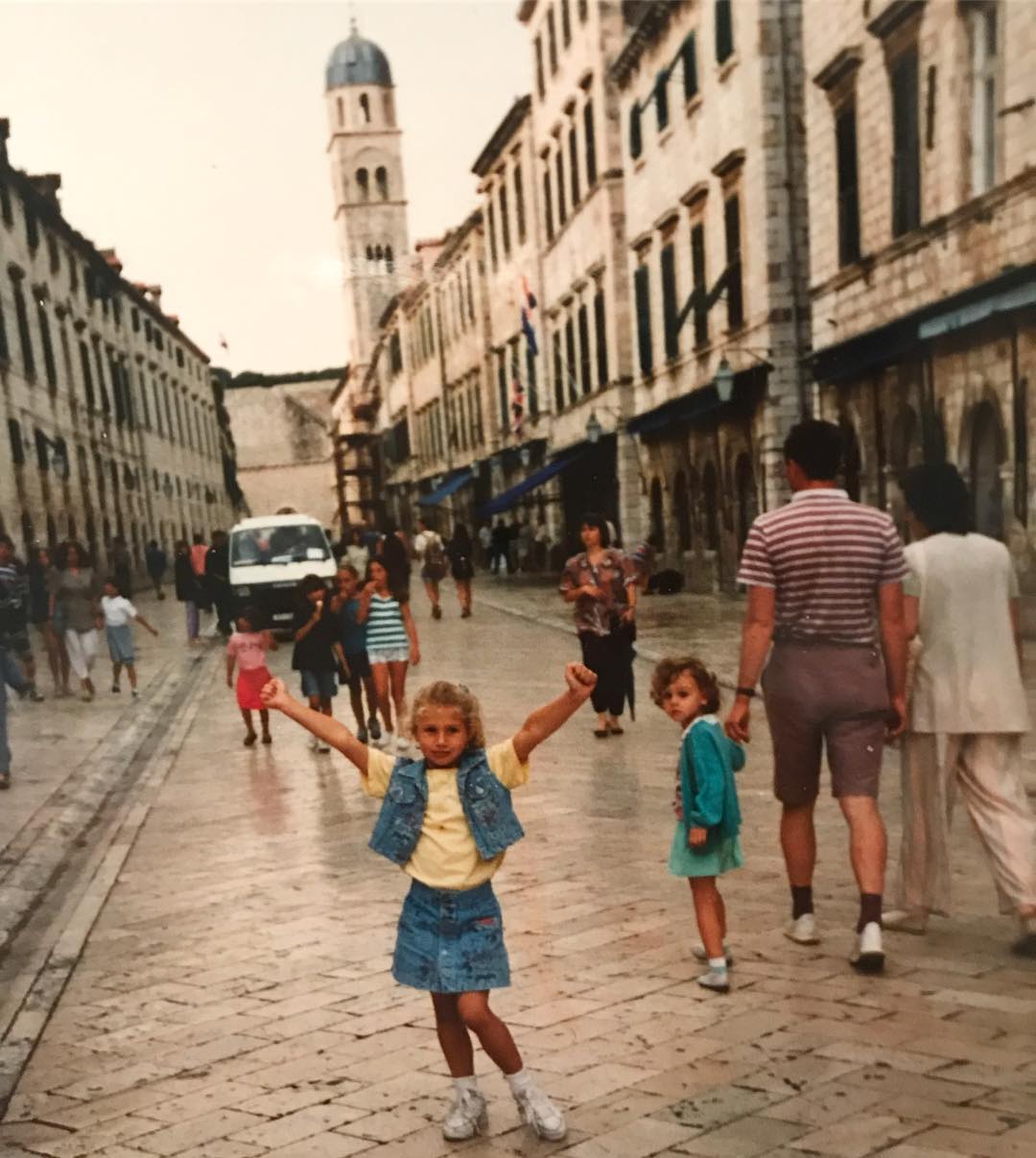
As a teenager, I would dream of visiting the baroque city during month-long stays in my mother's village of Kosa, just outside Metkovic and only 45 minutes from Dubrovnik. On Dubrovnik day trips, I begged my mother to dress up with me for fancy fish lunches and sunset gelato. It was my favorite Croatian city, without a doubt.
We have brought dozens of friends from the US to Dubrovnik, staying for days in old-town apartments we wished we maybe hadn't booked after schlepping oversized luggage up 100 steep steps. But once the golden hour lit up Stradun, nothing else mattered - and the magic of Dubrovnik was infectious.
But that was over a decade ago.
If Dubrovnik wasn't already popular then, today is it one of Europe's top travel destinations and a summer haven for cruise ship tourists who pile into the town for a day. A victim of 'overtourism' next to Venice before the COVID-19 pandemic hit, the city's charm has often been met with critique and tourists wishing they hadn't visited in the summer after all.
But there are ways to beat the bustle and ensure you get the most out of what Dubrovnik has to offer, so you too can experience its perpetual allure. Just read carefully.
How Many Days Should I Spend in Dubrovnik?
While I thought it was tough to decide how many days you should spend in Split, quantifying it for Dubrovnik is infinitely harder. If you asked me in 2006, I would say a week, in 2010, maybe 3 days, and in the last couple of years, I would say no more than a day.
Though I would hardly agree with that now.
Factoring the potential of summer crowds (though we can't predict they'll return so fast after COVID-19), the key to Dubrovnik is taking your time.
How long should I spend in Dubrovnik to see the Old Town?
Truth be told, Dubrovnik's center looks much mightier than it really is. This rather compact old-town town could be explored on a speedwalking tour in just a few hours, but that's not as much fun.
To really explore the cracks and crevices of Dubrovnik's old town, I'd recommend one day - minimum. This gives you time to wander and stop to examine numerous historical attractions like Onofrio Fountain, built in 1438, the Franciscan Monastery (which is also home to Europe's oldest pharmacy), and the baroque Church of St. Blaise (circa the early 1700s).
Don't forget the Rector's Palace, which held the Rector's seat of the Republic of Ragusa, nor can you miss the Romanesque-style Cathedral of the Assumption, designed by Roman architect Andrea Buffalini, which dates back to the 12th century. The 16th-century Sponza Palace is best seen at dusk, while the 31-meter-tall Bell Tower can be used as your marker as you wander around town.
You'll certainly need time to peruse the shops hidden in high alleyways and people watch with a probably over-priced beverage on Stradun, which won't matter much to you then as you embrace the history around you.
How much time do I need to see the city walls?
Dubrovnik's main attraction, its walls, has guarded the town for centuries. Built between the 12th and 17th centuries, these defensive stone walls are almost two kilometers long and wrap around the Old Town with scenic views overlooking Dubrovnik's red rooftops and sparkling Adriatic Sea.
You haven't really been to Dubrovnik unless you've examined the city from this height, and history will continue to reveal itself at every tower, fort, and turn.
By entering from the busy Pile Gate, you'll find that walking the walls will take around two hours, that is, if you really take your time to enjoy it. Should you choose to visit in summer, it's best to book in advance and book to tour the walls in the morning - you'll thank me later.
Because you'll likely need to rest after this wall-workout, don't rush to see the next thing - take the day in Dubrovnik to relax at a cafe or beach!
How many days should I spend in Dubrovnik to visit Mount Srd?
One of Dubrovnik's top recommendations is Mount Srd, which you can reach in style with the cable car (5-10 minutes to the top), by hiking (about an hour), or driving (13 minutes from Pile Gate). Offering incredible panoramic views of Dubrovnik and the Adriatic, no matter which way you choose to make it to the top, you'll be rewarded with a panoramic restaurant, buggy tours, and the Croatian Homeland War Museum, which exhibits the Croatian War for Independence in haunting photographs from 1991-1995.
Depending on what you choose to do, you could make Mount Srd a full-day activity!
Can I see everything on Lokrum in one day?
Just 15 minutes by boat from the Dubrovnik Port is Lokrum, a small green island oasis that dates back to pre-historic times (1023). The perfect day-trip idea, Lokrum, is a natural habitat that boasts a botanical garden, medieval Benedictine monastery, nudist and rocky beaches, and even a Dead Sea-like saltwater lake.
You can easily spend the day on Lokrum to beat the summer heat and crowds. This forested wonder even has a restaurant!
Can I see the Elaphiti Islands in one day?
I didn't visit the Elaphiti Islands until maybe my 6th or 7th time in Dubrovnik, and I'm so sorry I didn't go sooner. The Elaphiti Islands, which get their name from the Greek word elafos, are a small archipelago of several islands slightly northwest of Dubrovnik. The three most famous are Kolocep, Lopud, and Sipan, populated by less than 1,000 people in total, though 13 islands make up the archipelago.
Tranquil, forested, and mostly car-free, the Elaphiti Islands offer a picturesque escape from the busy city. While you can visit Kolocep, Lopud, and Sipan by ferry, the timetables could get a bit tight, so booking a private speedboat tour for the day ensures you get the most out of your adventure - and lunch at an island konoba to boot!
How many days should I spend in Dubrovnik if I'm a Game of Thrones fan?
Calling all Game of Thrones fans! If you didn't know by now, Dubrovnik was transformed into King's Landing for the hit TV series, and you'll notice many famous scenes just by walking around the Old Town. For example, Cersei Lannister's steps of 'Shame!' (or Dubrovnik's Jesuit Stairs), St. Dominic Street (most marketplace scenes in King's Landing), while the Rector's Palace, Rupe Ethnographic Museum, Fort Bokar, Fort Lovrijenac, Ploce Gate and more all have their chance in the spotlight.
There are several Game of Thrones tours you can choose from, most lasting around two hours, which will not only take you to filming locations but give you the history spiel of the city, too.
You can also head 30 minutes outside of Dubrovnik to the Trsteno Arboretum, whose gardens are featured in seasons 3 and 4!
How many days should I spend in Dubrovnik, depending on the season?
Summer is without a doubt the busiest time in Dubrovnik thanks to the scorching hot sun, but that doesn't necessarily mean it is the best time to visit. Trying to do everything you want in a day or two during the summer could be an impossible task, given that long lines and crowds make many tourist activities tough to tick off. If you have time to spend in Dubrovnik in the summer, do it, and book yourself accommodation outside the bustling Old Town so you can maintain a somewhat slower summer pace.
Spring may be the best time of the year to visit Dubrovnik for various reasons - 1) usually good weather, 2) tolerable crowds, less traffic, and emptier walls, and 3) more affordable prices. Most tourist attractions are open as well, and booking in advance is probably not necessary. Summer flight schedules to Dubrovnik usually kick off in the spring, making it easier to get in and out.
Winter in Dubrovnik exposes the city's local life, which is often hard to experience any other time of the year. Dubrovnik is still enhanced by events in the wintertime, like Advent Christmas markets, its Winter Festival, and, of course, the celebration of its patron saint, St. Blaise. The weather may be cooler, but the vacant streets give the town a new kind of enchantment that only winter can bring.
Conclusion: How many days should I Spend in Dubrovnik?
Another impossible question to answer, I believe it all comes down to why you're visiting in the first place. If you want to be fully immersed in the history, culture, and beauty of Dubrovnik, do yourself a favor and don't cut your trip to one day. However, if you're only looking to walk walls to say you did it and prefer a quick gander around town, one day is plenty.
Keep in mind that the time of year you choose to visit will have a huge part in how your trip plays out. Even so, we're pretty sure you'll feel the magic no matter when.
To follow the People Also Ask Google about Croatia series, click here.
People Also Ask Google: What Language Do They Speak in Istria?
February 25, 2021 – Continuing the TCN series answering the questions posed by Google's People Also Ask function, one that confuses many: what language do they speak in Istria?
Where is Istria?
Istria is the biggest and northernmost peninsula in Croatia and the Adriatic. It lies in the northern part of the Adriatic, in Croatia, Slovenia, and Italy. Geographically, 90 percent of the Istrian peninsula is part of Croatia, while nine percent includes Slovenia.
Most Croatians live in the Croatian part of Istria (68,33 percent), while minorities make up a quarter of the population, of which Italians are the biggest group – six percent. In the Slovenian part, Slovenes make up the absolute majority population. Only one percent of the Istrian surface is part of Italy. It includes only two small municipalities near Trieste, of which the majority of the inhabitants in one are Slovenes and in the other are Italians.
According to the 2011 census, 25 percent of people in Croatia declared their regional identity as Istrian, of which 12 percent live in Istria County, one of 20 Croatian counties. The name for a regional identity developed by a part of the citizens of Istria, mainly its Croatian part, is Istrianism. Thus, regional identification is more pronounced in Istria than in other parts of Croatia.
How many official languages are there in Istria?
Since there are two official languages in Istria – Croatian and Italian – Istria is a bilingual community. Italian is the second official language in Istria since 1994, and the Constitution guarantees the rights to bilingualism in Croatia. Out of 208,000 inhabitants in Istria County, 180,000 stated that their mother language was Croatian, while 14,000 of them stated Italian as their mother language.
Native speakers of Italian in Croatia according to the 2011 census / Wikipedia
In addition to Croatia's Constitution, local legislation, i.e., the Istrian County Statute equates these two languages in public use and encourages learning Italian as an environmental language. The Istrian bilingual community includes both smaller and larger Istrian settlements.
Due to this bilingualism, Istria is a specific region in Croatia, so there are many Italian public institutions (schools, kindergartens, etc.). Istria has a long tradition of education in another language. Besides, the environment itself is bilingual, which means that Italian is not only spoken by Italians but people of other nationalities too, including Croatians. Also, Istria is historically, culturally, and economically strongly connected with Italy.
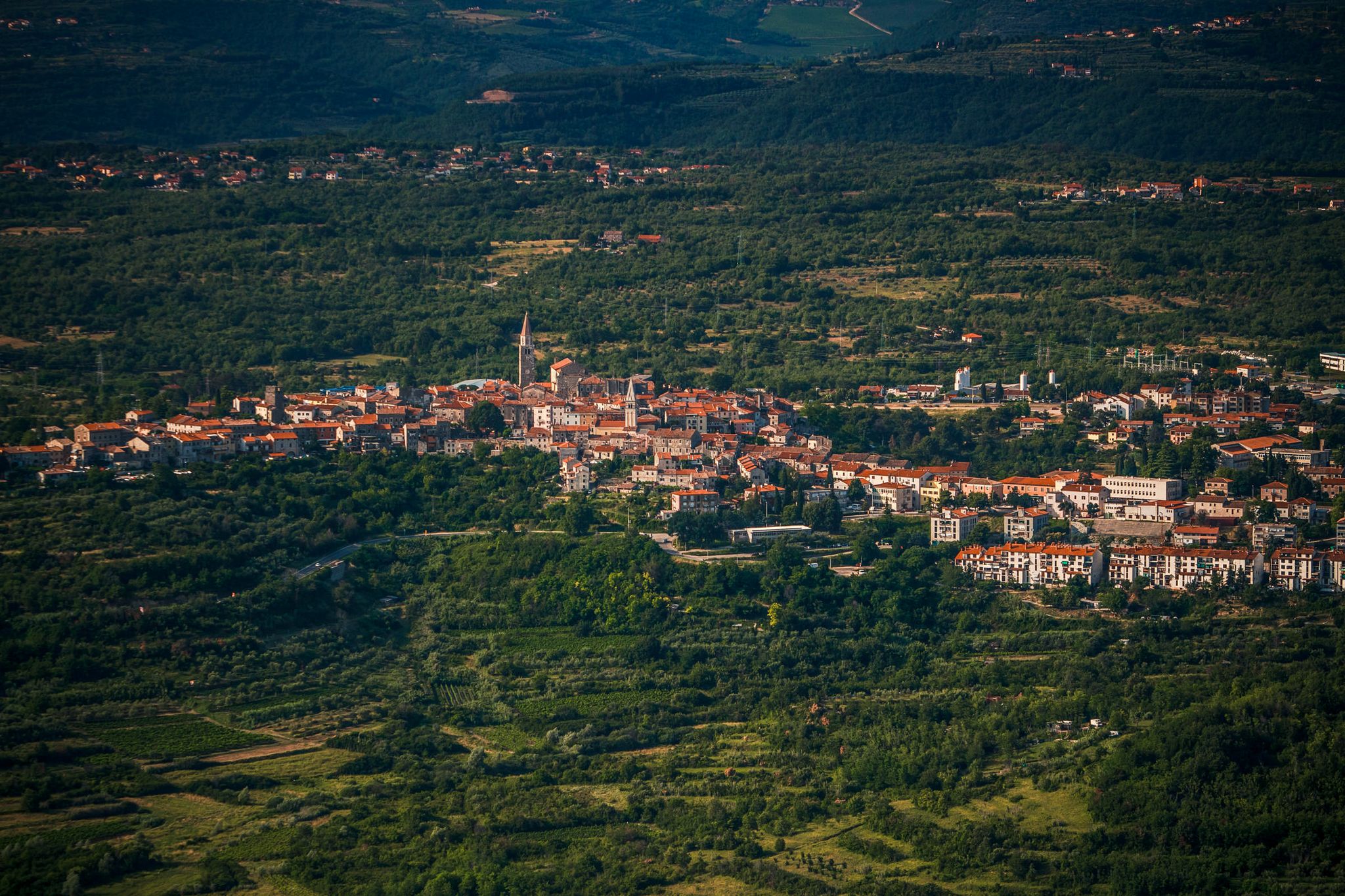
Buje, Istria / Copyright Romulić and Stojčić
Reputable cultural, scientific, pedagogical, and artistic minority institutions have been established in Istria: Italian Drama in Rijeka (Dramma Italiano), Center for Historical Research in Rovinj (Centro di Ricerche Storiche), Italian department at the Faculty of Philosophy and departments in Italian for teacher education at the College of Teacher Education in Pula. Also, La Voce Del Popolo, a daily newspaper in Italian owned by the Italian Union (Unione Italiana), is published in Rijeka.
During his visit to Istria last year, Italian Ambassador to Croatia, Pierfrancesco Sacco, said that Italians in Croatia feel at home, like Croats in Italy. This is especially evident in Istria and Pula, where there are a deep friendship and a desire to find new cooperation methods. On that occasion, the Mayor of Pula, Boris Miletić, said that the fundamental values, which have been nurtured in this area for decades, are openness, multiculturalism, and coexistence.
What language do they speak in Istria?
The vast majority of Istrians speak the Croatian language's Chakavian dialect, meaning they use the interrogative pronoun "ča." Only in some parts near the border with Slovenia, some people use the interrogative pronoun "kaj," so they are often mistaken for Kajkavians. Still, the structure and characteristics of these speeches are distinctly Chakavian.
Chakavian dialect is also spoken in Dalmatia. However, the Istrian Chakavian dialect is different from the Dalmatian one due to the numerous Italianisms. It is also difficult to understand it in the rest of Croatia. The most widespread Chakavian dialect in Istria is the Southwestern Istrian dialect. There are also Buzet, Northern, Central, and Southern Chakavian dialects in Istria.
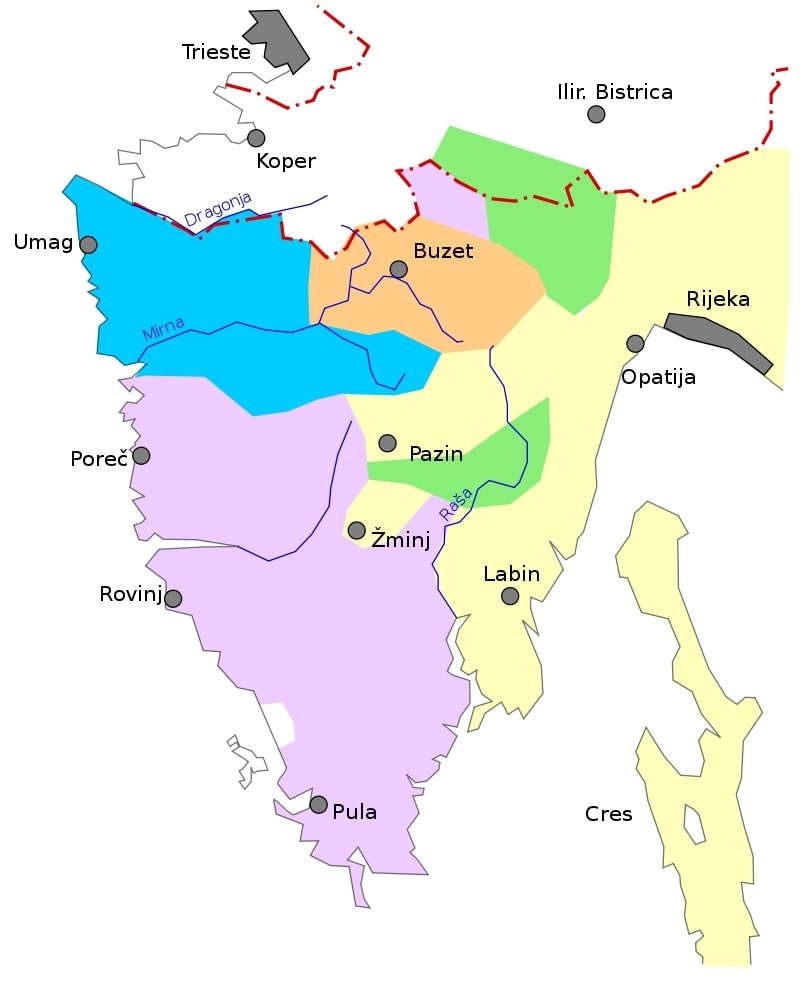
Chakavian dialects in Istria: Southwestern (purple), Buzet (orange), Northern (yellow), Central (green), and Southern Chakavian (blue) / Wikipedia
The aforementioned Italian minority lives in some towns on the Istrian west coast and in some villages near Buje, and they speak Italian. In the Slovenian part of Istria, the Slovenian language is spoken.
In the eastern part of Istria, at the foot of the Ćićarija mountain, in several smaller villages live Istro-Romanians or Ćići, a population of Romanian origin who speak their own Istro-Romanian language, which is a mixture of Romanian and Croatian. Today, many of them have adopted the Croatian language and are now considered Croats.
In addition to the dominant Croatian and Italian languages, other minority languages are spoken in Istria, namely Serbian, Bosnian, Slovenian, Albanian, and Macedonian. One can hear the Shtokavian dialect in Istria as well.
What language do they speak in Istria? Istro-Romanian language
Istria is home to two of the 20 most endangered languages in the world by UNESCO – the Istro-Romanian language and Istriot.

Istro-Romanian language is a Balkan Romance language spoken by only a few hundred people today in the northern Istrian villages of Žejane, Lanišće, and Šušnjevica. It is highly similar to the Romanian language, and for some linguists, the Istro-Romanian language is considered a dialect of Romanian. People in Istria who speak it are called Rumeri, Rumeni, Vlachs, or Istro-Romanians. Croats disparaging started to call them Ćići or Ćiribirci.
In the middle of the 15th century, the Ćiribirci were settled by Ivan VII Frankopan from Velebit on the island of Krk. Since the Ćići plundered Ivan Frankopan in northern Istria in 1463, when their name is first mentioned, it is believed that they immigrated to Istria from Krk. However, Istro-Romanians are not officially recognized as a national minority in Croatia.
The most interesting fact about the Istro-Romanian language is that it was spoken by one of the most famous inventors of all time – Nikola Tesla – even though he wasn't even aware of the ethical existence of the Istro-Romanians. Since elementary school, Tesla was able to speak the Istro-Romanian language, despite the fact that Istro-Romanian was not taught in schools in those years. It was only spoken by a few thousands of people in Istria and Lika, and he could have probably learned it in his family.
Although Telsa always considered himself a Serbo-Croat, one Romanian academic, Professor Moraru, thought Tesla was an Istro-Romanian. When Romanian scholars contacted Tesla in the early 20th century and explained he was of Istro-Romanian roots, he allegedly showed amazement but did not comment on that matter. Therefore, Nikola Tesla has never denied the possibility of his Istro-Romanian origins.
What language do they speak in Istria: Istriot language
Istriot language, often confused with Istro-Romanian language, is a Romance language spoken by about 400 people in the southwestern part of Istria, particularly in Rovinj and Vodnjan. Still, it is also preserved in Bale, Fažana, Galižana, and Šišan. It should not be confused with the Istrian dialect of the Venetian language either.
According to some estimates, the Istriot has only a few dozen active speakers and about 300 people who understand it and can use it in part. It is a Romance language related to the Ladin populations of the Alps, currently only found in Istria. Its classification remained mostly unclear, but in 2017, it was classified with the Dalmatian language in the Dalmatian Romance subgroup.
Historically, its speakers never referred to it as "Istriot language." Instead, it had six names after the six towns where it was spoken: in Vodnjan it was named "Bumbaro," in Bale "Vallese," in Rovinj "Rovignese," in Šišan "Sissanese," in Fažana "Fasanese," and in Galižana "Gallesanese." The term Istriot was coined by the 19th-century Italian linguist Graziadio Isaia Ascoli.
Younger Italians in these places mostly understand Istriot, but they rarely use it, and Croats rule this idiom very badly or not at all. It is most endangered in Fažana, and it seems that it is most strongly maintained in Bale.
What language do they speak in Istria: Istrian dialect in Slovenia
Slovene dialects are separated into a few groups, and the Istrian dialect, spoken in Slovene Istria, falls in the Littoral dialect group. Istrian dialect is spoken in the rural areas of Koper, Izola, and Piran. The Slovenes living in the Italian municipalities of Muggia and San Dorligo della Valle, as well as in the southern suburbs of Trieste (Servola, Cattinara). In Croatia, it is also called the Slovenian-Istrian dialect.
The dialect has been influenced by Croatian as spoken in Buzet and Ćićarija and is further subdivided into the Rižana and Šavrin Hills subdialects.
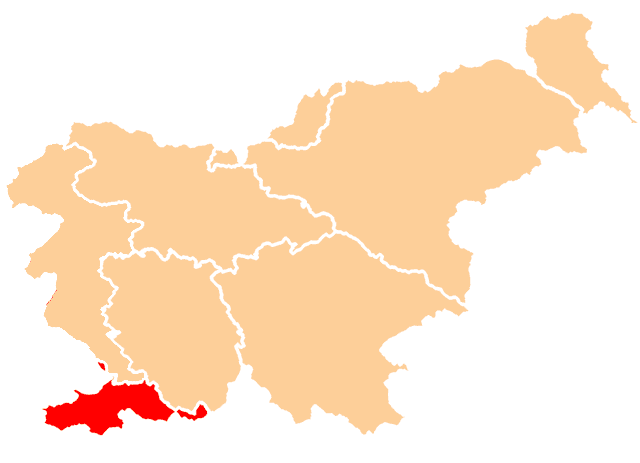
Slovene Istria / Wikipedia
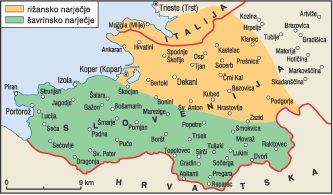
Rižana subdialect (yellow) and Šavrin Hills subdialect (green) / Wikipedia
The Rižana subdialect is spoken in the northern part of Slovenian Istria, in the Rižana Valley east and north of Koper, including the settlements of Bertoki, Dekani, Osp, Črni Kal, Presnica, Podgorje, and Zazid. In Italy, Rižana subdialect is spoken in most of the municipalities of San Dorligo della Valle and Muggia south of Trieste and some southern suburbs of Trieste, especially Servola.
The Šavrin Hills subdialect is spoken in the Šavrin Hills south of a line from Koper to the south of Zazid. It includes the settlements of Koper, Izola, Portorož, Sečovlje, Šmarje, Sočerga, and Rakitovec.
The mixture of Šavrin dialects proves the closeness to the Čakavian dialects, and the Rižana sub-dialect is entirely Slovene. There are many Romance loanwords in both sub-dialects linguistic legacy, mostly Venetian, Trieste-Romance, and Italian.
Why do locals speak Italian?
As previously explained in the second paragraph of this article, Croatians in Istria speak Italian because it has been implemented in public speech and institutions for such a long time.
As Marija Črnac Rocco, head of the Rovinj City Council office, explained for Novosti portal, the Italian national minority in Istria (and certain other Croatian parts) is autochthonous, meaning that the Italian component has always lived and existed in these territories.
Likewise, Italian was the official language during all the various reigns in Istria until the end of the Second World War – the Venetian Republic, the Kingdom of Austria, Napoleon's rule, the Austro-Hungarian Monarchy, and the Kingdom of Italy.
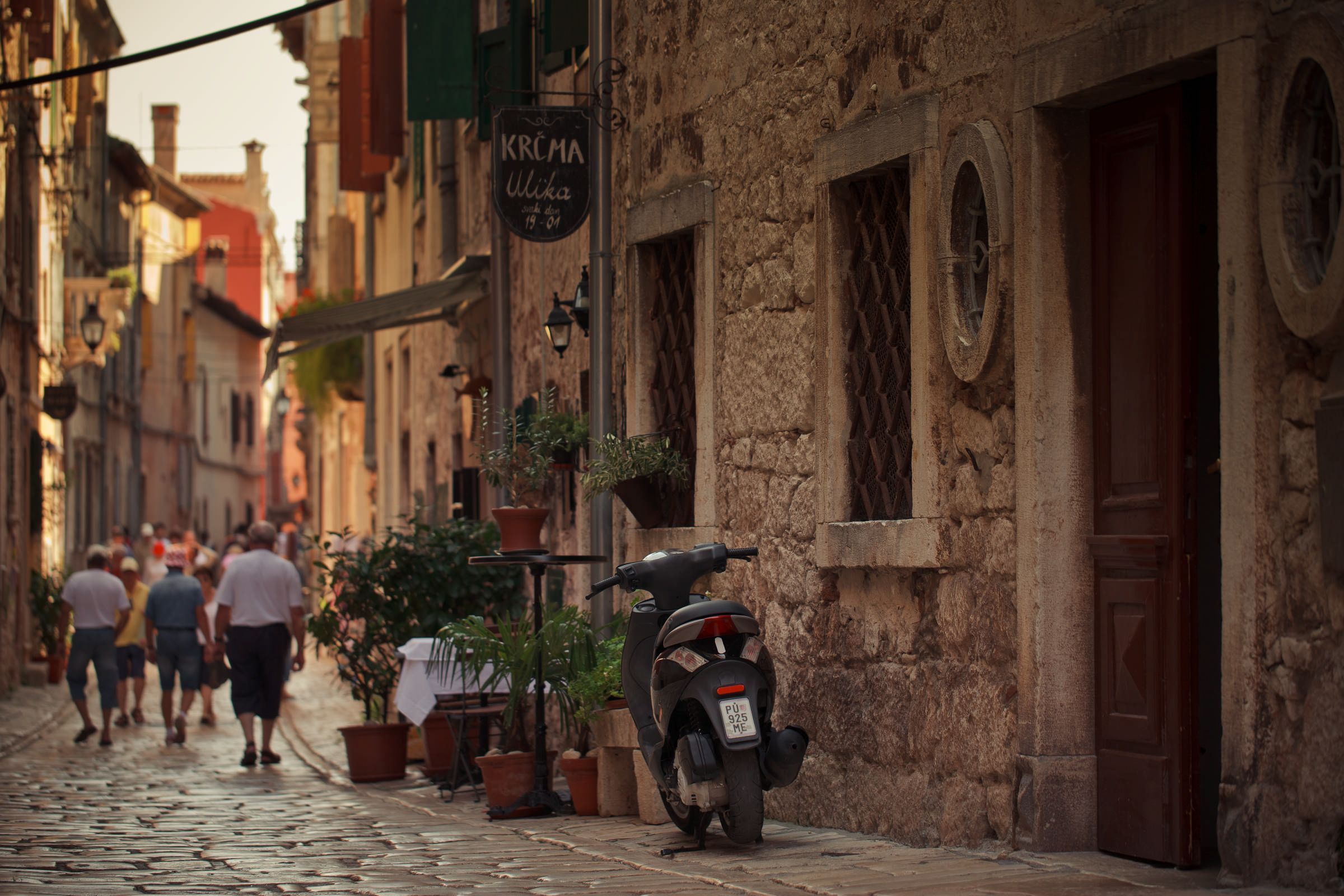
Rovinj, Istria / Copyright Romulić and Stojčić
After the Second World War, Istria was annexed to the Federal Republic of Slovenia and Federal Republic of Croatia, namely the Socialist Federal Republic of Yugoslavia. The Italian national community's position, which became a minority in a significant part of Istria due to sad post-war circumstances, has been the subject of consideration and securing the rights of many international agreements.
Therefore, the equal use of the Croatian and Italian languages in Istrian County and many towns and municipalities in Istria is undoubtedly a legal obligation, which for most Istrians is both a moral duty and a civilizational achievement of which they are proud.
Bilingualism in Istria is not only lived in translated official documents, it is lived in families, on the street, in everyday communication, in traditions, and customs. Bilingualism in Istria is natural, spontaneous, and it is perceived as an advantage and a richness.
Istria in Italian and Croatian: some important bilingual place names
Istrian County has ten cities and 31 municipalities. When you drive through Istria, you will notice bilingual traffic signs, including both Croatian and Italian names of towns and municipalities, such as:
- Buje – Buie
- Buzet – Pinguente
- Fažana – Fasana
- Grožnjan – Grisignana
- Labin – Albona
- Medulin – Medolino
- Motovun – Montona
- Novigrad – Cittanova (d'Istria)
- Pazin – Pisino
- Poreč – Parenzo
- Pula – Pola
- Rovinj – Rovigno
- Umag – Umago
- Višnjan – Visignano
- Vodnjan – Dignano
- Vrsar – Orsera
- Žminj – Gimino
As such, in Croatian, we say Istra, and Italians say Istria.
When was Istria a part of Italy?
Istria was a part of the Kingdom of Italy after the First World War when the Austro-Hungarian Empire disintegrated. In 1920, with the Rapallo Peace Treaty, Istria, the Croatian city of Zadar, as well as the islands of Lastovo, Cres, and Lošinj, belonged to Italy. Rijeka belonged to Italy in 1924. During the Second World War, the population organized a movement of resistance to fascism by Benito Mussolini. Therefore, after the war, Istria became part of Yugoslavia, where it remained until its disintegration in the early 1990s when the Istrian peninsula was divided by Croatia and Slovenia.
During the 19th and the first half of the 20th century, a significant Italian linguistic and ethnic community in Croatia mainly concentrated on the west coast of Istria and in Rijeka, Dalmatian, and Kvarner towns. After the First and especially after the Second World War, most Croatian Italians emigrated to Italy.
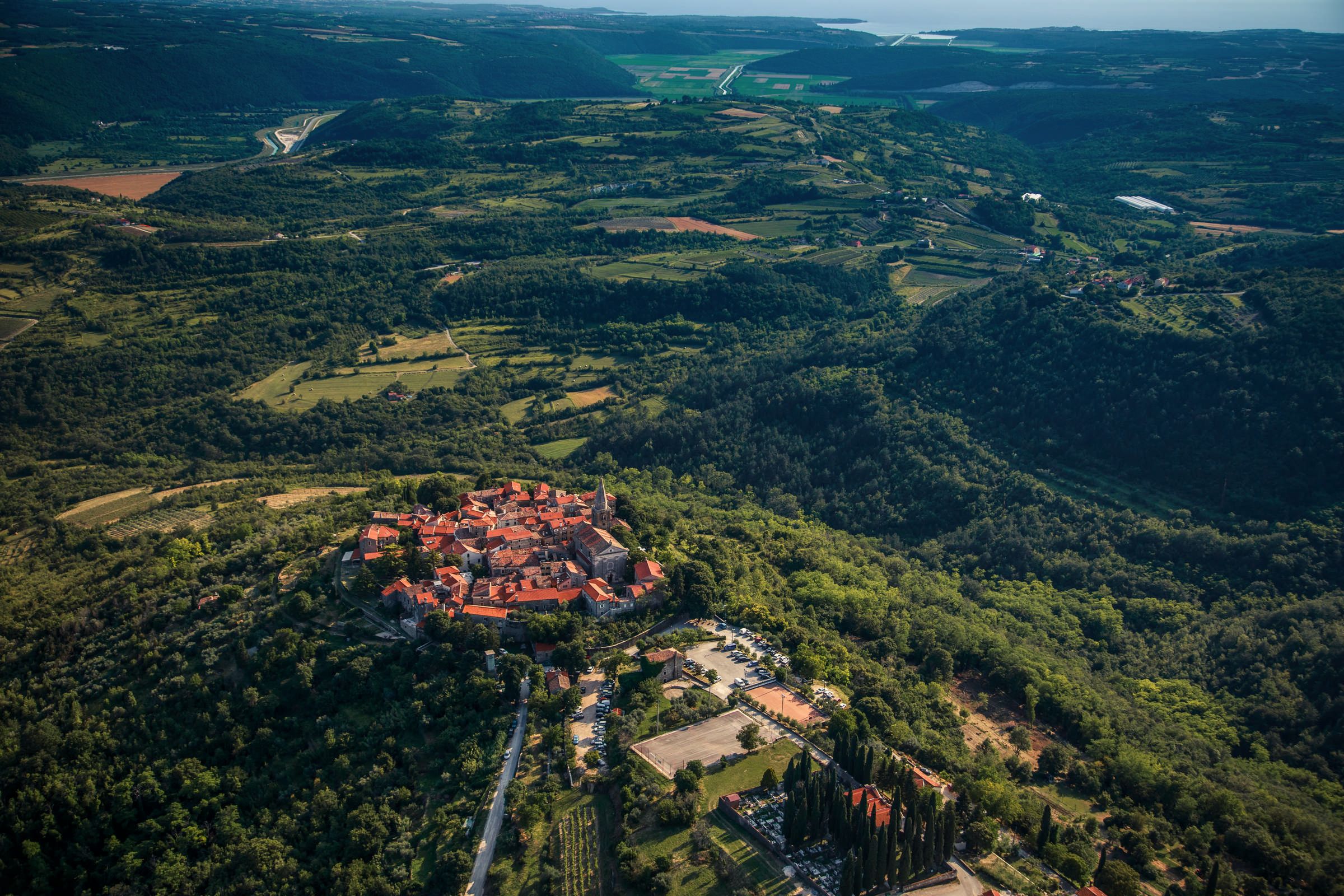
Grožnjan / Copyright Romulić and Stojčić
Today, almost three-quarters of all Italians in Croatia live in Istria County. The only municipality in Croatia where Italians make up a relative majority is Grožnjan in Istria, with 39.4 percent ethnic Italians in the population and 56 percent of the people whose mother language is Italian.
The Italian community's position and rights are guaranteed by the Constitutional Law on Human Rights and the Rights of Ethnic and National Communities of the Republic of Croatia, as well as various international agreements and treaties.
To follow the People Also Ask Google about Croatia series, click here.
People Also Ask Google: How Many Days in Split is Enough?
February 23, 2021 - Continuing the TCN series answering the questions posed by Google's People Also Ask function, this time, one that is asked more often than not. How many days in Split is enough?
This is the ultimate question. And if you really wanted my honest opinion, I'd tell you to stay forever (here is why). Because that is not a reality for everyone, I've set out to find a happy medium for travelers making their way to Split, based on various scenarios, like seasons, main attractions, and those balancing the work-travel lifestyle of a digital nomad.
So, how many days in Split is enough?
While I have been visiting Split since 1996, I only really first fell in love with the city during my first full year here, or once I experienced Split outside of the peak summer months. September is now my favorite month in Split, and the magic of Diocletian's Palace during a brisk bura breeze or a warm spring day on Marjan is beyond compare.
But Split has and always will draw hordes of tourists in the summertime, and it's not difficult to see why. Thanks to its glistening coastline, outdoor activities, bustling city center, vibrant nightlife, and booming culinary scene, Split could equal one of Europe's top metropolitan cities if it maintained the summer buzz year-round.
But there is certainly an argument for each season and how many days are adequate given the time of year. Though I believe it all comes down to preference, in the end.
How many days in Split is enough in the preseason?
Ah, the magic of spring! While Croatia's preseason begins earlier each year, it's safe to say that Easter weekend is the official start of the preseason. However, before COVID-19, many airlines launched their summer flight schedules at the end of March, bringing tourists to Split even before the spring holiday. While there may not be as many connections now given the current circumstances (some airlines are pushing traffic back to May), if there is a will, there is a way - and Split in spring is pure bliss.
You'll notice restaurants and bars reopening after winter hibernation, sunny days and temps in the teens (Celsius), and empty alleyways usually swarmed by tourists in the summer. The biggest crowd you'll find is that of sunglass-clad locals gathering on the Riva for their morning coffee, enjoying every moment of spring sun before the summer storm (of tourists).
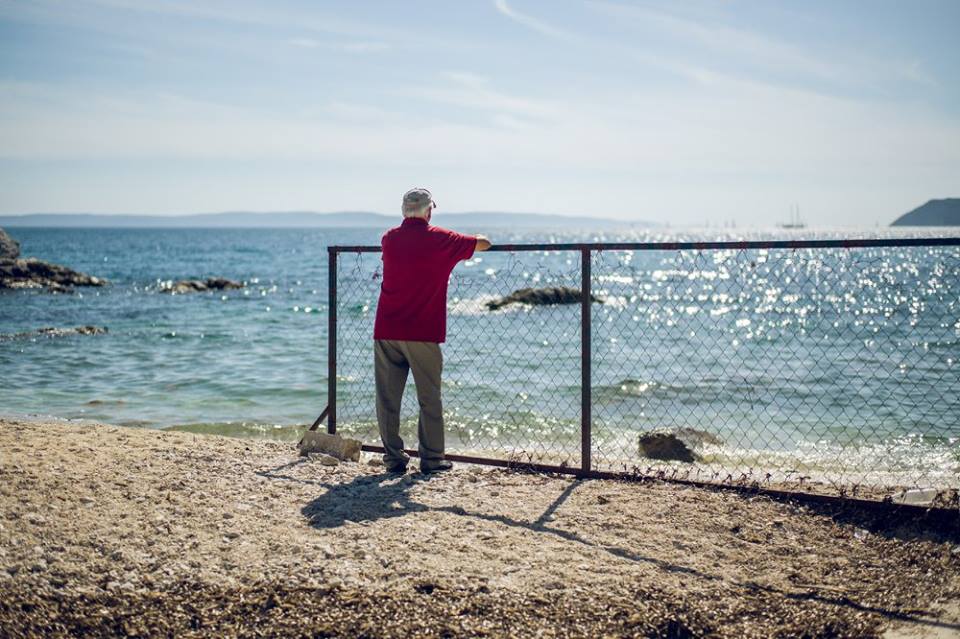
Matthew Christopher Miller
Nature flourishes in the spring. The local green markets are decorated with seasonal charms like wild asparagus and fava beans. Active tourism enthusiasts can hike in the hinterland or enjoy Mosor mountain without the blazing heat.
Spring is also crowned by events, the highlight of which is Split City Day, Sveti Duje, celebrated on May 7 each year. The event gathers thousands of citizens in the center for concerts, boat races, and fairs for days. While we can't say which events will happen this spring, the Croatia Boat Show has been announced for May, bringing the nautical elite, restauranteurs, and tourism reps to Split for five days before the official start of the 'peak' season.
Those of you looking to take day trips to islands will find that Jadrolinija still operates on the winter schedule, resulting in fewer connections (and much of the island closed). Still, those traveling by car can embark on journeys up and down to the coast, and even enjoy cheaper ticket prices at Krka National Park, only an hour away.
Visiting in the spring also comes with friendlier accommodation prices, making it a season with more bang for your buck!
Split in the spring is a sort of re-birth - when the city and its people come alive. While much of the city is just waking up, we suggest you take your time to enjoy the serenity of Split in the spring, and if you stay here long enough, you may even be able to swim.
How many days in Split is enough in the peak season?
Because most people choose to visit Split in the summer, how many days in the peak season is enough?
My honest answer to friends visiting from California is usually no less than five days. Why? Because while Split is a travel hub with access year-round, it is the epicenter of Dalmatia in the summer.
The truth is, those five days are never enough, and the majority of my friends plan to come for a week or more the next time they visit.
But what makes Split so hot (literally) in the summer?
In short, the city is a playground for all types of tourists. Whether you're in your early 20s and want to go bar hopping and nightclubbing until the early morning hours, or rather spend your days at the beach, trying your hand at water sports and rock climbing adventures, or exploring the historic center and its culinary charms, there really is something for everyone here.
And if you grow tired of Split (though highly unlikely)? It's the perfect base for a day trip to the islands, with numerous connections and Brač, Hvar, and Šolta only an hour away. You can hop on the bus or rent a car to visit the UNESCO-protected museum town of Trogir in 30 minutes, or head down the coast for a canyoning adventure in Omiš (but beware of summer traffic). You can tick off Šibenik, Primošten, and Rogoznica on a day trip to Krka National Park and head inland to horseback ride in Sinj (or watch the Sinjska Alka) in under an hour.
Music festivals like Ultra Europe see partygoers stay in Split for a week during the summer, while the Split Summer Festival and Diocletian Days events keep tourists amused with live music and historical entertainment for weeks on end.
The weather is HOT, the sun is shining, the sea is warm, and the air connections aplenty. If you don't mind the crowds or the heat, there is no time limit to Split in the summer. That is if you can afford it.
How many days in Split is enough in the offseason?
Split's shoulder season has become a favorite time for visitors, as September and October offer the perks of summer with usually milder weather and without the peakseason crowds.
The true offseason, however, is usually the quietest time of the year in Split. Some of Split's restaurants go into winter hibernation, as do its people, and empty squares and promenades are a reality in November.
But winter does have its perks, and while locals need some time to rest after a summer of hard work, they come back out to play in December for the festive Advent event. While we didn't get to enjoy it in 2020 due to obvious reasons, Advent usually lasts the entire month of December and into January, where you can ice skate, imbibe on mulled wine and hot gin, and enjoy sausages, live music, and Christmas-themed events.
You’ll also find that many restaurants in Split embrace the colder months with fare destined to warm your bellies, and many restaurants in the city stay true to the classics and traditions of Croatia for the new season to give you a taste of home cooking.
January and February are always the slowest months in Split, and whatever bars and restaurants reopened for Advent may close for 'renovations' until the spring.
But the offseason still offers plenty to do, like visiting its museums (Split City Museum, Meštrović Gallery, and Museum of Illusions are some of the most popular). You can enjoy ballet and musicals at the Croatian National Theater or catch the city's beloved football club Hajduk at Poljud until mid-December before they break until the end of January.
Split is also only a couple of hours away from Kupres in Bosnia & Herzegovina, a hit for Dalmatian skiers in the winter.
Nature never goes anywhere, and you could spend weeks exploring the natural wonders of the region with Split as your base. And if you can brave the winter bura wind, you may want to stay even longer.
How many days in Split is enough to explore Diocletian's Palace?
Now, one of the main draws to Split is Diocletian's Palace - and it's no surprise why. This UNESCO World Heritage Site was once Emporer Diocletian's retirement home, and today it wows world travelers thanks to its beauty and grandeur.
But how many days in Split do you need to explore this 4th-century palace?
It's first important to know that the palace makes up the city center's historic core and is marked by four gates through which you enter - the Golden Gate, Silver Gate, Iron Gate, and Brass Gate. Once you're within the palace walls, you'll notice shops, restaurants, bars, all connected by narrow cobblestone alleyways, which will likely get you lost more often than not.
The palace is also marked by many historical attractions, like the Saint Domnius Cathedral, Peristyle, Vestibule, Temple of Jupiter, and, of course, the famous substructures, or Diocletian's basement.
You could spend all day walking around Diocletian's Palace without really realizing it as local life bustles through, but should you stop to examine the details; you'll want to spend a bit of time here. Some say that a 75-minute walking tour is enough to experience Diocletian's Palace and its 1700-year-old history, which is probably true. But if you were to really embrace the essence of what Diocletian's Palace is for the city today, you'll need at least a few days eating and drinking your way around palace walls, among the locals, to stumble upon all of its charms.
How many days in Split is enough for a digital nomad?
If you're balancing the work-travel lifestyle and are planning on taking advantage of the new digital nomad visa in Croatia, we suggest you make full use and stay a year. Split is a mecca of coffee shops and new coworking spaces. You can enjoy fast internet, good weather, and safe streets. It's also affordable for long-term rentals in comparison to other European cities. Not to mention you'll get to experience everything I've written above - every season, every inch of Diocletian's Palace, and everything that makes Split as special as it is.
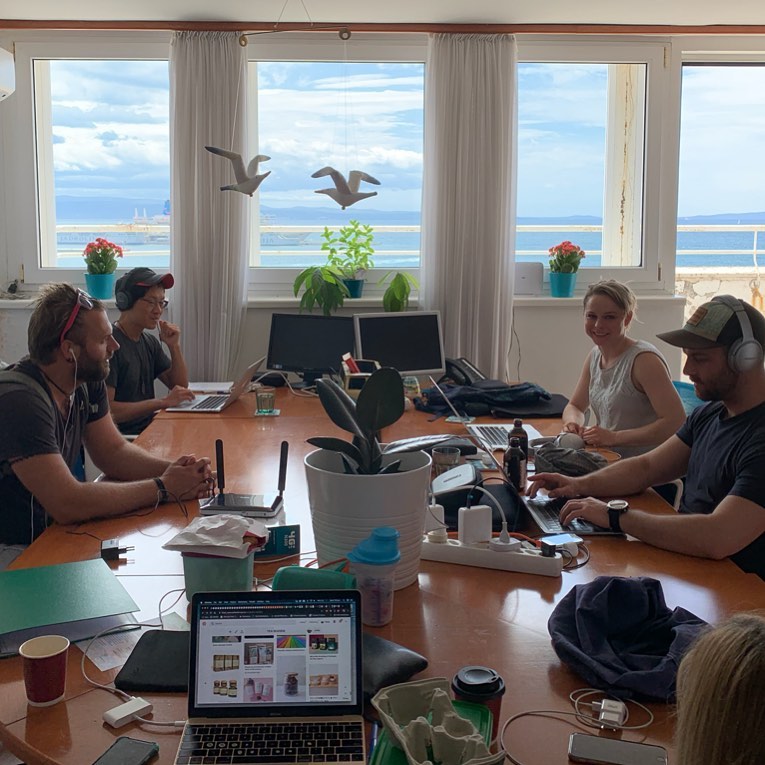
Saltwater Coworking Space
Conclusion: How many days in Split is enough?
All in all, that's entirely up to your time, budget and preference. Truly, there is no number of days too large. I am going on six years here and Split still finds ways to surprise me. You will certainly feel the magic of Split during an afternoon coffee or a night around town, but to truly embrace the essence of the city, do yourself a favor and stay a little longer.
To follow the People Also Ask Google about Croatia series, click here.
People Also Ask Google: Is Porec in Croatia Worth Visiting?
February 21, 2021 – Continuing the TCN series answering the questions posed by Google's People Also Ask function. Is Porec in Croatia worth visiting? The shortest answer would be – of course – and here are all the reasons why.
What is Porec like in Croatia?
Located on the west coast of the Istrian peninsula in Croatia, Poreč can most simply be described as a seaside town with many tourist attractions but also with a rich and indispensable cultural history. It is perhaps best known as the home of the Euphrasian Basilica (so-called Euphrasiana) from the 6th century, one of the seven UNESCO's world heritage sites in Croatia.
However, in the last few years, Poreč has been filling newspaper columns as one of the best cities to live in Croatia, which has been contributed to by its economic, cultural, and social development. A famous tourist town that lives throughout the year? It seems like it could be. Since I have been spending almost every summer in Poreč since I was born, I would unquestionably like to get to know it better from the perspective of living in it. Maybe one day, but for now, I will focus on what I know Poreč is worth visiting for.
Historic center: Is Porec in Croatia worth visiting for culture and heritage?
Apart from the aforementioned Euphrasian Basilica, a must-see cultural site to visit, the whole old Poreč city core is a cultural monument. The peninsula on which the old town of Poreč is located hides historic traces dating back thousands of years. The main street that passes through it – Decumanus – is full of tourists in summer due to its numerous shops and restaurants. At the intersection with Cardo Street, the so-called Dekumanova Street reveals several Gothic and Baroque palaces.

The Euphrasian Basilica in Poreč is one of the most beautiful preserved monuments of early Byzantine art in the Mediterranean.
Built in the 6th century during Bishop Euphrasius, after whom it is named, the Euphrasian Basilica is famous for glittering mosaics dating from the 3rd century. The picture shows the Euphrasian Basilica's apse decorated with Byzantine mosaics.
At the entrance to Dekumanova Street from Sloboda Square, attention is drawn to the Pentagonal Tower, at the top of which is a restaurant. At the top of the nearby Round Tower overlooking the waterfront, tourists love to enjoy a cafe.
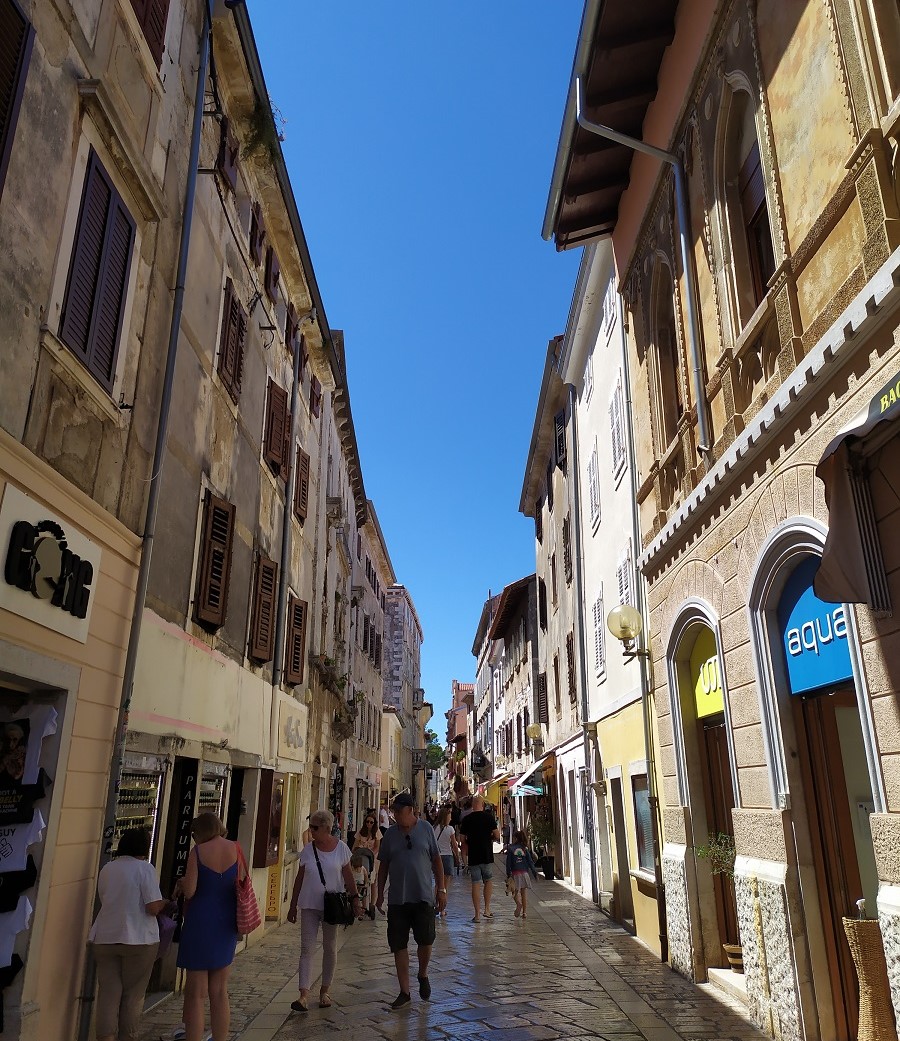
Dekumanova Street / Decumanus Street in Poreč
Evidence of life from ancient times is hidden near the oldest square of Marafor. Also, Poreč is the proud home of the largest Roman shrine in Istria, the Large Temple, and to the north of it are the remains of the Temple of Neptune.
For me, one of the usual evening activities in Poreč is a walk through the old town in the mentioned Decumanus Street, as well as along Poreč's lungomare or Ante Šonja Coast, with a romantic view of the north side of Poreč – Peškera Bay (where the city beach is located), Pical, and Materada. I call it the quiet side because there are no stands on it, for which the other part of the city is famous, just the open sea in front of you, with some lighthouse flashes.
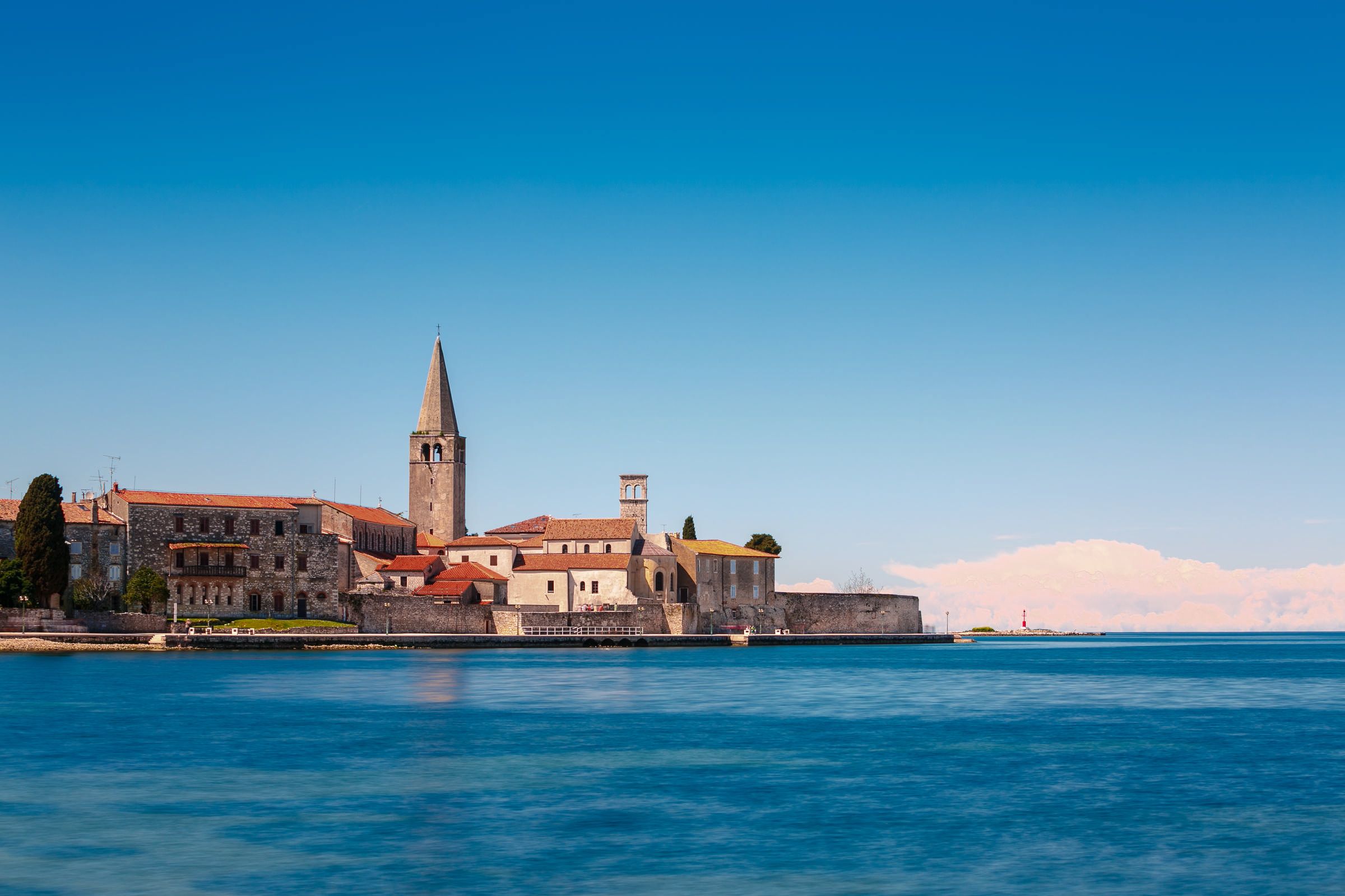
The old town of Poreč and Poreč lungomare / Romulić and Stojčić
I usually continue my walk along the coast to the newly renovated city waterfront, i.e., Marshal Tito's Coast, thus embracing the entire old core of Poreč. I admire numerous yachts, tourist boats, and fishing boats moored in the Poreč port along the waterfront side.
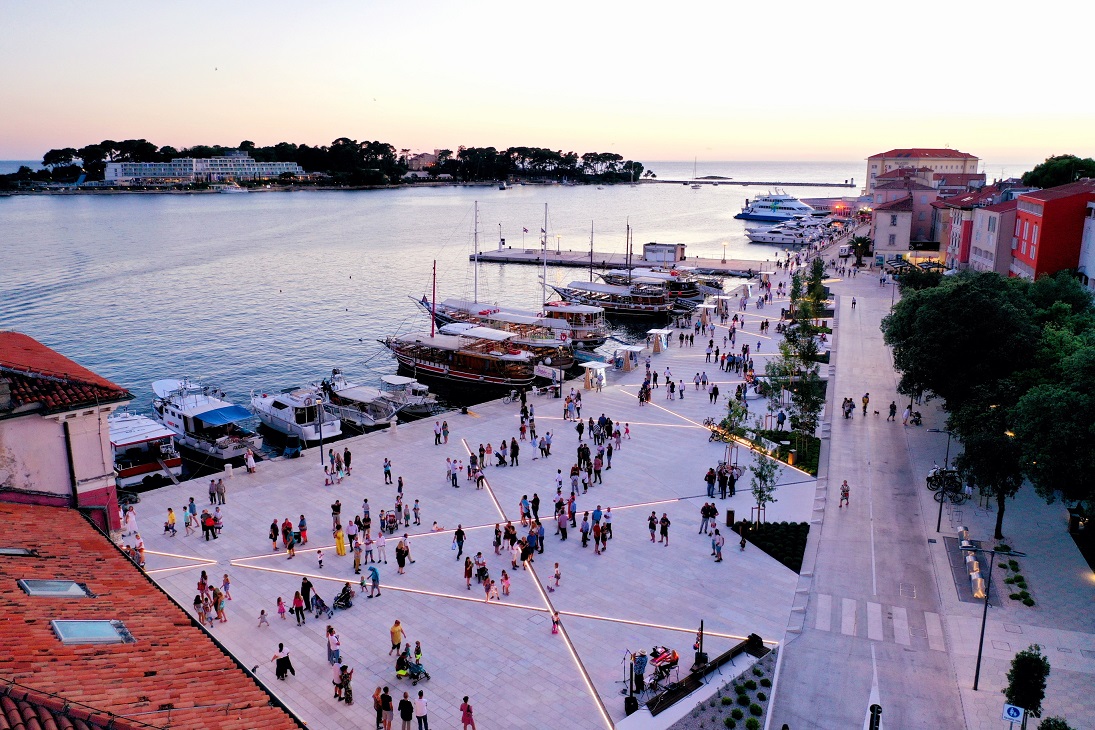
Last year, the Poreč waterfront, an integral part of the Poreč old town, got a new attire – new facilities with signposts to the old town's sights. / Poreč Tourist Board
Is Porec in Croatia worth visiting for beaches and sports activities?
I stayed in Poreč during all stages of my life – from a playful child, through a demanding teenager, to a serious student – and at no time was I bored in Poreč, nor my parents who have been spending their summers in this beautiful Istrian city for almost 30 years. As we are a family that likes a combination of active and lazy holidays, we love Poreč because we get both there – beautiful and clean beaches, as well as many cultural, gourmet, adventure, fun, and sports facilities.
As my all-time favorite activity is rollerblading (and as I'm not a fan of swimming), I enjoy long rides from the center of Poreč along beaches trails. There is a crystal clear sea on one side of the trail, while on the other side, there are various sports and catering facilities. The first beach to reach is Beach Brulo. Located in the mild Mediterranean and sheltered bay, surrounded by pine trees, it is ideal for a real summer vacation.
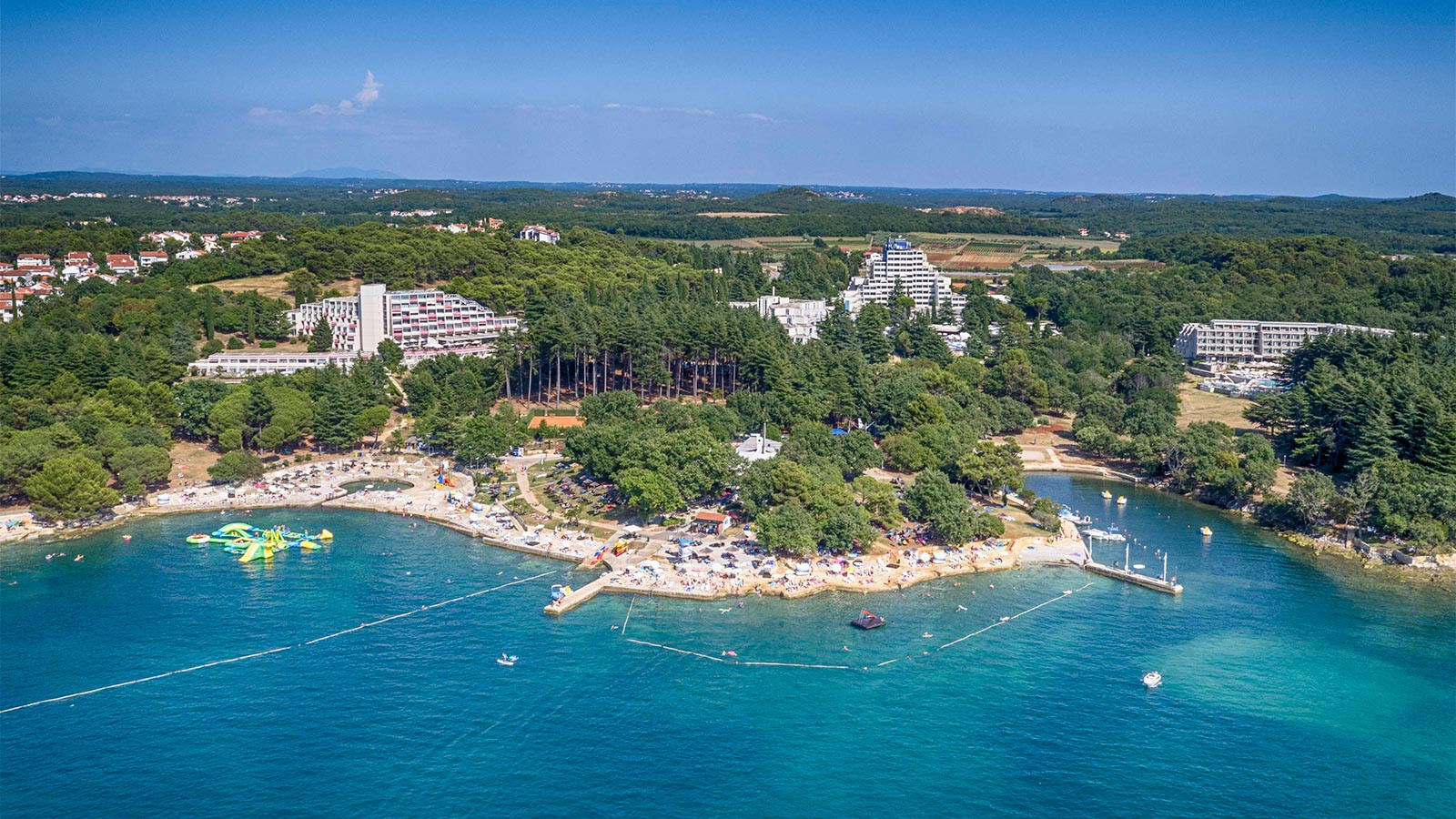
Brulo Beach / Croatian Tourist Board
The trail along the coast goes all the way to Poreč Blue Lagoon, Green Lagoon, and White Bay, beautiful bays and hotel resorts. I recommend the popular tourist train that goes from the south side of Poreč Riviera! Also, If you like cycling and similar recreation, you will love cycling in Poreč.
As there are pebble, sandy, rocky, and concrete beaches, you will indeed find a beach tailored to your needs in Poreč. In 37 kilometers of the Poreč shore, there are as many as 22 beaches with a Blue Flag, an international symbol of clean sea and landscaped coastline. That is as many as 20 percent of all Blue Flags which flutter along the Croatian coast!
What I always liked about beaches in Poreč are numerous fun activities, such as water sports – pedal boats, canoes, paragliding, banana boats, parasailing, aquapark, and sports facilities such as tennis courts, volleyball courts, and mini-golf.
It is important to emphasize that the City of Poreč works tirelessly to provide access to all cultural facilities to people with disabilities. For example, last year, they carried out an adaptation project in the Euphrasian Basilica, and many beaches have been adapted for people with disabilities.
Our all-time favorite daily activity is visiting the Saint Nicholas island across Poreč, also known as Valamar Isabella Island Resort. In the summer months, the island is connected to the Poreč waterfront by a full-day ferry line. The boat from Poreč to the island goes every thirty minutes in both ways. The boat ride takes only five minutes, and the ticket price is 40 kunas (5,30 euros).
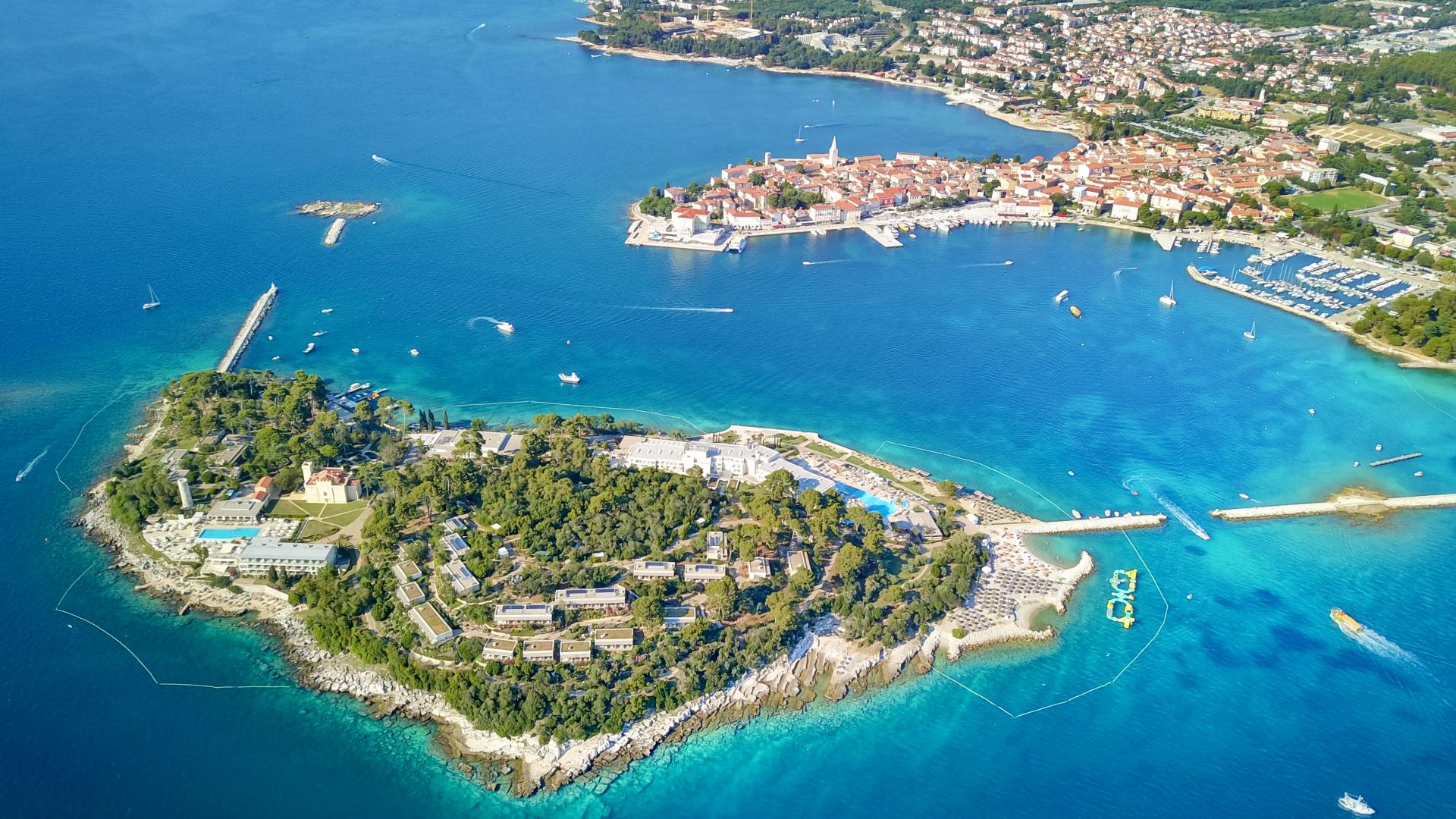
The island of Saint Nicholas in Poreč and Isabella Castle, Valamar Isabella Island Resort / Poreč Tourist Board
I recommend visiting this lovely island across Poreč at least once during your stay to enjoy beautiful, clean, and tidy beaches. It has always been a kind of undiscovered place for my family and me, even before it was renovated by Valamar, the biggest tourism company in Croatia. A nice walk around the island to experience nature's calmness and see the old but now renovated Isabella castle is a must!
On the island and in the whole city, a lot of effort has been put into facilities and activities for children. Along the beaches, you can find numerous children's playgrounds and toboggans. Poreč invests a lot in education, which I witnessed last year when I found out they even have summer tourism workshops for children. Also, children's camps are organized on the beaches, where you can often see many animators with groups of children. There is also a diving school on Brulo Beach.
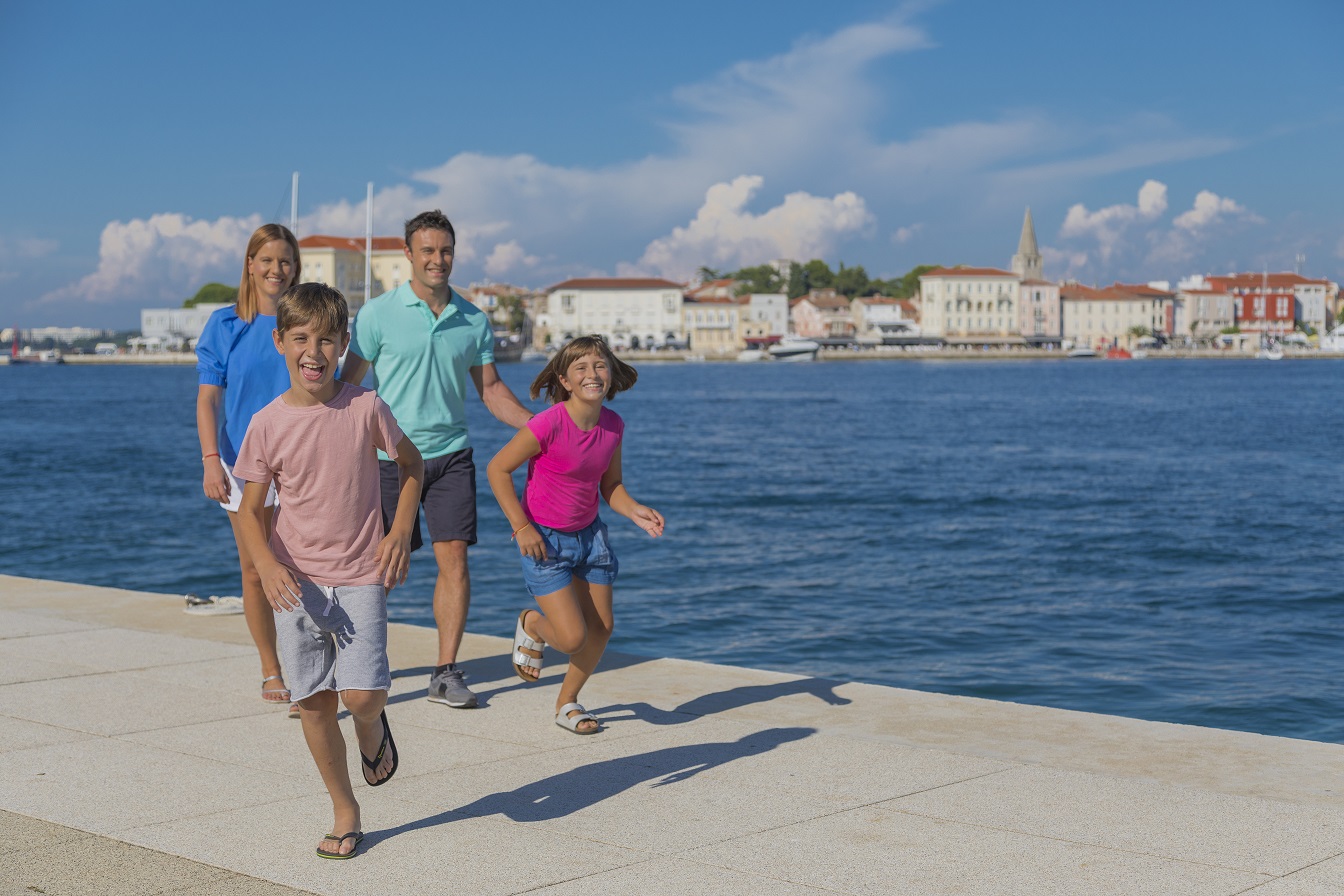
Poreč Tourist Board
Is Porec in Croatia worth visiting for daily boat excursions?
Daily boat excursions from Poreč to surrounding bays and cities are among the most popular activities among tourists. While walking along the waterfront during the evening, when many tourist boats are waiting for their next venture, you can book one-day boat trips to Rovinj, Vrsar, and Lim Fjord, fish picnic trips, and submarine ride. You can also find boats and taxi boats to the nearby Poreč bays, such as Green Lagoon, Blue Lagoon, and White Bay.
One of my earliest travel memories was a one-day trip to Venice from Poreč when I was eight, which I totally recommend. Even though I have seasickness, my first trip to Italy was by boat from Poreč, and I absolutely loved it. Hopping to another country and another city in the middle of your holidays was so exciting back then, and I hope that soon the circumstances will allow the like journeys again.
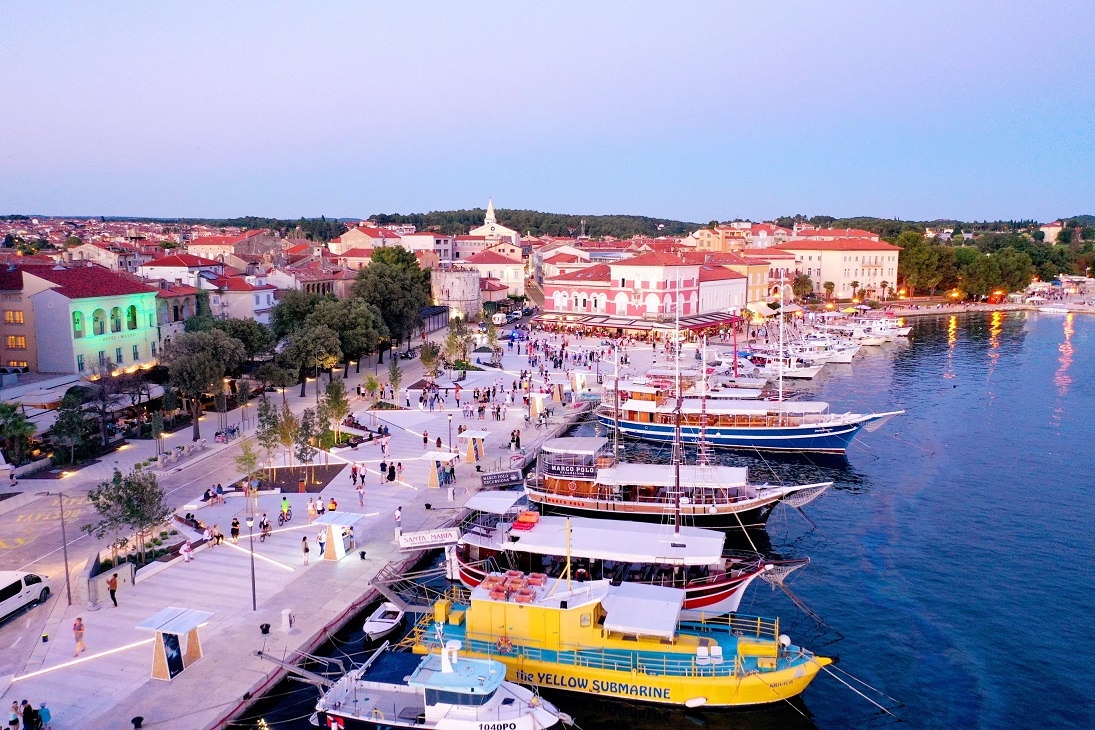
Tourist boats in the Poreč waterfront / Poreč Tourist Board
Is Porec in Croatia worth visiting for nightlife?
Here comes the fun part. During the summer evenings, at the beginning of the city waterfront, you will not be able to miss the sounds of the world's greatest hits and dance rhythms from the famous Poreč club Saint & Sinner.
There is no shortage of night bars and clubs in the city, and the Poreč casino is also popular. Various performers (most often musicians) perform at the summer terraces of hotels and restaurants almost every day. One of the most famous such summer bars is the Lapidarium.
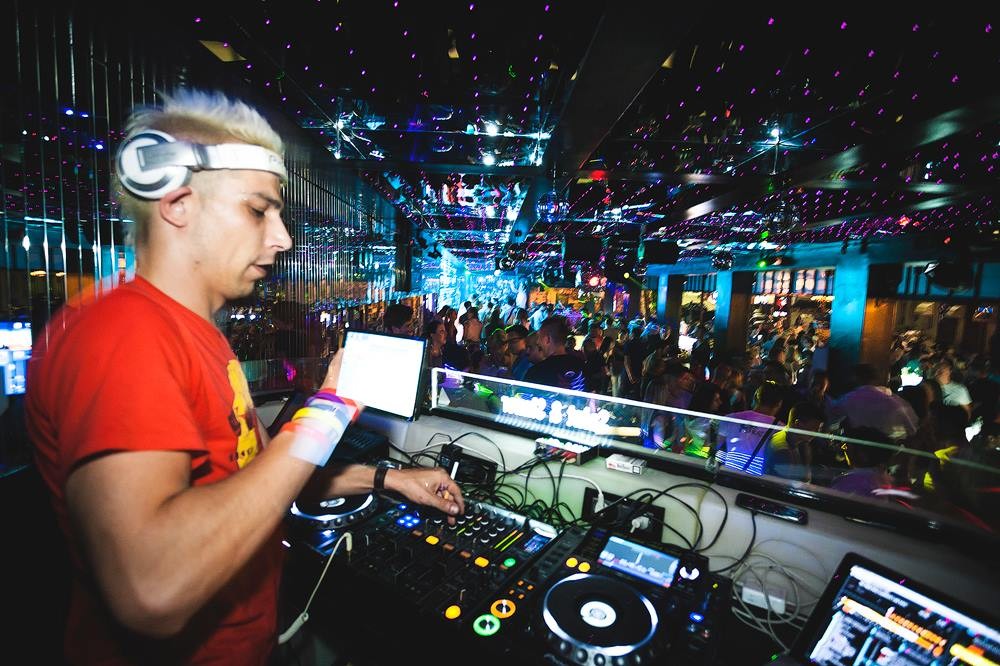
Saint & Sinner / Poreč Tourist Board
At the very top of the Poreč peninsula, at the foot of the Riviera Hotel, music from the attractive Palazzo Club attracts attention. Besides, there are numerous lounge and beach bars by the sea.
I also remember seeing organized transport vehicles around Poreč offering transport services for party people to the nearby famous nightclub Byblos. I'm sure I'm not the only one who is nostalgic about crazy summer parties! Last summer, it was relatively quiet in Poreč, but let's hope for the better in the upcoming summer season.
As for parties, Poreč is also known for hosting Poreč Open Air Festival, an all-summer-long festival that consists of street performances, music nights, cinema, theatre, and special events. The MTV Summerblast in Poreč was also held, but due to the current situation with the coronavirus, the holding of all festivals is uncertain for now.
Is Porec in Croatia worth visiting for gastronomy, adventure, and education?
Although the temperatures in Poreč are high and the sea is warm, I will not lie - almost every year, I experience one rainy day during holidays. However, such days allow me to explore Poreč and its surroundings.
In addition to the many hotels and apartments, many famous restaurants and cafes in Poreč offer only the best Istrian delicacies. Getting to know the local specialties is an indispensable part of getting to know the destination. In Poreč and Istria, those are, among others, truffles, olive oil, Istrian prosciutto, Istrian boškarin beef, asparagus, and seafood, offered in best of Poreč offer. Along the Dekumanova Street in the old city core, you can find many patisseries with ice cream.
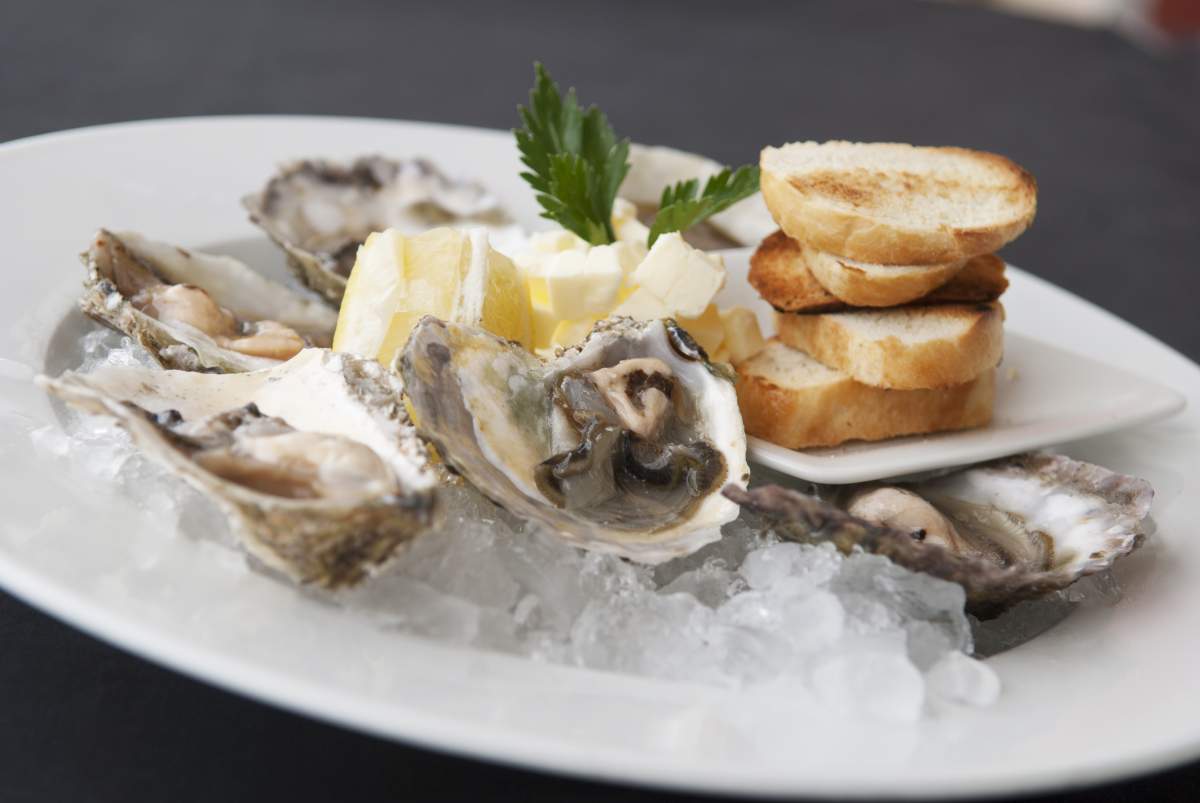
Istrian food - scallops, mussels, oysters / Poreč Tourist Board
I don't have to emphasize the importance and popularity of Istrian wines and wine roads. One must taste them when in Poreč, but what surprised me last year was the favorite activity of Istria people – truffle hunting. It was the best activity for me in the whole visit to Poreč and Istria the previous year, and it is worth experiencing!
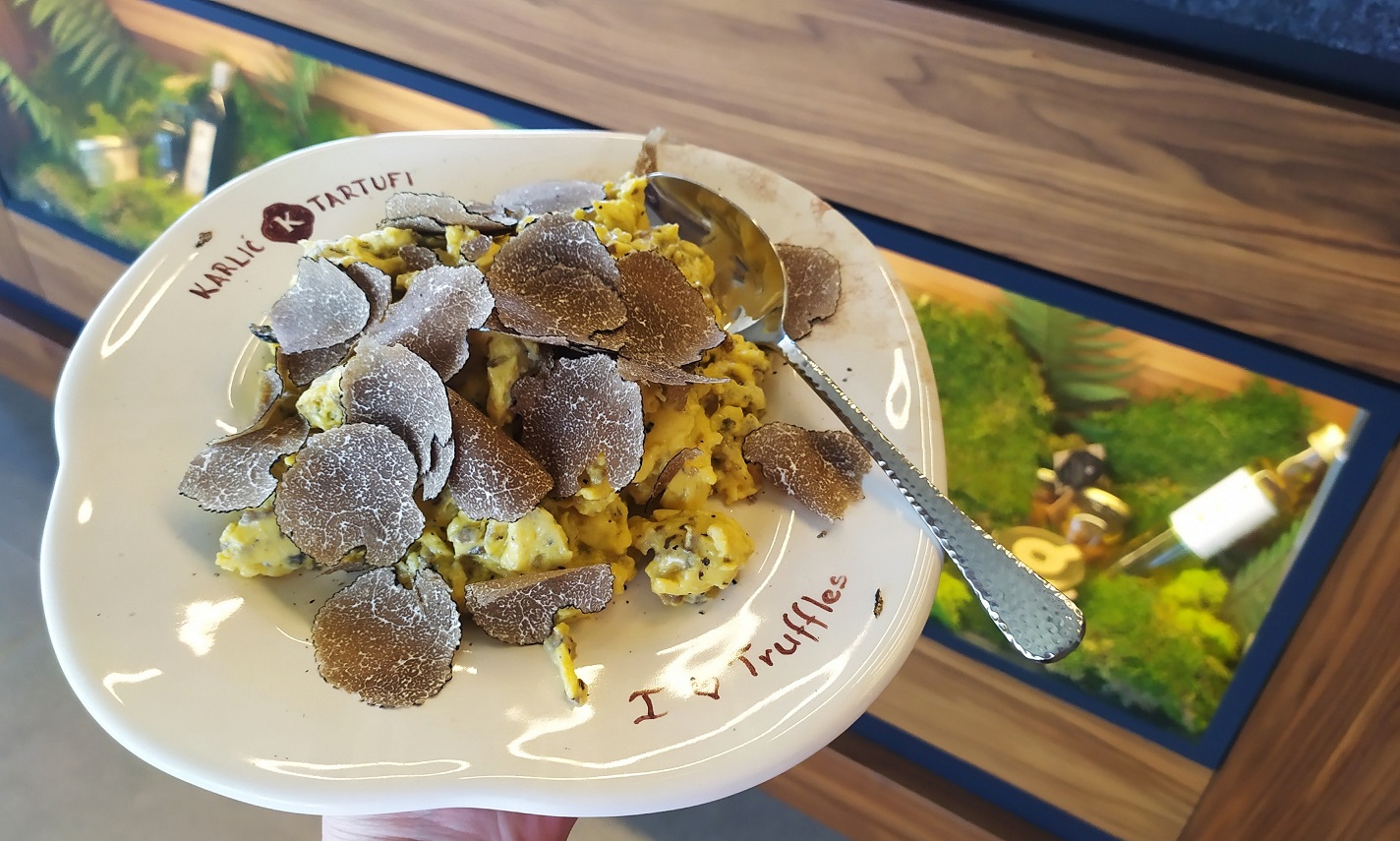
As part of a truffle hunting tour, we ate an Istrian specialty - scrumbled eggs with black truffles / Donatella Pauković
And since Istria has been named the best olive oil region in the world for the sixth consecutive year, my next visit will for sure include olive oil roads in the Poreč hinterland.
Near Poreč, there are many entertainment and educational facilities, such as Motodrom Poreč with karting. In addition to karting, many other activities are offered: bigfoot riding, cross-kart driving, segway, quads motor wheels, paintball, and Adventure Park SkyFox. It is possible to ride horses in the nearby horseriding centers in Poreč.
Motodrom Poreč / Donatella Pauković
A few years ago, we spent a day visiting the Baredine Cave, at the bottom of which we saw one of the few specimens of a human fish. I recommend the Baredine Cave if you get bored of the heat because by descending to a depth of 60 meters, the air temperature also drops to 14 degrees Celsius, which is a shock compared to the outside 30 degrees during the summer days.
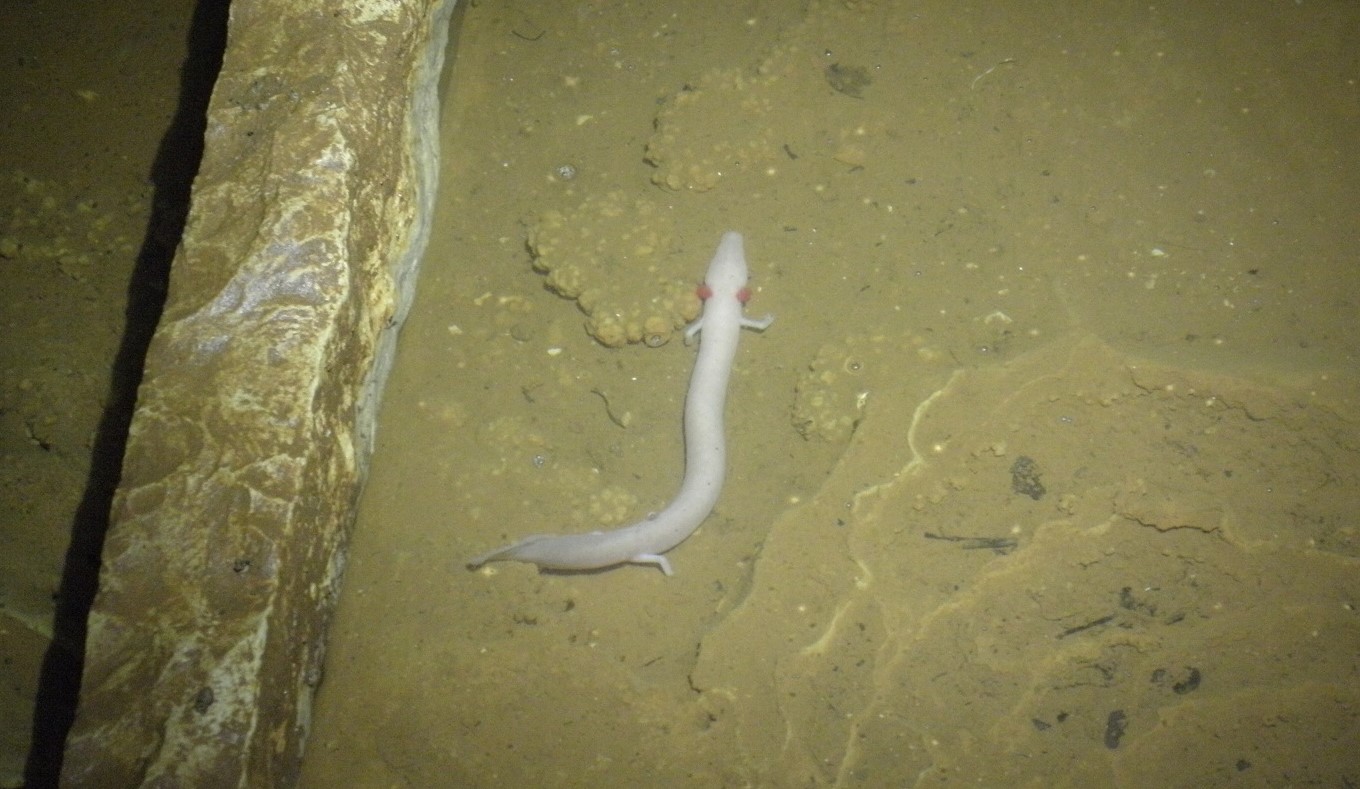
Human fish in the Baredine Cave near Poreč, Istria / Donatella Pauković
If you want to get the best from water experience, near the tourist resort Zelena Laguna in Poreč, you can enjoy the largest Croatian water amusement park – Aquacolors Poreč. Also, the attractive Aquapark Istralandia, recently named fourth best water park in the world, is only a 20-minute drive from Poreč.
If you want to learn something about astronomy, the Višnjan Observatory, one of the 12 most productive observatories in the world of all time, is 16 kilometers away from Poreč. During 2018 and 2019, the Observatory discovered and documented over 1,400 asteroids, and recently, as part of a crowdfunding campaign, they secured funding for further investment in scientific and educational facilities.
Conclusion: Is Porec in Croatia worth visiting?
Suppose you want to have active holidays, then yes. In that case, Poreč is worth visiting because it offers a combination of lovely beaches, city sights, beautiful sunsets, rich culture, numerous sports and adventure activities, great food, and even a great nightlife. Poreč simply has it all.
I have visited Poreč countless times in winter when it turns into a quiet town without tourists, and I would always rejoice to see some pizzerias, restaurants, and cafes open even during the winter. Poreč is also a host to many sports teams during winter, who do the preparations for sports competitions in six Poreč sports halls. Did you know that Poreč will soon even have a football camp? It is the result of a long-term investment in sports in Poreč.
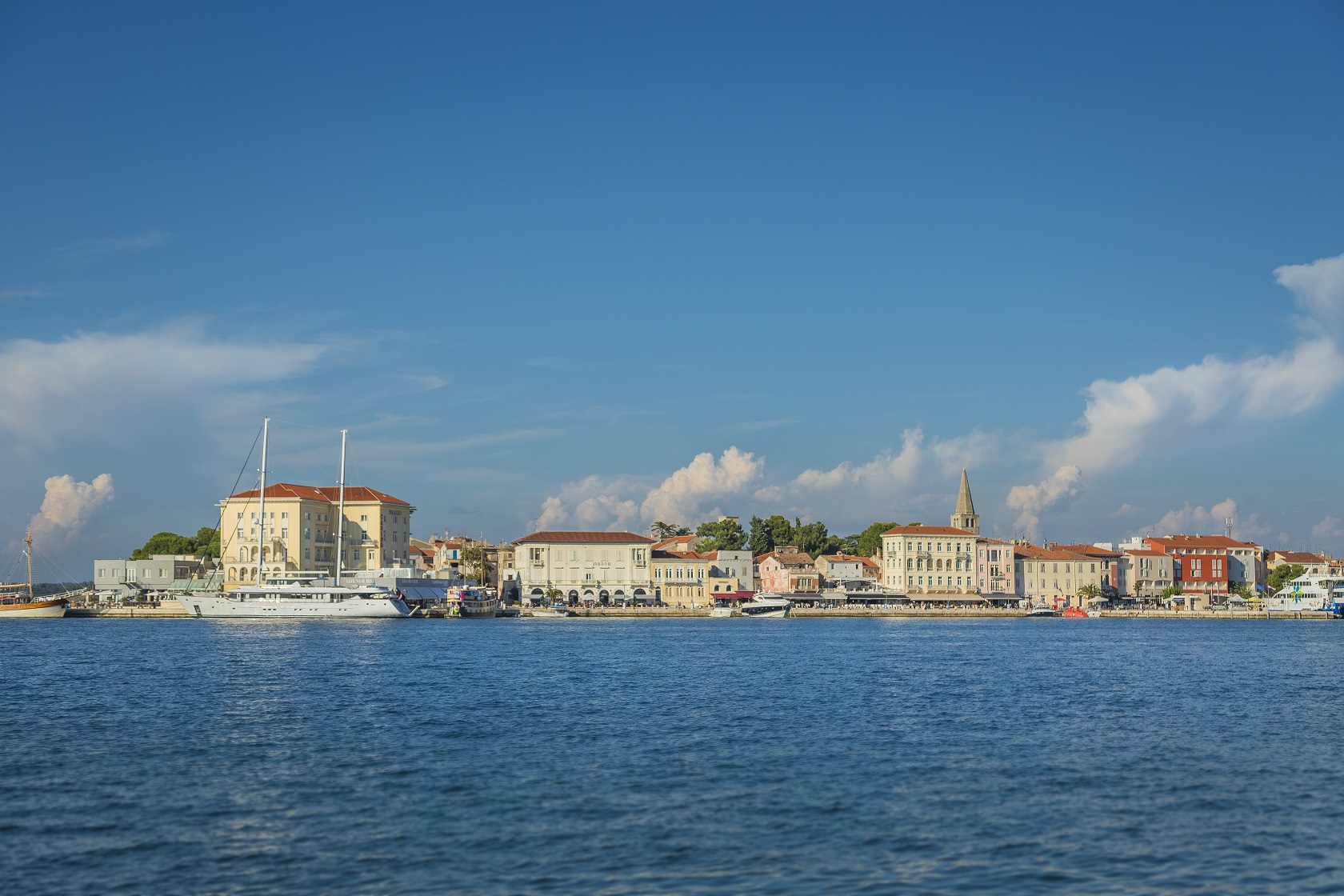
Poreč Tourist Board
It is fascinating to me how every Croatian city and place hides many interesting facts, and sometimes it is challenging to discover them all in one visit. Therefore, I know there is a lot more to do and see in Poreč, and I can't wait to revisit it.
Although I have traveled a large part of the Croatian coast in my 24 years and the mainland, I think there is always something new to explore in Croatia, and I'm looking forward to finding out more about my beautiful country in the future.
To follow the People Also Ask Google about Croatia series, click here.
People Also Ask Google: When is the Best Time to Visit Croatia?
February 20, 2021 - Continuing the TCN series answering the questions posed by Google's People Also Ask function, one I get asked a LOT. So when is the best time to visit Croatia?
From the best Christmas market in Europe in December, to idyllic island beaches or some of Europe's top music festivals in July, there is plenty for everyone in Croatia. So when is the best time to visit Croatia? Part of the answer, of course, depends on what you are looking for. But the good news is - there is never a bad time to check out this fabulous country.
Is it safe to travel to Croatia right now?
Before we begin, let's deal with the corona elephant in the room - is it even safe to travel to Croatia right now? I will leave the debate on whether or not one should be travelling at all during a pandemic to others. The situation in Croatia is changing all the time. At time of writing (February 20, 2021), it seems that we are easing towards a relaxing of measures and the reopening of bars and restaurants. Croatia has tried to stay as open as possible during the pandemic. Indeed it was the only country in the EU to welcome Americans and non-EU citizens last year.
As things are changing, the best place to find current advice as you read is via the daily Croatia Travel Update. If you need a question answered quickly, the Total Croatia Travel INFO Viber community has helped hundreds if not thousands since it was formed in May, 2020. You can join here (you will need to download the Viber app).
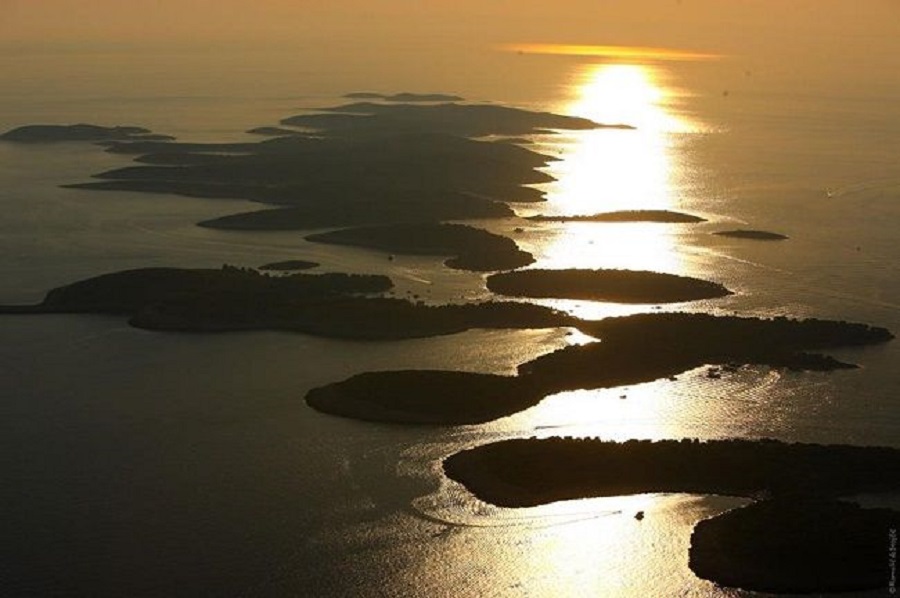
(Photo Romulic & Stojcic)
Which part of Croatia is the best to visit?
This obviously depends what you are looking for. Most tourists come for the sun and the beach, which Croatia has in abundance. With some 1,777 km of coastline and more than 1,000 islands, there are plenty of option to find your perfect spot.
The capital of Zagreb is emerging as a trendy destination in its own right (and was Lonely Planet's best destination in Europe in 2017). Historic cities such as Dubrovnik, Split, Zadar, Sibenik, Pula and Rovinj are also fantastic draws, while islands such as Hvar, Brac, Vis, Korcula, Mljet, Krk, Cres and Losinj all offer an authentic island experience, each unique in its own way.
But try not to miss continental Croatia, which has many hidden gems and the warmest and most welcoming people in Croatia. If you are looking for authentic experiences and traditions off the beaten track, this region has them in abundance.
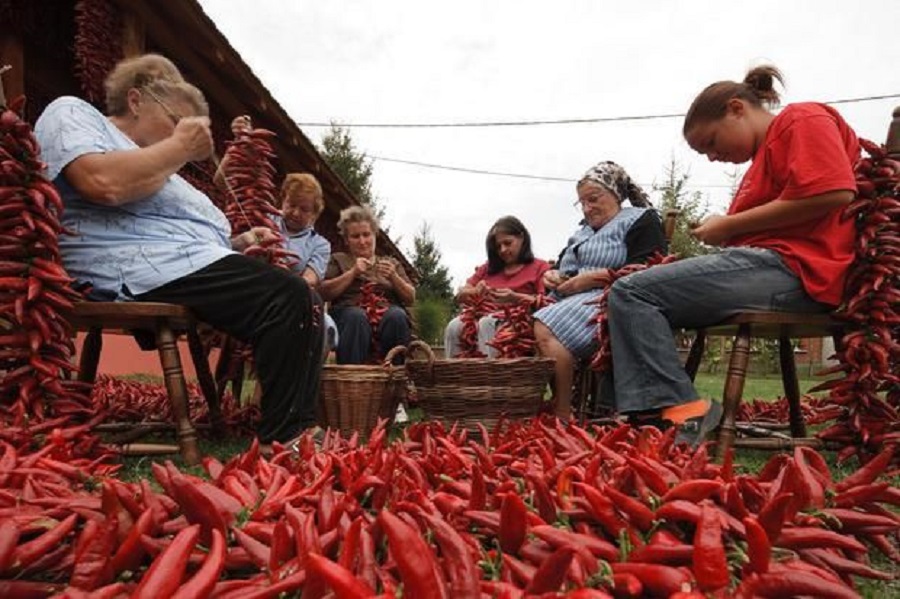
(Photo Romulic & Stojcic)
Croatia is also a foodies delight. With no national cuisine as such, from the truffles of Istria, seafood of Dalmatia, and hearty meat and river fish dishes of Slavonia, a culinary tour of Croatia is truly like no other. And that is before we have started talking about the wine...
What month is the best time to go to Croatia?
Again, that really depends on what you are looking for. I wrote an article some time ago, breaking down the advantages of each month - Visit Croatia in April: Easter Traditions and the Start of the Season. Let the Swimming Season Begin! May in Croatia. June in Croatia: Summer without the Crowds. Visit Croatia in July: Peak Season Beach Heaven. Festivals, Beaches, and Parties: Croatia in August. For Gorgeous Weather and Emptier Beaches, Visit Croatia in September. An Indian Summer in Europe: Croatia in October. Olive and Wine Heaven: Visit Croatia in November. Advent in Zagreb and Elsewhere: December in Croatia. A Tourism Giant in Its Quietest Month: Croatia in January. The Best Time to Visit the Pearl of the Adriatic: Dubrovnik in February. Emerging from Winter Hibernation: March in Croatia.
You can read When to Visit Croatia: Your 12-Month Guide to Paradise here.
What is the best time to visit Croatia for the weather?
Sun worshippers rarely go wrong with July and August, when the beaches are full of the bronzed and the beautiful. As important as the air temperature for many is the sea temperature. If you are researching your trip, you can check the normal sea temperature here, as well as the quality of the beaches you are planning to visit.
The swimming season is generally May to October, but there are several people who swim all year round. If you find yourself celebrating the New Year in Hvar Town, for example, the Polar Donkeys will welcome you on their traditional New Year's Day swim.
If you are not a fan of really hot temperatures, which can get into the high 30s in peak season, the shoulder months of May, June, September and October are usually really pleasant on the coast. September was always my favourite month on Hvar, both weather-wise and for the lifestyle after the busy season.
If you are interested in more on the weather in Croatia, including fun facts such as the hottest day or strongest bura wind recorded, check out the Total Croatia Weather in Croatia feature article.
What is the best time to visit Croatia for party tourism?
I lost count of the number of people who contacted me over the years in April, May and late September:
"Where are the clubs and the famous Hvar nightlife?" was the usual theme.
Croatia is generally not - not yet, at least - a year-round destination, and the party tourism angle is VERY limited in terms of time. Mid-June to early September is when it all happens. Hot spots include Split for Ultra Europe in July, and Zrce beach on Pag with several festivals throughout the summer, as well as Tisno on Murter. Zagreb too has a reasonable music festival scene, including the INMusic festival in June.
This was all in the pre-COVID-19 era of course. How much will party tourism return to Croatia? One of many unanswerable questions in these uncertain times.
When is the best time to visit Croatia for flights?
Flights to Croatia are seasonal. VERY seasonal. Again, corona will have its impact, but the coastal airports of Dubrovnik, Split, Zadar and Pula all do the bulk of their business in the three months over the summer. Split services more than 100 destinations in July, but less than 10 in January to give you an idea.
The situation has improved immensely on how things used to be, ever since Ryanair started the budget flight revolution in Zadar in 2007. The season has been getting gradually longer, and airlines such as easyJet and Euro Wings are very established on the market. They tend to start operations in March, gradually increasing routes and rotations as the weeks go by, before starting to reduce from September and stopping for the year in November.
There are (or were) some great bargains to be had, but prices can go up dramatically. How the market will react post-pandemic is anyone's guess.
As the capital city, Zagreb has many more international connections throughout the year, with the tourist season bringing more flights to the capital.
For the latest flight announcements to Croatia in these uncertain times, follow the TCN flight news section.
And so to some of the top destinations in Croatia...
When is the best time to visit Plitvice National Park?
There is no destination quite like Plitvice Lakes National Park. Apart from being one of Croatia's top tourist attractions with over a million visitors a year, as well as being a UNESCO World Heritage Site since 1979, Plitvice has four VERY distinct seasons. They are called Winter, Spring, Summer and Autumn/Fall. And they offer a VERY different experience. Check out winter in one of my favourite Croatia videos of all-time, from the one man and dog team of Outdoors Croatia.
Now check them out again a little later in the year. This video has some excellent advice for those visiting Plitvice Lakes - "Best way to avoid the crowd is to enter the park early and then later, after 10am rent a wooden rowing boat."
When is the best time to visit Dubrovnik?
Dubrovnik was GLORIOUS in July 2020 when I visited. Without the crowds and with the summer weather, it was a true joy to behold. In normal seasons, however, overtourism and Dubrovnik have become almost synonymous. There are challenges ahead for the destination, and it will be interesting to see how it develops.
In normal years, mid-June to mid-September sees the Pearl of the Adriatic packed. Day-trippers and cruise ship passengers add to the throng already staying in the city. Everything is crowded, it is hot, and while popular, it is a time of year I avoid Dubrovnik completely. The shoulder months are much more pleasant, both in terms of crowds and milder temperatures. For me, however, the very best time to visit Dubrovnik is the first week of February. This is when the city celebrates the Feast of Saint Blaise, its beloved patron saint. The city is filled once more, but this time with locals celebrating their proud traditions. This is how it was for me when I went a few years ago.
Learn more about Kings Landing in the Total Croatia Dubrovnik in a Page guide.
When is the best time to visit Split?
Split has undergone an extraordinary transformation in tourism in the last 15 years. Once known simply as the Gateway to Dalmatian Islands, the Dalmatian capital has emerged as one of the hottest destinations in Europe.
As with Dubrovnik, the summer crowds can be a little off-putting, but the season is considerably longer now. Things start to pick up considerably after Easter until November, and Advent in Split is growing as an attraction. The old town of Split, aka UNESCO World Heritage Site and former Roman Imperial retirement home, Diocletian's Palace, is much more of a living organism than the old town of Dubrovnik, with many more locals still calling it home. As such, it has more year-round appeal, at least in my opinion.
Don't miss the festivities of the patron saint, Sveti Duje on May 7 each year. If you are music fan - or if you are not - the city is transformed each July, as the largest electronic music festival in Europe, Ultra Europe, takes place in the city in July. Embrace or avoid totally, depending on your inclination.
Learn more about the Dalmatian capital in the Total Croatia Split in a Page guide.
When is the best time to visit Istria?
If you are a foodie, it is ALWAYS a good time to visit Istria. With the possible exception of Zagreb, Istria is the region least affected by seasonality. Those coming for the beach and swimming should veer towards the summer months, of course, but Istria is developing an identity as an all-year food and activity destination. Cycling around the vineyards past those idyllic hilltop mountain villages is heaven indeed.
Learn more about this fantastic region in Istria: 25 Things to Know About the Terra Magica, a Croatian Jewel.
Is Zagreb worth visiting? The best times to visit the Croatian capital.
Absolutely! A few years ago, some German media reported their opinion that Zagreb was the most boring capital in Europe. And, at the time, I agreed with them. But Zagreb has undergone a total transformation in recent years. Now that I am a regular visitor, having relocated from Hvar to Varazdin a few years ago, I can honestly say that I prefer Zagreb to going to the coast these days.
It is at its most glorious in Spring, with May a particularly delightful month. Summer is also nice, as many of the locals have decamped to the coast, allowing a lot more space for those who visit - a welcome contrast to the mayhem on the coast.
And Christmas wouldn't be Christmas without Advent in Zagreb.
Learn more about the Croatian capital in the Total Croatia Zagreb in a Page feature.
Is Hvar worth visiting? A look at visiting Croatian islands throughout the year.
I lived on Hvar for 13 years. It was as magical in January as it was in July, but for very different reasons. The UNESCO Za Krizen procession just before Easter is incredible, my favourite time of the year. The beaches start filling up from mid-May until late September, with peak season in July and August. September and the grape harvest, followed by the olive harvest in October and November shows the true essence of life on this magical island. September is the best month overall - peak season crowds have gone, locals start to relax after the busiest part of the season, and the temperatures are much more pleasant.
It is a similar story on all islands. One thing to bear in mind, however, is that the Jadrolinija ferry schedule changes from summer to winter schedules and vice versa. These changes usually occur in late May and at the end of October. There are considerably less ferries available in the winter schedule, which might affect your island-hopping plans.
Learn more about Croatia's premier island in the Total Croatia Hvar in a Page feature.
So when IS the best time to visit Croatia? The answer depends entirely on you and what you are looking for.
Is there something you would like to see added to this article, or do you have some information to contribute to make it better? Please contact us on This email address is being protected from spambots. You need JavaScript enabled to view it. Subject Google when to visit.
What else are people interested in about Croatia? Check out more in our People Also Ask Google section.
People Also Ask Google: What is a Typical Croatian Breakfast?
February 18, 2021 - Google knows what people are searching for, and there are clues in the 'People Also Ask' prompt. So let's start answering - what is a typical Croatian breakfast?
Having grown up in the US, I love breakfast. Not only is it the most important meal of the day, but it tastes good at any time of the day - and I've certainly had my fair share during lunch, dinner, and dessert. From pancakes, crispy bacon, home fries, and scrambled eggs at divey diners to eggs benedict brunch extravaganzas, breakfast is one meal America does right.
So, what do Croatians eat for breakfast?
Experiencing the breakfasts of my homeland, however, turned out to be a harsh reality I discovered on my first trip to Croatia in 1996.
Not yet six years old, I remember sitting in the kitchen of my grandparent's home in Kosa, a small village 15 minutes from Metković. My mother, the oldest of seven siblings, was back in the kitchen where she was raised before moving to Split at 16.
"Mama, I'm hungry," I said, familiar with mornings that included a variety of sugary cereals, chocolate milk, fresh-squeezed orange juice, or french toast.
A chewy loaf of white bread was presented before me, along with butter, pašteta, and rosehip jam. At least I had options.
Visiting Croatia as I grew older, and especially in my later teen years when indulging in Hvar town nightlife was a rite of passage among my paternal cousins; that soft loaf of bread, while nostalgic, wasn't going to cut it. We'd often find ourselves looking for anywhere that had a sign outside with the word 'omelet' (even though only cheese or ham was ever an option) and would beg for a morning order of fries on the side if only to desperately mimic the hangover breakfasts back home.
And if there was no omelet to be found? We'd hunt for the greasiest burek in town.
But that was well over a decade ago. While some Croatian breakfast staples have been maintained, many citizens (and restaurants) have evolved their morning routine to cater to breakfasts reminiscent of our western friends.
What is a traditional Croatian breakfast?
“Turkish coffee and a cigarette.”
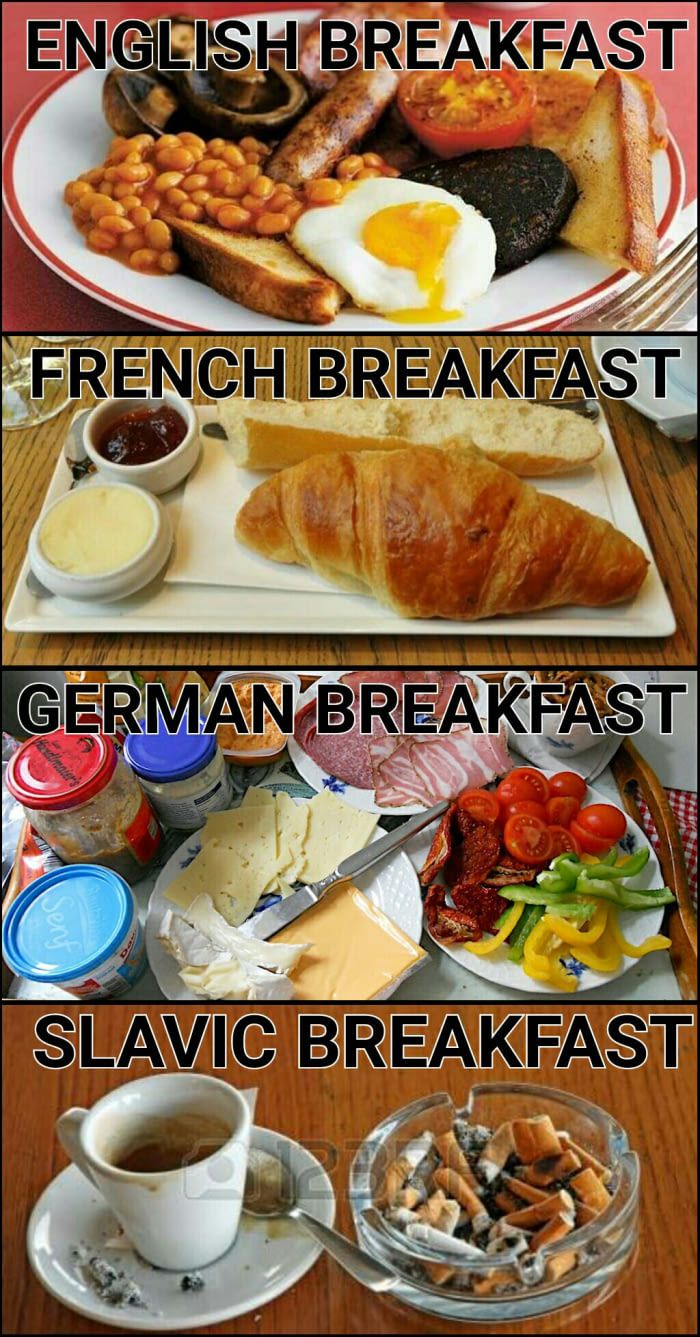
While it may be one of the most popular breakfasts among some Croatians, there are quite a few other traditional morning meals.
Like I mentioned above, Dalmatians are partial to cold cuts, cheese, pašteta, and bread. Some on the coast prefer to keep it light and will opt for anchovies instead.
It’s not unusual to find slimy pancetta or lard spread on bread in continental Croatia, pork-fat inspired dishes in northern Croatia, while the Istria region is famous for its asparagus and truffle frittata.
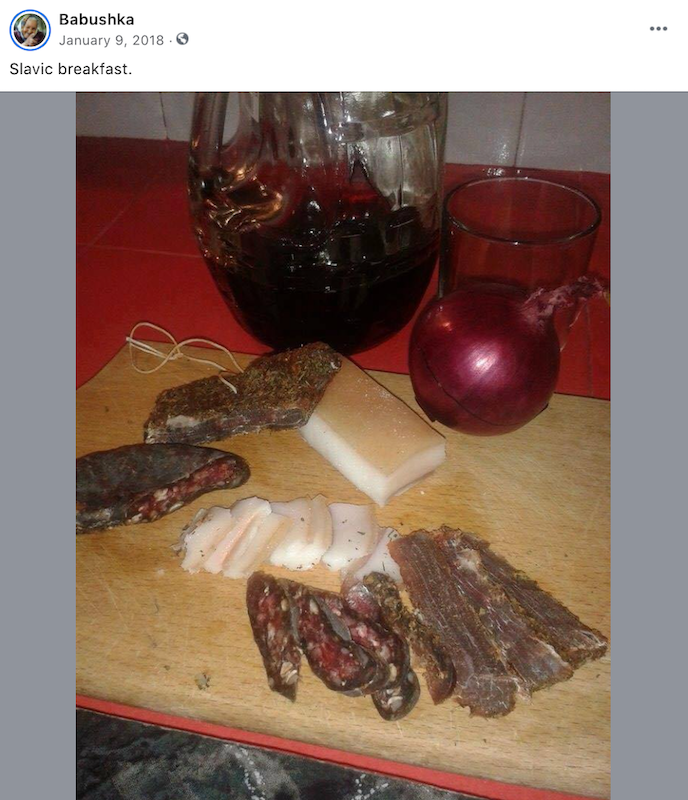
Your breakfast cold cuts may even be served with pickled onions or gherkins, a box of Napolitanke, Jadro, or holiday cookies defrosting from the freezer, but only one thing is certain - there is no breakfast in Croatia without coffee. Consider eating is a bonus.
What are Croatian breakfast pastries?
While we more or less covered some traditional breakfast items in Croatia, others may have never been intended for breakfast but are now enjoyed in the morning by both locals and tourists in Croatia.
Burek (with cheese) is by far the most famous. This Croatian classic is usually made with phyllo dough and cheese, while other fillings such as meat, potato, and spinach can also be found. A staple at most bakeries across the country, this cheap to-go treat can also be enjoyed with yogurt to ensure a hearty breakfast meal.

Unlike burek, bučnica is a strudel-like pastry containing pumpkin, cheese, butter, and eggs. Served with sour cream, bučnica is Croatian comfort food that even ticks off a few of the food groups!
Croissants, strudels, and various other Croatian cookies and pastries have made their way into our mornings and are often found for a few kunas at bakeries like Bobis, Dubravica, and the like.
What do Croatians eat on holidays? Croatian Easter breakfast
The holiday breakfast in Croatia that stands out the most is certainly Easter. Easter is a holiday with many breakfast traditions around the country, like cooked ham, boiled eggs, spring onions, radishes, and the sweet star of the show - sirnica (or pinca), a fluffy Croatian Easter bread topped with crushed sugar.
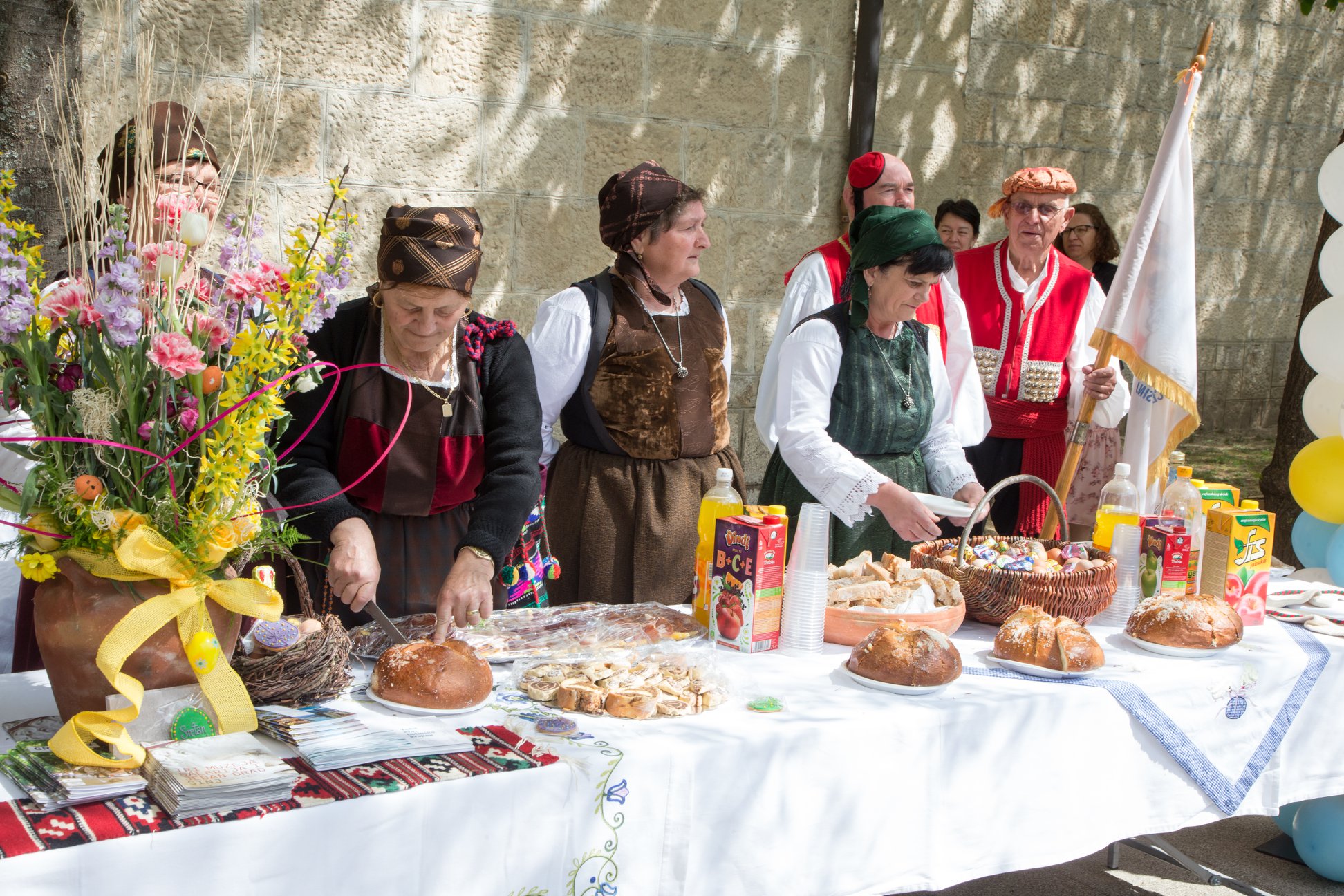
Easter in Sinj - Foto Žižić
Traditionally from Dalmatia, sirnica is a trademark of Croatian Easter tables today, so much so that bakeries around the country begin selling the bread months before the holiday - and some year-round!
What is a typical Croatian breakfast today?
It's 2021, so it's no surprise that Croatia's breakfast eaters have adapted to today's trends. Many children will have yogurt and a banana before school; others may enjoy a bowl of Chocolino cereal, while eggs have become much more commonplace on today's breakfast tables. Especially since so many have the luxury of fresh eggs from their farm or local farmer's market.
Restaurants around the country have matured as well, with many offering English breakfasts, eggs benedict, or poached eggs on avocado toast.
Some restaurants have even introduced breakfast burritos, others opened restaurants dedicated solely to eggs (Eggspress in Zagreb, for example), and bagels have even made their way here in the last couple of years!
And let's not forget about cold-pressed juices, smoothies, and acai bowls that can be found in Croatia's bigger cities, catering especially to Californian and Aussie travelers here on holiday.

Brasserie on 7 in Split
And to conclude - the best Croatian breakfast memes.
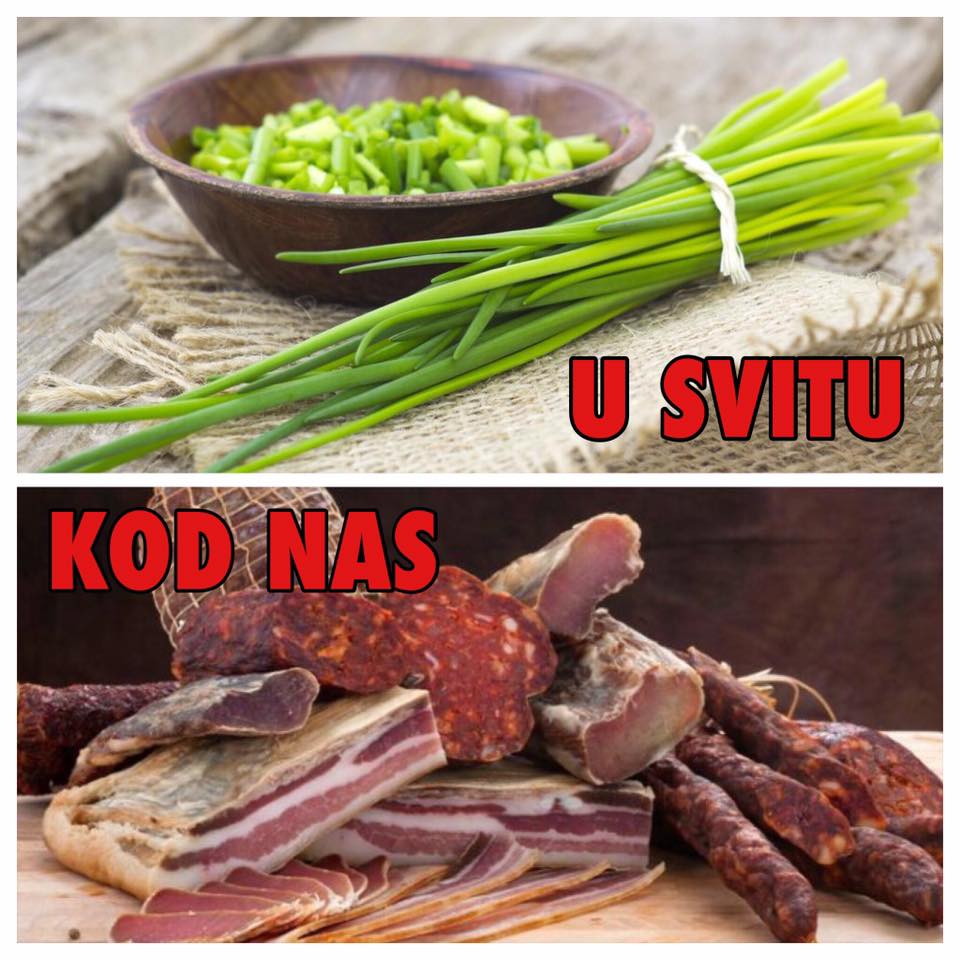
In the world vs in Croatia
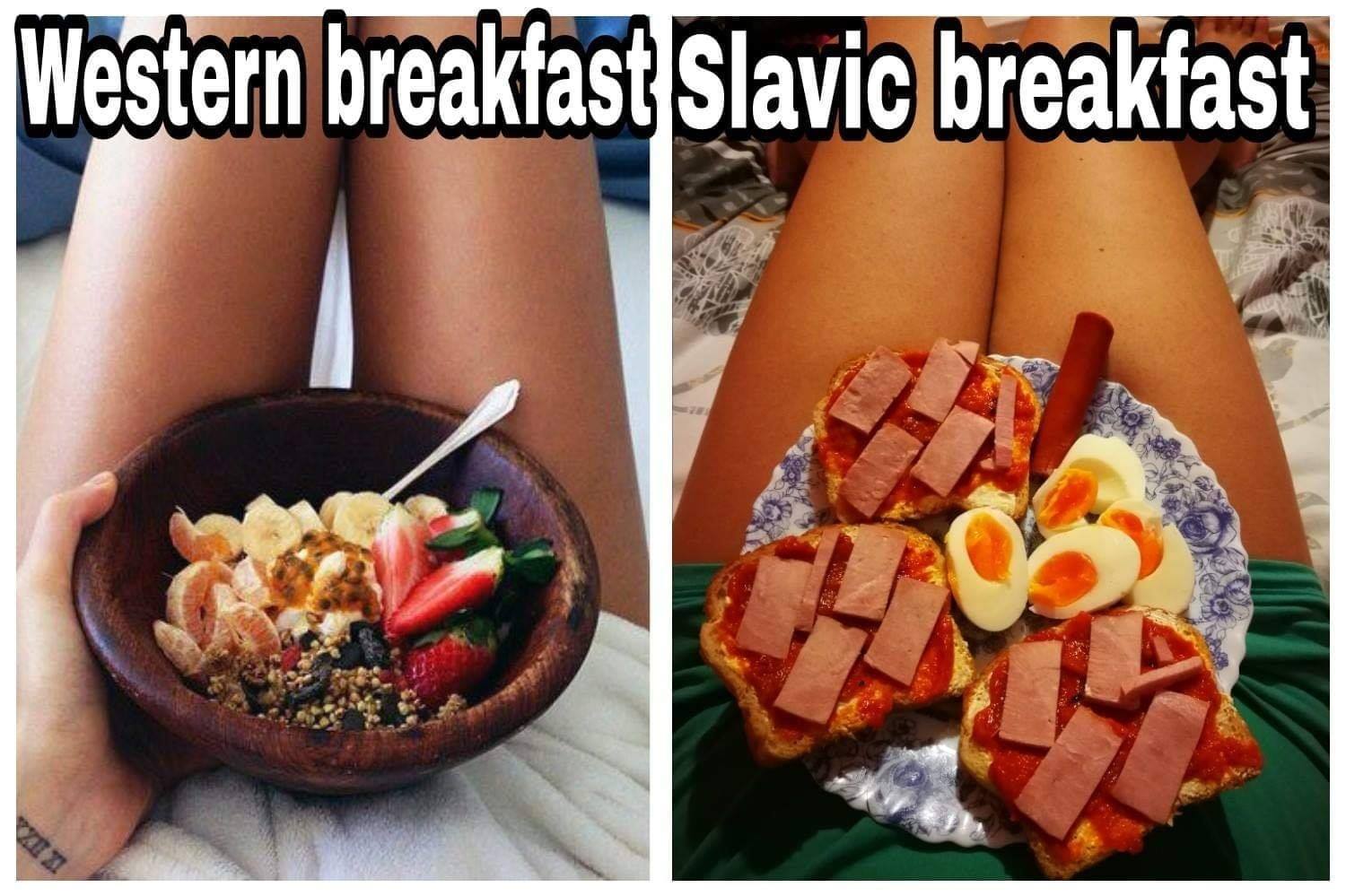


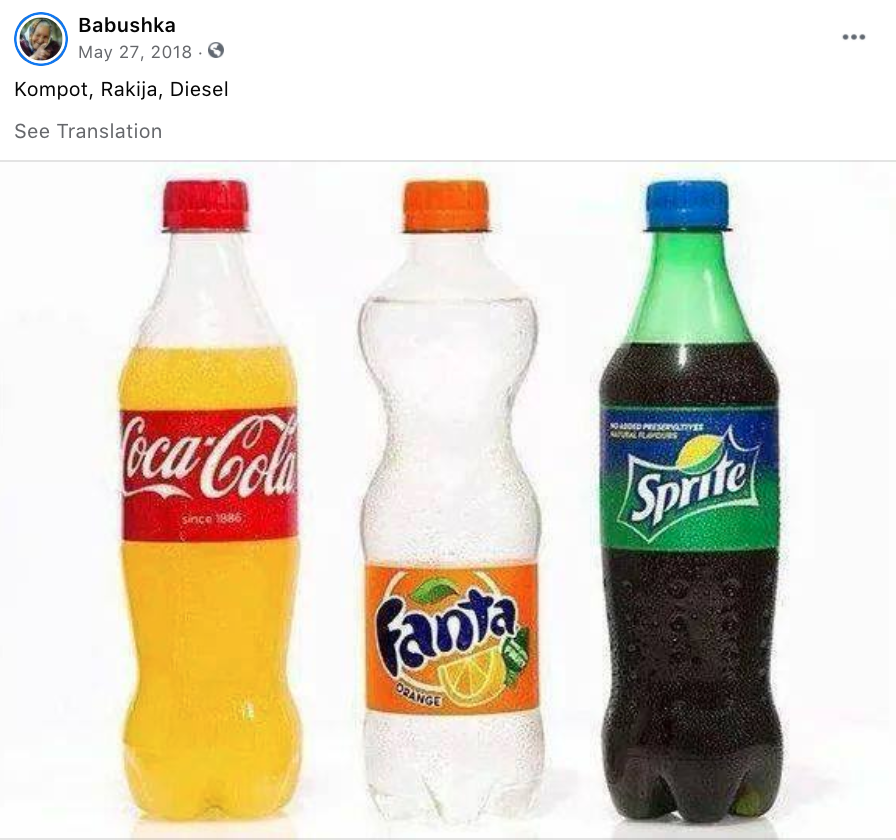

Whether you opt for sweet, savory, to something in between, breakfast in Croatia has it all.
Are there any Croatian breakfast tips and essentials we should add? Send us your info at This email address is being protected from spambots. You need JavaScript enabled to view it..
To follow the People Also Ask Google about Croatia series, click here.
People Also Ask Google: How to Get to Istria, Croatia in 2021?
February 17, 2021 – In Google's "People also ask" feature, the hard questions are the ones that start with "how." It is not always easy to find answers how to do something or how to get somewhere. However, in this article, we will try to explain how to get to Istria, the biggest and famous Croatian peninsula.
Located in the most western part of Croatia, Istria is a peninsula known for its rich cultural heritage, as well as it's delicious gastro offer that includes world's best wine, olive oil, and truffles. Last year, Istria was named world's best olive oil region for the sixth consecutive year, which is one more reason why Istria is an unavoidable place to visit when in Croatia.
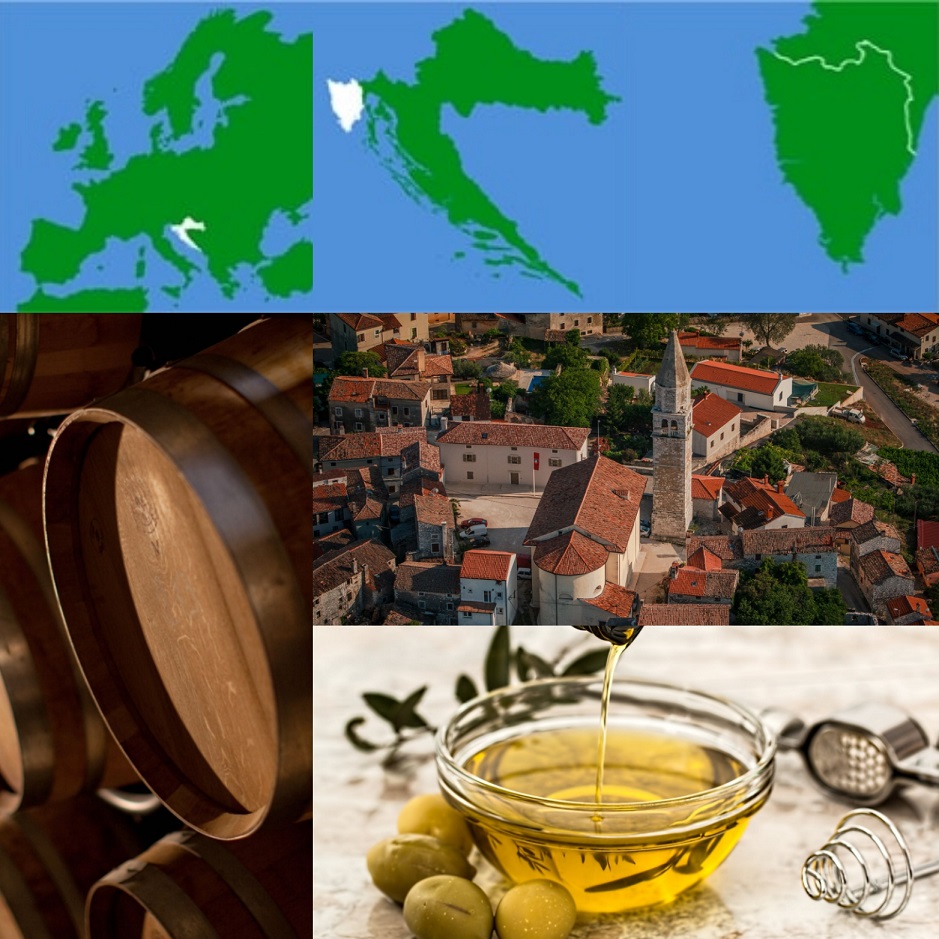
Sources: Istria.hr, Pexels, Romulić and Stojčić
We will let you explore the charms of Istria for yourself, but first, we will try to help you how to get to Istria.
How to get to Istria Croatia by car?
Istria is one of the best, if not the best traffic-connected Croatian coastal region. Thanks to its geographical position, it achieves a record number of tourist arrivals and overnight stays every year, and the cities of Poreč and Rovinj are at the very top of Croatian tourist destinations.
The largest number of tourists come to Istria by land, by personal vehicles, from the close countries of Germany, Austria, and Italy. If you're coming to Istria from those countries, or from that direction, you must pass through Slovenia.
There are four main border crossings with Croatia and Slovenia in Istria. The first ones are Plovanija and Dragonja/Kaštel, from the direction of Koper, marked in red on the photo below.
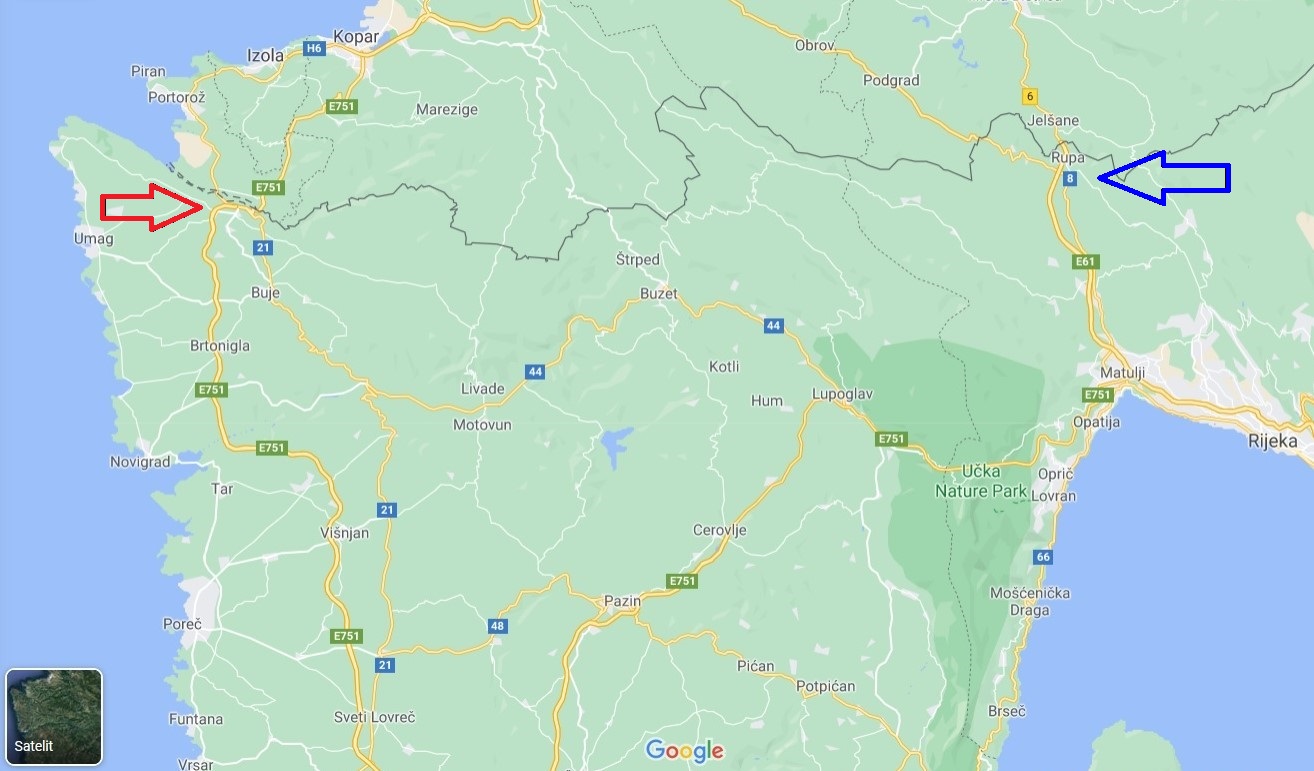
Screenshot Google Maps
The road to Plovanija goes along the Slovenian shore, and the border crossing Dragonja/Kaštel is on the road E751. After the Croatian border, that road connects with the most famous and most important road in Istria – the so-called Istrian Y, a Y-shaped highway, which connects all parts of Istria.
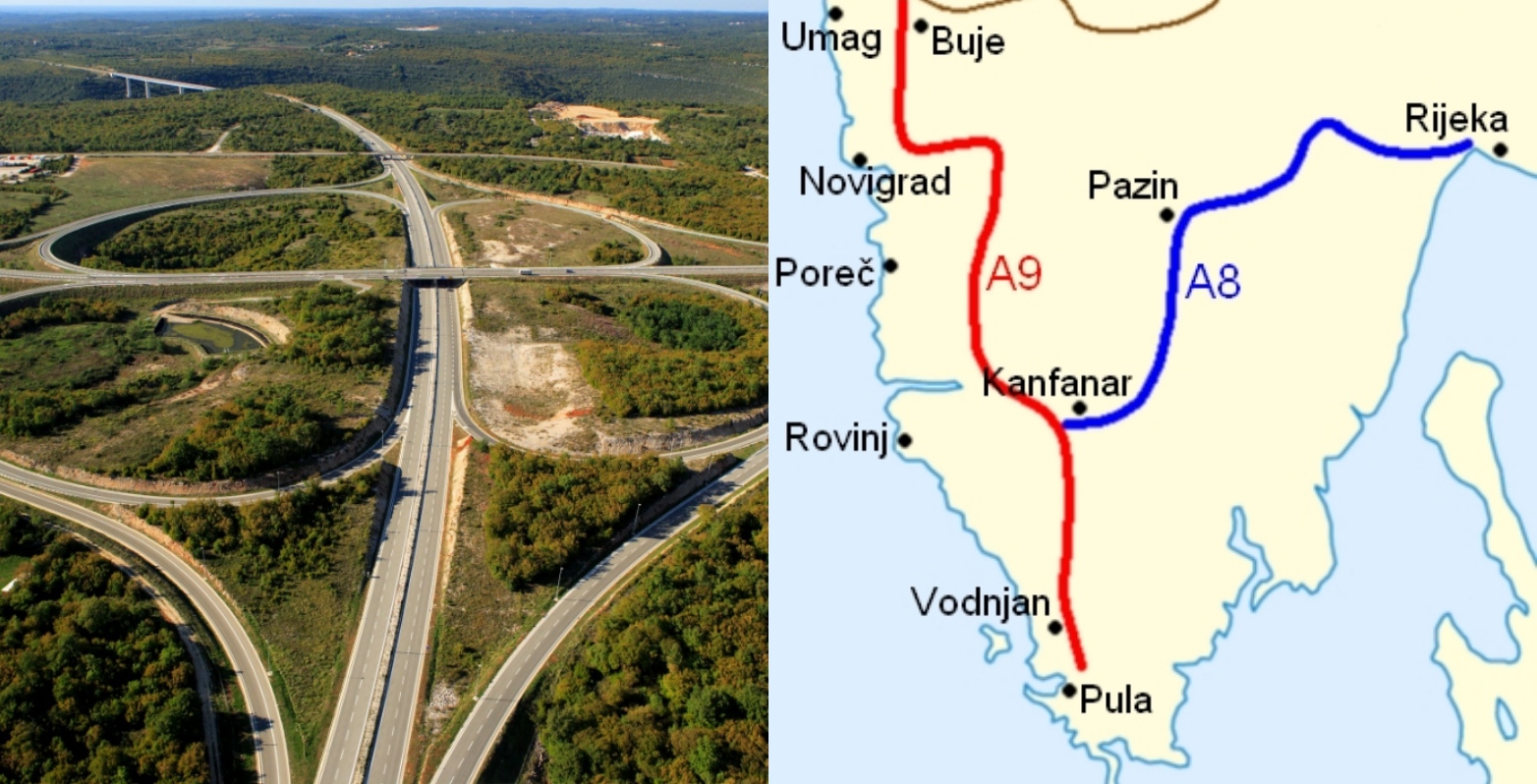
On the left: Center of Istrian Y in Kanfanar (Romulić and Stojčić) / On the right: the map of Istrian Y (Wikipedia)
That part of the Istrian Y, marked in red on the photo below, goes along the western shore, and it is a highway A9 from the Slovenian border to Pula. It connects Istrian cities of Umag, Novigrad, Poreč, Rovinj, and Pula. However, the highway itself is a little away from these cities, so you will have to turn to state roads to reach them.
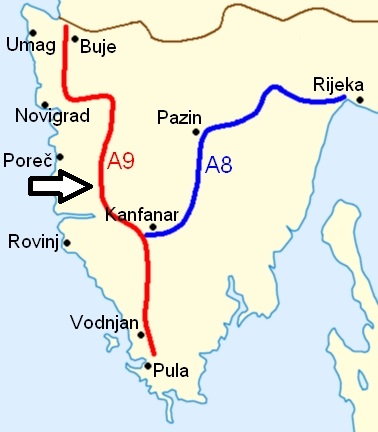
A9 highway, a part of Istrian Y, marked in red / Wikipedia
The second two important - and also the busiest - border crossings in Istria are Pasjak and Rupa, marked in blue on the first photo. Although they are located in the Primorje-Gorski Kotar County, they are a gate to Istria County.
As shown on the photo below, the highway E61 goes to Croatia via the Pasjak crossing border from the direction of Trieste in Italy. If coming from the direction of Ljubljana, you must cross the Rupa crossing border. Highway E61 (in Croatian: highway A7) from both Pasjak and Rupa end in Matulji (marked in red) near Rijeka, where it connects with the second part of Istrian Y – highway A8 that goes to Kanfanar, the center point of Istrian Y.
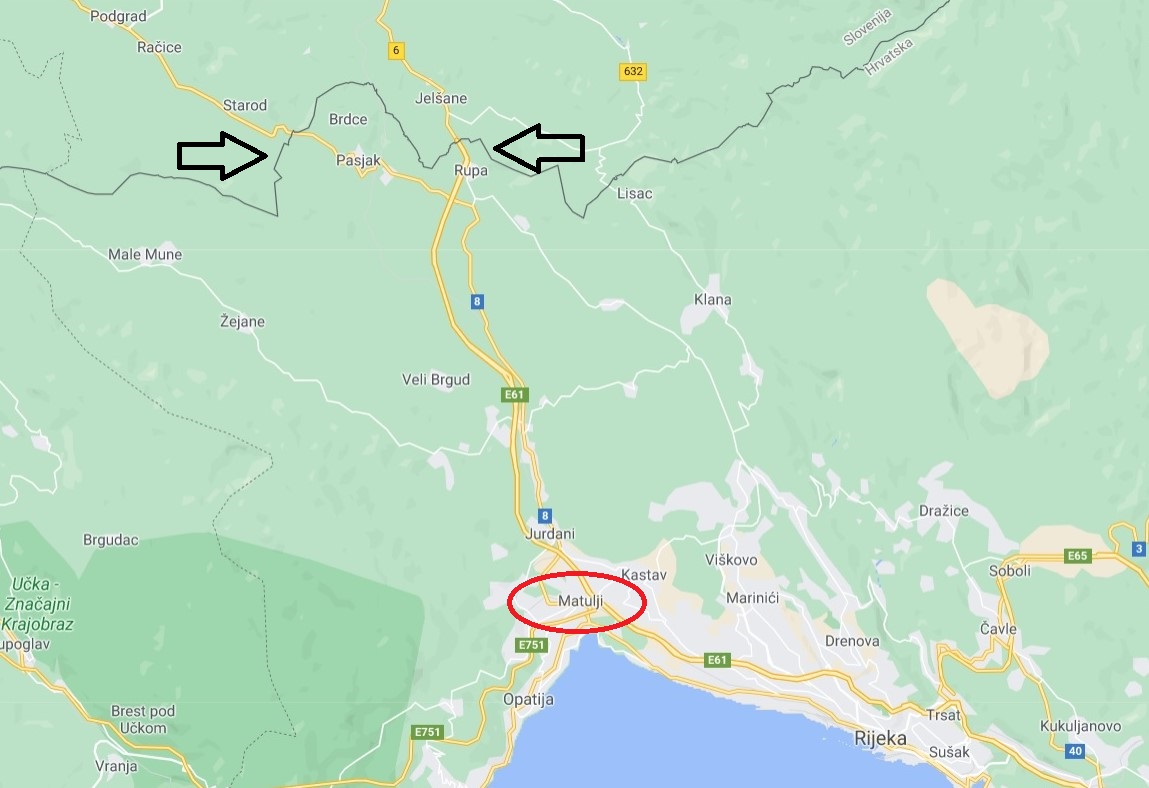
Screenshot Google Maps
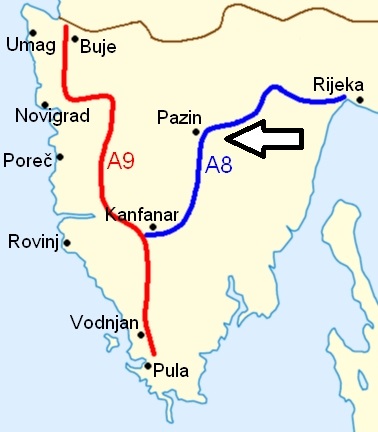
A8 highway, a another part of Istrian Y, marked in blue / Wikipedia
Remember, once you reach Istrian Y, you can reach any part of Istria. Istrian Y is actually a system of two highways, A8 and A9 – learn more about the Istrian Y.
Other Slovenian-Croatian border crossings are Bregana near Zagreb and Macelj near Krapina, from where you can go to Istria via highways E59 and E65.
How to get to Istria by plane?
The only airport in Istria is the one in Pula, while the other close airports are in Friuli Venezia Giulia Airport in Trieste, Marco Polo Airport in Venice, and Treviso Airport in Italy, Jože Pučnik Airport in Ljubljana in Slovenia (also known as Brnik Airport or Fraport Slovenia), Zagreb Franjo Tuđman Airport and Rijeka Airport in Croatia.
Pula Airport welcomes both charter and scheduled flights. Before many flights were canceled due the pandemic, Pula Airport had a solid tourist traffic. One of the most popular airline in Pula was Ryanair, offering cheap flights to some of the biggest European cities. However, the traffic in Pula Airport dropped by 89.6 percent in 2020, compared to the record 2019.

Pula Airport by Romulić and Stojčić
Airlines operating to Pula Airport in 2021 are Air Serbia, British Airways, Croatia Airlines, EasyJet, Eurowings, Finnair, Jet2.com, Lufthansa, Norwegian, Ryanair, S7 Airlines, TUI, Volotea, and Wizzair.
In 2021, it will be possible to come to Pula, Istria by flights from Belgium, Croatia, Denmark, Finland, France, Germany, Ireland, the Netherlands, Norway, Russia, Scotland, Serbia, Sweden, Switzerland, Ukraine, and the UK.
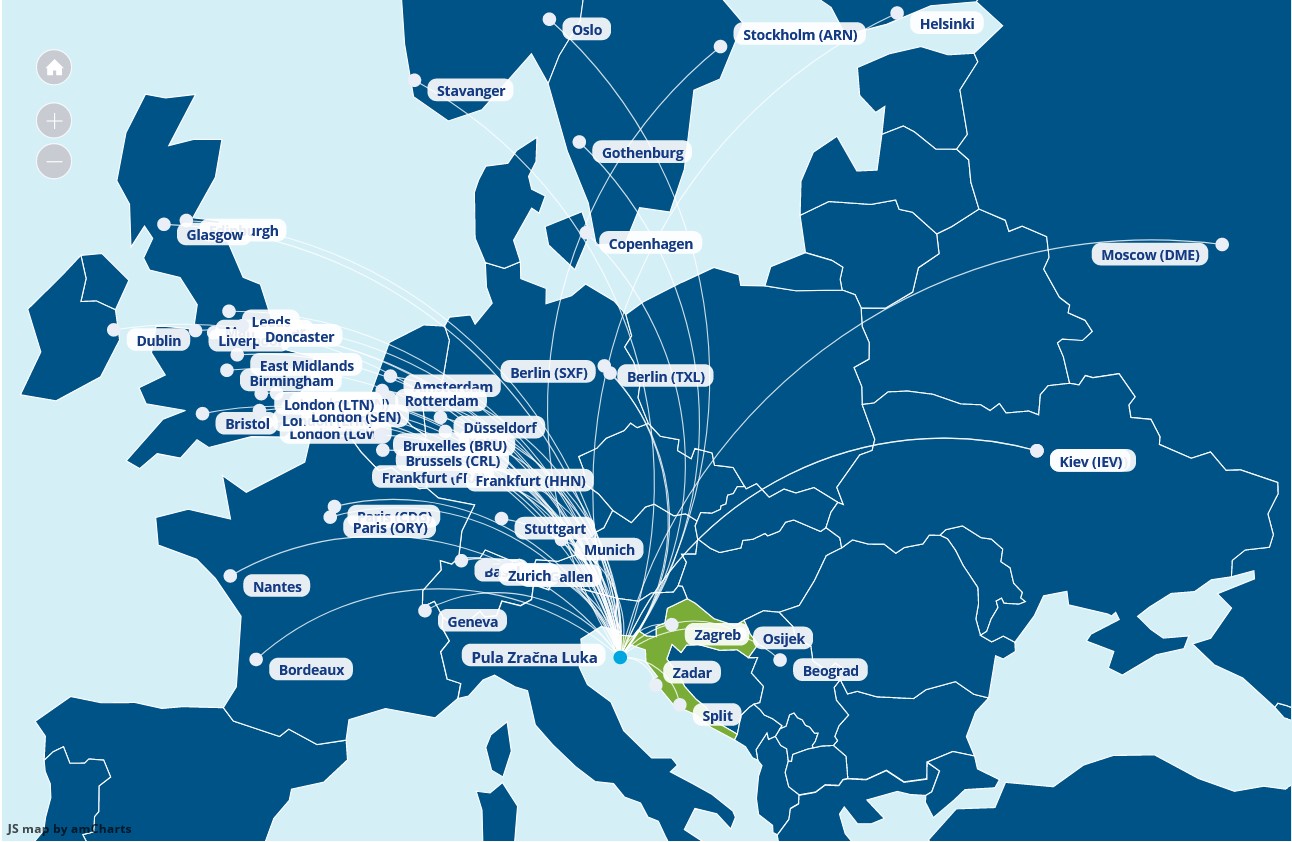
Screenshot Pula Airport
Follow TCN's dedicated page for the newest information about flights to Croatia.
How to get to Istria by bus?
If you come from neighboring countries, the bus may be a good option to get to Istria. Since northern and western Croatia is well-connected with northern Italy, you can get to Istria by bus from Trieste to Buje, Poreč, Rovinj, Pula, along with other places on the way. The bus from Trieste to the western part of Istria, as well as to Rijeka, operates throughout the year.
There are also bus lines from Venice to Pula by the Pula-based bus company FILS, operating the whole year. Another Pula-based bus company Brioni Pula provides bus services from Padova (with stops in Venice and Trieste) to Vodnjan, Rovinj, Buje, and Pula. All the bus lines from Italy to Croatia can be found here (in Croatian).
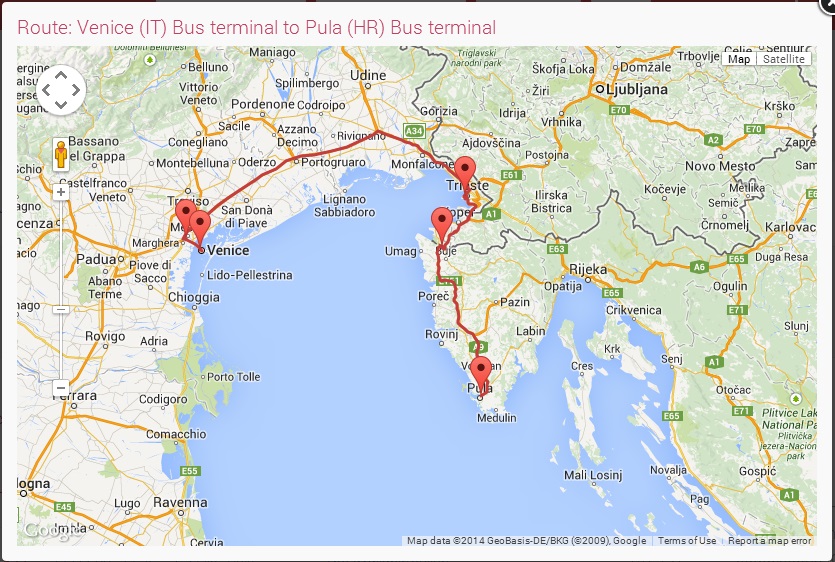
Bus routes from Venice, Italy to Pula, Croatia / Buscroatia.com
Istrian bus companies Brioni Pula i FILS also provide bus lines from many Croatian cities, mostly from the capital of Zagreb. If you're coming from continental Croatia, Istria is the closest seaside region to visit. There are many bus lines, especially during summer. You can find them also on the Flixbus and Arriva bus companies' webpages.
How to get to Istria by ferry?
Since Croatia has a sea border with Italy, one way to get to Istria from Italy is ferry. There are two ferry providers from Italy to Istria – Adriatic Lines and Venezia Lines.
Adriatic Lines operates from Venice to Istrian cities of Pula, Rovinj, Poreč, and Umag. Catamaran lines from port San Basilio in Venice to Istrian cities last about two and half hours. One-way ticket price is 65 euros (or 500 kunas) for adults and 32.50 euros (250 kunas) for children. The schedule for 2021 is still unavailable.
Adriatic Lines' catamarans are quite famous, as they are recognizable in Istrian ports. "Prince of Venice," mostly seen in Poreč port, has an attractive and distinctive design, while "Adriatic Jet" is known for its speed and interesting appearance.
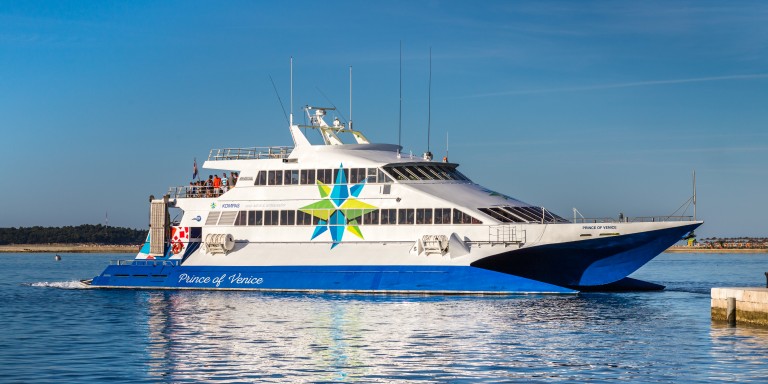
Prince of Venice in Poreč port / Adriatic Lines
During summer, namely from April to October, Venezia Lines have catamaran lines from Venice to Piran, Poreč, Pula, Rovinj, and Umag. Ticket prices range from 59 to 69 euros per person (450 to 520 kunas per person). It takes about three hours and 15-30 minutes to get in one direction, depending on the route. However, the schedule for 2021 has not yet been published.
Ferries from Istria to Italy also allow the transport of pets and bikes.
To find more ferries from Italy to Croatia, check the Istrian Sun webpage.
How to get to Istria by train?
If you decide to come to Istria by train, you can arrive very quickly using the lines from Ljubljana or Zagreb.
The line from Ljubljana can take you to Buzet or Pula every day and it takes four hours. There are no more trains going from Italy to Croatia.
If traveling from the Croatian capital, there are no direct train lines to Istria. However, you can take the train to Rijeka, but then travel by bus from Rijeka to Lupoglav, from where you can continue your train journey through Istria, to Pazin and Pula. The whole journey take four hours. You can book the train tickets on the Croatian Railways webpage.
Six railway stations in Istria are in Pula, Kanfanar (mentioned above as the center of Istrian Y), Vodnjan, Pazin, Buzet, and Lupoglav. Pula and Pazin are the main railway stations in Istria, from where you can quicky come to western Istrian cities of Poreč, Rovinj, and Novigrad.
Fun fact about travelling by train in Istria?
Did you know that Istria is home to the only island on the Adriatic coast connected by train? Its name is Uljanik and is one of the six islands in the Pula bay.
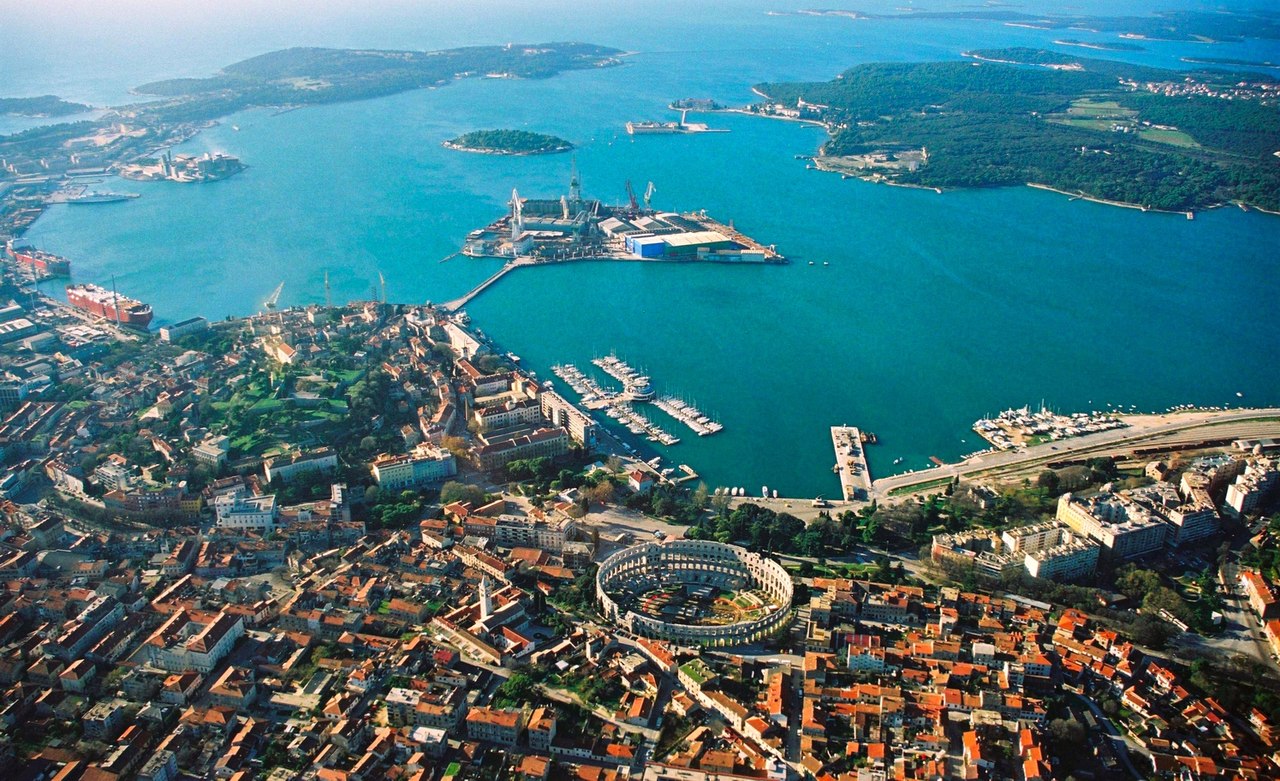
Pula and Uljanik island seen from above / Wikipedia
The name Uljanik, after which the nearby Pula shipyard was also named, comes from olive trees or, in Croatian, "ulike" that grew on it. Of all the olive trees, only one remained in the center of the island, surrounded by the Uljanik shipyard facilities, whose central plants are located on the island.
Interestingly, the industrial track for the shipyard Uljanik that goes from Pula railway station continues over the bridge, all over to the island of Uljanik. The bridge thus connects the island of Uljanik with the coast, making Uljanik the only Croatian island connected to the mainland by rail.
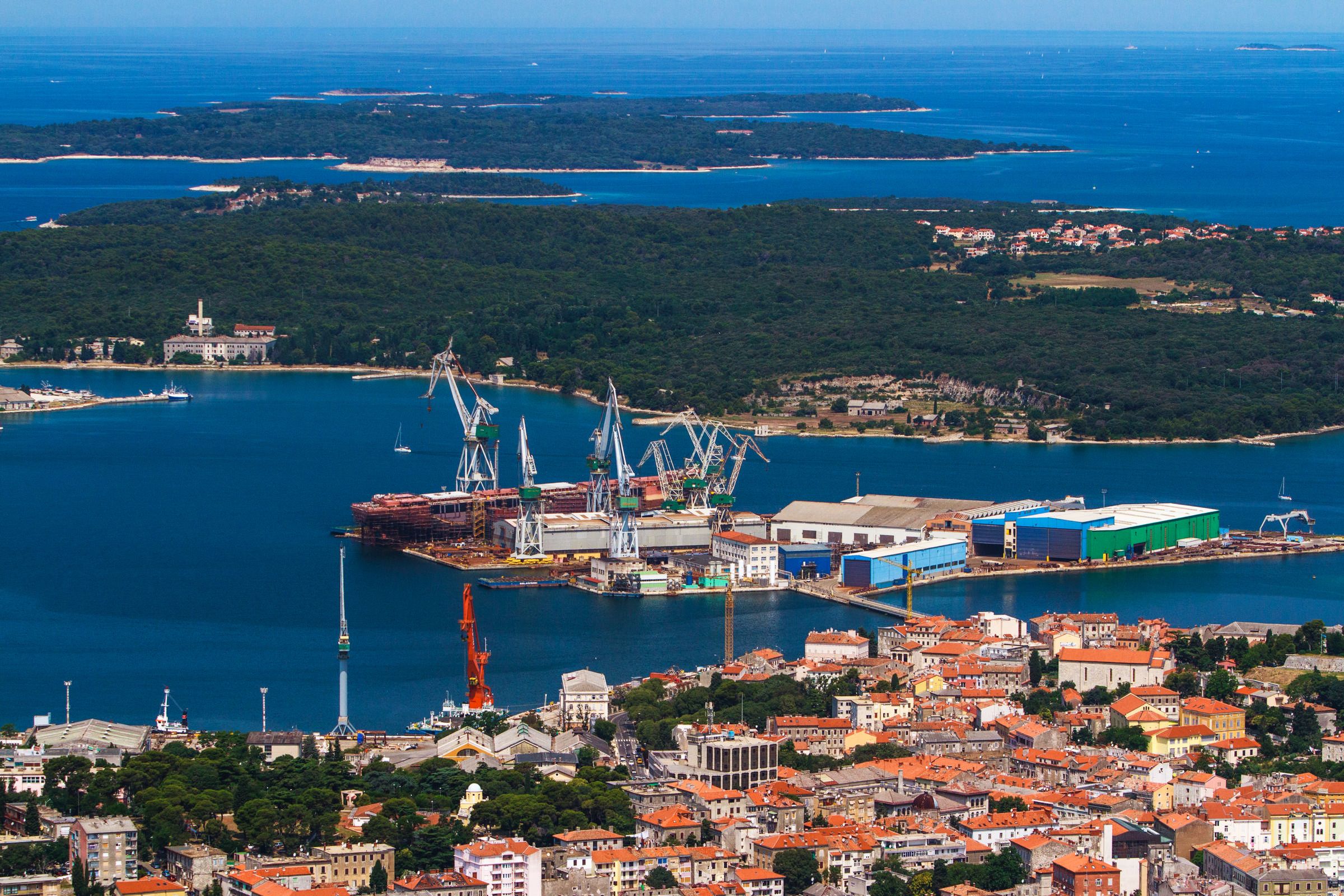
Uljanik shipyard's main plants on the island of Uljanik / Copyright Romulić and Stojčić
To follow the People Also Ask Google about Croatia series, click here.
People Also Ask Google: Why is Croatia Split in Two Parts?
February 16, 2021 - Continuing the new TCN series answering the questions posed by Google's 'People Also Ask' feature, why is Croatia split in two parts between Split and Dubrovnik?
Why is Croatia split in two?
Wait? What?!? What do you mean you have to leave the EU, enter another country and reenter the EU if you want to go between the two Croatian hotspots of Split and Dubrovnik? How can that make any sense?
And yet - for now - it is true. For many years, my shallow understanding of the reason why was that Croatia had ceded territory to Bosnia and Hercegovina in the border realignment following the breakup of former Yugoslavia and the subsequent regional war which ended in 1995. I had always thought that Neum was included in the newly independent BiH to give the country access to the sea. But it turns out that the roots of the answer to the question why is Croatia split in two lies - as many things in this region do - in history.
The Bosnian riviera - a look back in history
Dubrovnik may be one of the world's most famous cities today, either in its own right or through its Game of Thrones alter ego, Kings Landing, but it was once better known as Ragusa, the name of the Dubrovnik Republic. Though tiny, the Dubrovnik Republic punched above its weight on the world stage, becoming a major trading and diplomatic centre. And a very progressive one. Slavery was abolished in Ragusa in 1416.
Dubrovnik's misfortune/opportunity was being stuck between two great powers - Venice and the Ottoman Empire. During the Great Turkish War in the late 17th century, Dubrovnik sided with the Turks, who ended up on the losing side. At the 1699 Treaty of Karlowitz in 1699, the victorious Hapsburg Empire and Venice were given large tracts of Ottoman lands. In order to buffer itself from Venetian attack, Dubrovnik gave away a small strip of land at its northern tip. This resulted in that land (including the modern-day town of Neum) becoming part of the province of Bosnia and Hercegovina in the Ottoman provinces.
That decision centuries ago would come into play once more in 1995, as post-Yugoslav borders were finalised.
This video gives a lot more detail on the historical aspects, as well as some useful maps over the centuries.
The Neum Corridor had been born.
And it has been terrorising and panicking tourists ever since.
Driving from Split to Dubrovnik through Bosnia and Hercegovina
SO many people have contacted me in a total panic over the years when they realise that they have to leave Croatia to get from Split to Dubrovnik and vice versa. If I had a euro for every email...
In practice there is no problem at all, provided your documents are in order and you have a valid passport (Croatians can travel with the ID card). The border crossing used to be very lax, with border police often waving vehicles though without checking documents, but July 1, 2013 changed all that. On that day, Croatia joined the EU, and the Neum corridor became home to not one but two external EU borders.
Driving through Neum takes about 11 minutes. You are advised to stick to the speed limits, as the Bosnian police occasionally see an opportunity to add to the State finances from their temporary visitors.
Rental cars and the Neum corridor
Do you need insurance to cross this slither of non-EU territory. Technically yes, and you must have a green card when travelling around BiH (you can buy at the border), but in practice nobody checks. Rental cars will be covered with a green card, but make sure you double check.
Transiting Bosnia from Split to Dubrovnik in COVID-19 times
Travel advice changes daily at the moment due to the pandemic. At time of writing (Feb 16, 2021), travellers can transit Bosnia, including the Neum corridor, without the need for a PCR test. Please be advised that you have a maximum of 12 hours to enter and exit. And they DO time you. And they WILL fine you if you overstay. This shouldn't be a problem transiting Neum - the journey takes about 11 minutes.
For the latest advice, check out the TCN Daily Travel Update. If you have a question, the Total Croatia Travel INFO Viber community can help you solve it (you will need to download the Viber app).
What are the border waiting times and procedures crossing Neum from Split to Dubrovnik?
The border has been upgraded significantly due to Croatia's EU status. Passports are usually (but not always) scanned. Out of season, a wait of more than 5 minutes is rare. During the season (at least a normal season), waits can be significant - up to two hours. Not every day, but it does happen.
What is there to see and do in Neum?
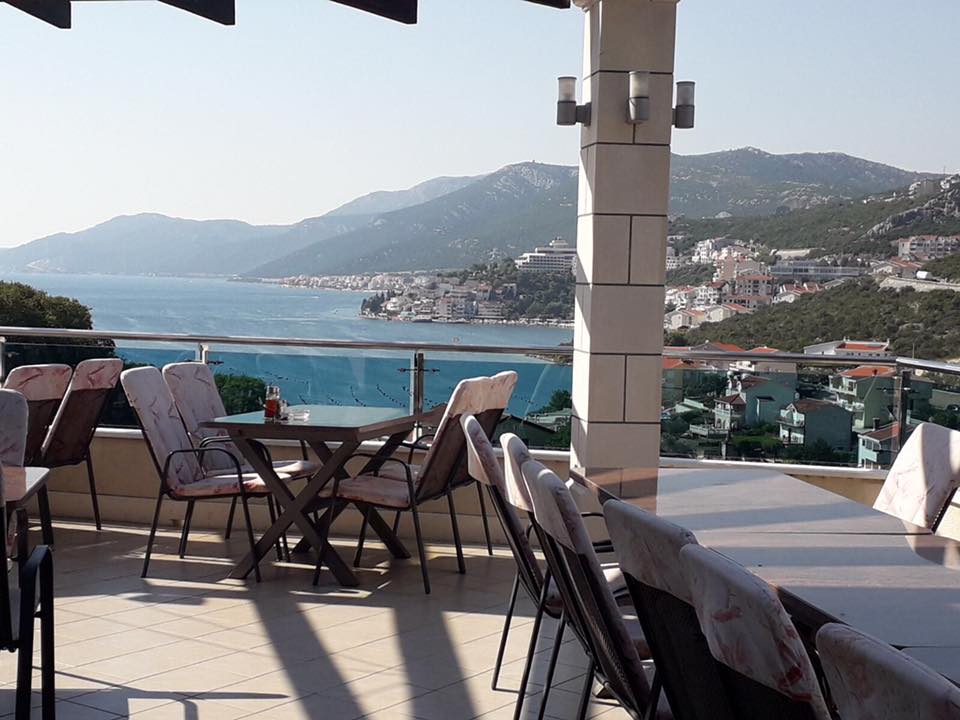
Neum represents the Bosnian Riviera, the only coast the country possesses. As such, it is not surprising that there are many apartments crammed into the small area of coast. If you are looking for a beach resort, either side in Croatia will give you a much more pleasant experience, although the prices in Neum are cheaper.
A lot of people take a break in Neum (particularly coaches), and there are several restaurants which cater to them (Orka is my one of choice - on the far side of the town from Split, on the way to Dubrovnik. You will see the mussel farms in the bay, a popular local dish.
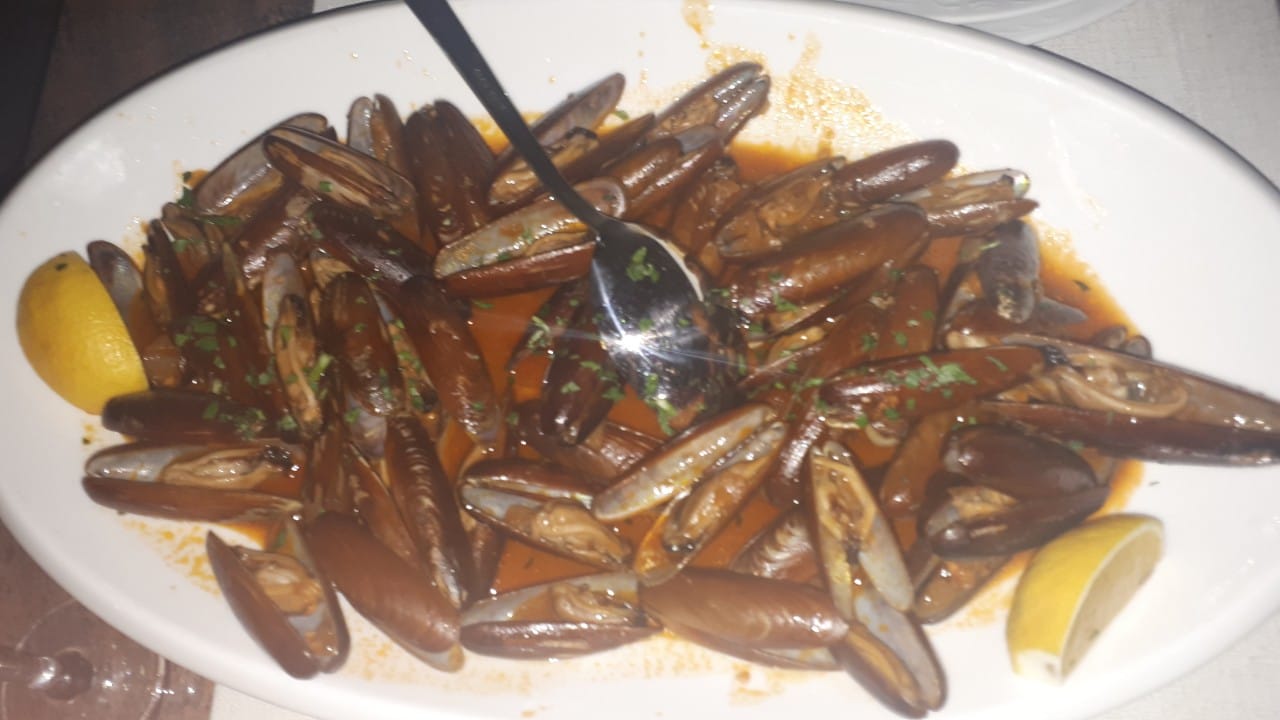
A lot of people also stop to shop. Food, drink and those beloved cigarettes are all cheaper than in Croatia, as is fuel, so a good idea to tank up.
If you have a little time, take a left on the main road at the traffic lights as you enter from Split. The historic town of Stolac is one of the most beautiful in the region and will give you a taste of the real Bosnia. It will leave you wanting more.
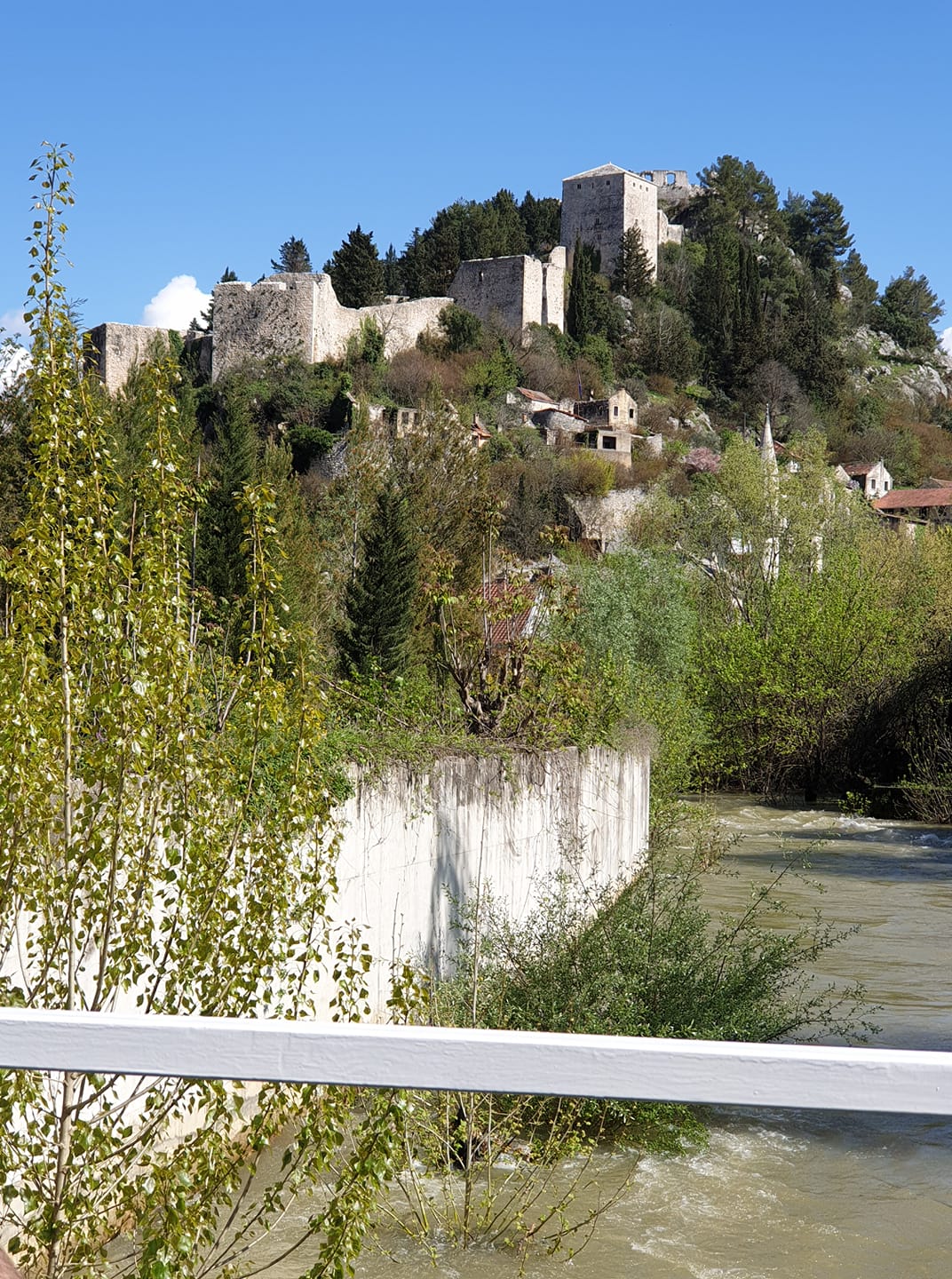
What currency is accepted when you transit the Neum corridor in Bosnia?
Pretty much anything! The town has thrived on its transit traffic for years, and every waiter seems to have various currency exchange rates programmed in his brain. I have used Bosnian Marks, Euro, kuna, US Dollars and British pounds over the years. The exchange rate of the mark is tied to the euro - one euro buys you about 1.95 KM (convertible marks, as they are known from their prior relationship with the Deutschemark).
Crossing the border from Croatia to Bosnia to Croatia - what about EU and Schengen?
Tourists are often very confused about Croatia's status regarding the EU, Schengen and border crossings. Croatia IS in the EU, but it is NOT YET in Schengen. It is scheduled to enter 'soon' (my favourite unit of time in this beautiful region - you can check the latest in this TCN section).
So if you are passing through Bosnia from Croatia to reenter the country, you have no Schengen issues. You will be leaving and reentering the EU, but in practice, you will be treated as a transit passenger.
Is it possible to go from Split to Dubrovnik without leaving Croatia?
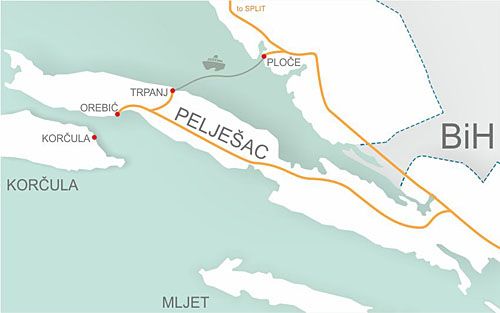
(Credit Dubrovnik Online Travel Guide)
Yes. And soon it will be even easier.
Currently, you can go from Split to Ploce. There is a short regular ferry to Trpanj on the Peljesac peninsula (home of the best Plavac Mali vineyards). At Trpnaj, turn right for the island of Korcula, or turn left and drive through the peninsula to the mainland on the other side of Neum, stopping as you must at Mali Ston, for some of the best oysters in the world.
But this trip is about to get a lot quicker.
The Peljesac Bridge - what is it and why will it change everything?
Some 30 years after it got independence, some people wonder why is Croatia split in two. it will not be for much longer. One of the key infrastructure projects for the last 30 years has been the construction of the so-called Peljesac Bridge, a 2.4 kilometre bridge which will connect the Croatian mainland on the Split side to the Peljesac peninsula, connecting both parts of Croatia for the first time.
The project has been dogged with problems over the years, and it has been something of a political football over the years. BiH objected because it would restrict access to Neum for certain types of shipping, it was claimed. In reality, the bridge will unite the two parts of Croatia and probably change the economy of Neum considerably, as there will be no need to cross the two borders.
Interestingly, several locals in Croatia have told me that they will continue to use the Neum route, as it will be quicker with less traffic, and those cigarettes ARE cheaper. I think I will too - I am quite fond of Orka restaurant, for nostalgic reasons.
When will the Peljesac Bridge be Finished?
How long is a piece of string? The project started back in (I think) 2007, but Chinese contractors were awarded the job a few years ago, and progress has been swift. The latest information is that the middle of 2022 will be the time when Croatia is finally united into one entity. You can follow the latest in this TCN section.
How is construction progress on the Peljesac Bridge?
Judge for yourself - the situation on February 15, 2021, with accompanying explanatory article.
Are there many other countries which are split in two?
Oh yes.
And quite a few, including some famous ones as Alaskans will tell you. Some strange ones such as the Kaliningrad enclave of Russia on the Polish Baltic. And Nackchivan, sandwiched between Iran and Armenia, is not ideally located for access from the rest of Azerbaijan. You can see more non-contiguous countries here.
Does Bosnia have the shortest coastline in the world?
Almost, apparently. Its 20 precious kilometres is beaten only by the 4.2 km of Monaco for shortness.
Does Croatia have any other strange border issues?
Oh, boy, does it ever. Enough for another complete article - one like this perhaps... Overview of Croatia’s Border Disputes with BiH, Montenegro, Serbia, Slovenia, Liberland. The article was written in 2017, and there may have been some slight developments, particularly with the arbitration in Piran with Slovenia.
Looking for more answers in our People Also Ask Google series? You can find them all here.


